

Road Trips and Car Travel With Cats
Author: LeeAnna Buis, CFTBS, FFCP
Published: April 17, 2024
Our mission is to help save dogs' and cats’ lives through our educational content. To support our efforts, this page may contain affiliate links . We earn a commission for qualifying purchases – at no cost to you.
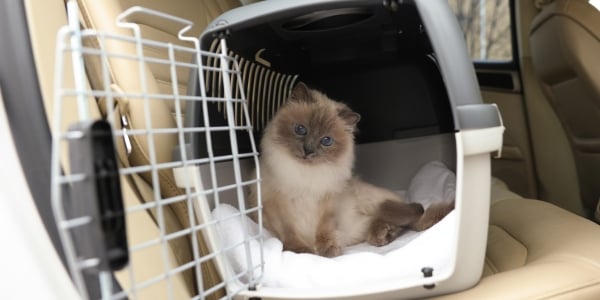
During the summer months and around the holidays, many of us head out on road trips and consider taking our feline family members along.
Summer is also a peak time for relocating across town or across country.
The problem is that most cats don’t feel safe in the car. They may cry or yowl, hide in their carrier, and even soil due to fear. That means an unpleasant trip for them and you.
It is possible to help your cat feel more secure in the car. Some may even learn to love it. We’re going to walk you through the steps to desensitize your cat to being in the car.
We’ll also recommend travel items to bring in the car and for a hotel stay so that you both have a safe and comfortable trip.
Skip to section:
- How to get your cat comfortable with car travel
- How to use a litter box when you travel – and will your cat use it?
- Where to stay when traveling with your cat and what to consider
- Special travel considerations for sick cats
- Be prepared for emergencies while traveling
Getting Your Cat Ready for a Road Trip
Step 1: get your kitty feeling comfortable in their carrier..
If they're going to ride in the car, like you, they’ll need to be safely “buckled up” to protect not just them but everyone in the car and on the road.
After all, unrestrained cats can be a distraction, interfering with your ability to steer or brake, and even become a dangerous projectile in the event of a crash or sudden stop.
What if your cat is wearing a harness and leash? If the car is moving, I still say keep them secure in a carrier. If you want to let them stretch their legs on the harness and leash while the car is stopped and windows are up, go for it. Just keep in mind that you’ve got to get them back in the carrier when you start moving again, and they may not love that.
It could be less stressful for everyone to stick with the carrier in the car and try the harness and leash INSIDE your hotel or destination. More on the dangers of letting your cat out of the car on their harness and leash later in the article.
So, your first step starts well before your trip. Spend some time training your cat to love their carrier – we have an article on that process – before the big travel day arrives.
Don't have a carrier for your cat yet? Check out our carrier recommendations, including carriers that are crash-test certified . If your cat is going to be spending a lot of long hours in the car, you may opt for a larger carrier than normal. We cover that, too. Just keep in mind you’ll want that carrier sooner rather than later, so you can use it during the pre-travel training.
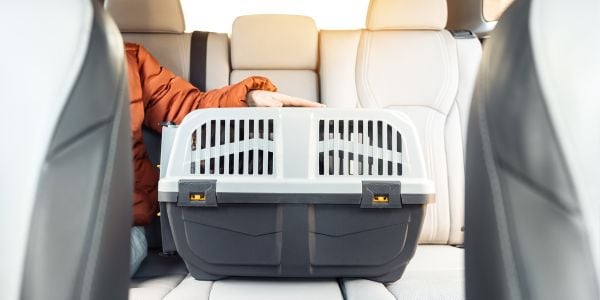
Step 2: Get your cat feeling comfortable in the car.
Now that your kitty feels better in their carrier, it’s time to help them feel comfortable in the car. Here are some steps to help you do that.
Pro Tip: Car acclimation is best done with two people … one to drive the car, the other to pet, praise, and treat kitty. It can be done with one person, too, but very carefully.
You’re going to do short sessions in the car – your cat dictates how long the sessions will be. The number of sessions depends on how quickly your cat gets comfortable. The main thing is that you don’t want to push your cat past their comfort zone. Your cat should always be calm.
You might be thinking that even if your cat is scared, leaving them in the car in spite of their fear will eventually show them they don’t have to be afraid. Nope! That’s not how cat brains work. Instead, think of it as starting at a really low intensity so your cat doesn’t have to be scared. As they’re ready, you slowly turn up the intensity.
If you turn it up too far and they get nervous, just end the session and lower the intensity for the next session.
Show them there’s no reason to be afraid because you’re not going to push them too far. And they’re getting good things through the entire process, so you’re actually turning a scary thing into a positive thing.
Take your cat out to the car in their carrier – covered on three sides with a towel or blanket for security.
With the car parked and not running and the doors and windows closed (weather permitting), sit in the back seat with your cat in their carrier. Partially open one of the carrier doors if you can do so without your cat trying to get out.
Then, make good things happen. Give treats (make sure it's a treat they love ), pets, praise, and show them this is a positive experience. Do this for just a few minutes (or longer if your cat is really enjoying it). Then, take them inside and end with treats and love. You’ll continue these sessions, gradually making them longer as your cat is comfortable, until your cat seems nice and calm, spending time in the car while in their carrier.
Next, you’ll turn up the intensity a bit by starting the car. Make sure the radio is off or very low (cats find classical music calming). And repeat the previous step.
Spend a few minutes in the back seat making good things happen for your cat while the car is running. If the engine really scares them, keep it short — just 1 minute with some treats. Again, you can gradually increase the length of time your cat is in the car, getting good things while the engine is on.
Caution: If your car is parked in your garage, either open your garage door or move your car out of the garage. Carbon monoxide is very dangerous for both of you!
Once your kitty is doing well with the car on, it’s time to turn the intensity up again. Time for a short drive.
Note: If they’re too nervous to eat treats, they’re probably not ready for this step. Back it up and spend more time on the previous steps.
It may just be pulling out of the driveway in the first couple of sessions. That’s just fine. You’ll work up to longer drives. And your cat will learn that being in the car doesn’t mean going to the vet. Never push these drives further than your cat is comfortable with. Also, be sure to drive calmly and go easy on the gas pedal and brakes.
Since each cat and each situation are different, it could take anywhere from a few sessions to several months for a cat to feel calm during car travel.
Car Travel Logistics With Cats
Will a cat use a litter box in a car.
Jumping right down to “business,” … depending on the duration of your travel adventures with kitty and where you’re winding up, you’re going to have to deal with litter box accommodations. This is the case both when you’re on the road and when you get to your hotel or destination.
Just because you give your cat access to a box doesn’t mean they’ll use it, especially if they’re nervous.
Cats don’t like to eliminate when they feel unsafe. They'll likely choose to do their business once you get to your destination. It’s nothing to worry about unless they go more than about 24 hours without peeing. At that point, call your vet and see what they suggest.
When I moved with my cats, and we had 8-hour days in the car, they held it all day and most of the night.
If they’re willing, you can help your cat take care of business on the road in a few different ways.
First, get them a good travel litter box. You’ll use the same litter they use at home, and (perhaps) even a litter attractant.
A good travel litter box will be large enough for your cat to fit in yet small enough to fit in their carrier. It will also be waterproof and sturdy. You can use a small plastic litter box or there are also disposable litter box options available.
We have travel litter box and large carrier recommendations here .
Set the travel box up in your home as an alternate option before your trip so your cat can get used to it. Don’t replace your regular boxes with the travel box, though. Have all options available.

If Your Carrier Can't Fit a Litter Box
Letting your cat out of a carrier to use a box placed in the car isn’t ideal. I actually rescued a kitten from the roadside once without a carrier. That kitten ended up inside my dashboard. So, if you think your cat can’t hide in dangerous places within the confines of your car, you’re wrong.
If your trip isn’t too long and their carrier isn’t large enough to fit a litter box, you can go with a larger litter box that they can use at the hotel or destination.
Note: If your cat uses the smaller travel litter box on the road, don’t consider replacing your larger boxes at home. Tiny boxes are not ideal and don’t fit your cat’s instinctual needs. They’re not a good long-term option. They’re the lesser of two evils when you’re traveling — the other evil being your cat peeing in the carrier.
Should You Let Your Cat Go Outside?
My vote is no unless you have a cat who is completely comfortable with travel, being in new places, and seeing and hearing strange people, pets, and sounds.
The first concern is that no harness is 100% escape-proof. If your cat gets scared, they can and will get out of that harness and take off.
Second, they’re going to be surrounded by newness — smells, sights, sounds, things you can’t control. Even if they don’t get scared, the idea that you’ll be able to get them to focus on peeing at that moment isn’t very likely. Cats don’t pee and poop on cue the way dogs can. It’s safer to keep them in the car.
What Do You Do With Your Cat When You Have to Go?
If the temperatures aren’t too hot or cold to leave your cat in the car, just leave them in their carrier and go about your business. Just make it quick!
Cover three sides of the carrier so they feel more secure and are less of a target for theft. Use a light cover (blanket) for warm days and a heavier cover for cooler days. Both should still allow for airflow.
It's usually safe between about 40–65 degrees F (4–18 degrees C), though every cat and every situation will be different, so use this as a rough guide.
Talk to your vet about more specific safe temperature ranges for your cat based their age, breed, and any chronic medical conditions they may have or medications they may be on. If the temperatures are outside of that range, you’re going to have to take some precautions when making your own pit stops that take you away from your car.
In some cases, it may be possible for you to bring your cat into the bathroom with you in their carrier.
Quick tips if you must leave your cat in the car
- Some cars now have pet mode , like Telsa, Chevrolet Bolt, Rivian, and other Form and BMW models. Caution: If you decide to leave your engine running in a gas-powered car, be aware that car engines and air conditioner compressors can and do fail, leading to excessively hot temperatures building up in the car quickly. Similar malfunctions can happen in EV cars, too, and if the battery dies, the cooling system will shut off.
- If leaving your car and running the A/C or heat isn’t possible or practical, pre-cool or pre-heat your car the best you can by running the system on high for several minutes before you get out. Then, be quick!
- Move their carrier from the back seat to the back floor. Since hot air rises, it should be a bit cooler on the floor. There are fans made for keeping pets cool in the car , but we really can't overstate this: pets should never be left in a closed car, even in the shade or with cooling devices. In this case, it's simply for a quick amount of time.
- Park in the most well-shaded spot you can find.
- Park with your front windshield facing the sun and put up a reflective windshield sun shade like this one .
- Cracking the windows doesn’t make a huge difference, but it also doesn’t hurt (so long as your cat is securely in their carrier and there’s no danger of someone reaching into your car and stealing them and your stuff).
- Make sure you leave your cat plenty of water.
- If it's cold outside, add a warm blanket or fleece to your cat's carrier for them to snuggle up. If it's sunny, move the carrier to a sunny spot in the car.
- Be as quick with your stop as possible. If it’s a food break, get it to go from a drive-thru and eat it in your car.

Where to Stay When Traveling With Your Cat
Road trips and long-distance moves with cats will often require hotel stays. But not all hotels, motels, or rentals are pet-friendly. And just because they say they’re “pet” friendly doesn’t mean they’re “cat” friendly. So, plan ahead. Call to confirm they take cats and reserve the room or rental in advance.
Pro Tip: “Pet-friendly” means other pets likely stayed in that room recently! Not everyone uses flea and other parasite protection on their cats and dogs. Make sure your cat is protected before heading out on the road! Learn more about safe and effective parasite prevention for your cat , and talk to your veterinarian.
What to Do With Your Cat in the Hotel or Rental
Once you’re out of the car, you’re faced with a question. Do you let your cat out in the hotel or rental to explore, or do you keep them confined? There’s a lot that goes into the answer. Here are some things to consider:
Is your cat relaxed in new places? Being in their carrier in the car is different than being in a completely new room with smells and places to hide.
Does your cat chew, climb, or otherwise destroy things? I couldn’t let my cat into a new space without putting cord protectors on every cord, or they’d be chewed in a matter of minutes.
Are there hiding places you can’t get to or unsafe spaces your cat can reach? The last thing you want is your cat stuck in the vents of a hotel or squeezing through that tiny hole in the wall behind the fridge in your rental. It happens.
Is it clean? Not to get gross, but you may not want your cat rolling around on a motel floor or getting under the bed.
Is it safe from toxins? There could be rodent traps or pest poison in the room that could be dangerous for your cat.
Is there any chance they’re going to pee on something? Yep, it happened to me on my road trip. My cat was stressed and peed all over the fabric carrier, and it soaked through to the bed. Talk about embarrassing. And there's sometimes an additional cleaning fee for mishaps like this.

Confinement for Safety
I like the idea of bringing along a much larger, collapsible pet pen for overnight use. They’re plenty big enough for a good-sized litter box and everything your cat needs. There’s even room to play. Just make sure you get one with a top, or your cat will jump right out.
If you want to let your cat out on a harness and leash or heavily supervised, you have the option. But you’ve got the pet pen as a backup just in case you need it. You never know how a cat is going to react in a new space, especially when you’re sleeping or in the shower and they’re unsupervised. Here are a few great options:
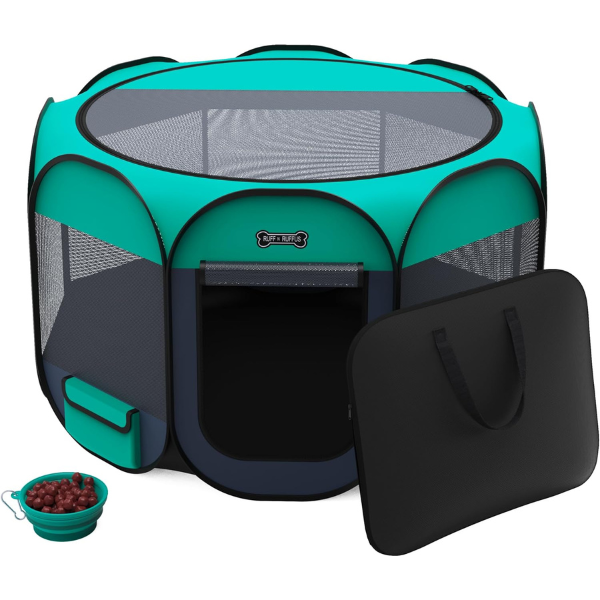
Available at:
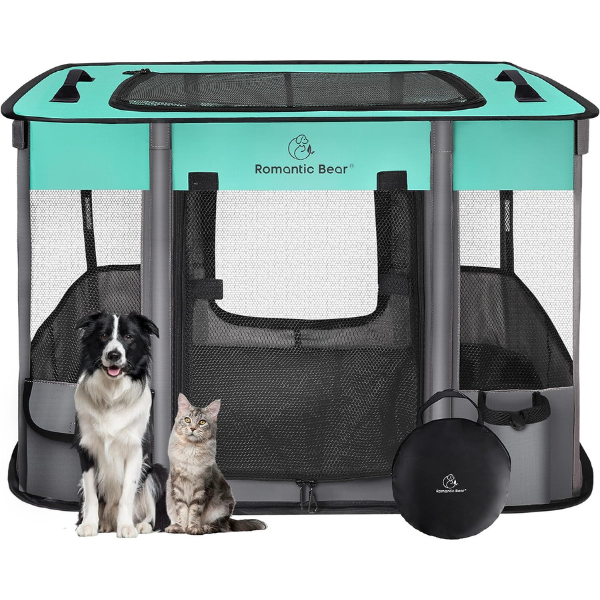
Travel Considerations for Cats With Chronic Health Issues
Before striking out on the road for a long trip or moving with a cat who has a chronic medical condition or is on long-term medications — like diabetes , hyperthyroidism , chronic kidney disease , or heart disease — there are a few precautions you should take.
- Make sure your cat had a recent (ideally within the past month or so) exam with their vet. You’ll have more peace of mind knowing that their condition is as well managed as possible and that they’re as healthy as can be before hitting the road with them. Your vet will also have recommendations for making their trip as comfortable and safe as possible.
- Bring a copy of your cat’s medical records with you! This should include recent exam notes, laboratory test results, and medication/supplement names and dosages. Your vet can often print these out (with enough notice), and they may even subscribe to an app or other service that allows you to keep updated copies of such records with you always on your phone. This will make visiting another vet on the road much easier.
- Especially for cats with known chronic health concerns, it’s a good idea to know about a few vet hospitals along your route and in the area of your destination before you head out. See the vet locator tools listed in the next emergency section to start searching.
- If your cat is on a special prescription diet, like for their kidneys, make sure to stock up on it from your vet before leaving. It’s not always easy to get prescription diet refills when you’re away from home. You should take enough with you to last for the duration of your trip PLUS an additional (at least) 2 weeks.
- Similarly, be sure to stock up on your pet’s medications and supplements, as well as any supplies you need for them. This would include needles and a travel-sized sharps container (or larger needle container ) for safely disposing of and storing used needles for diabetic cats, pills for blood pressure, overactive thyroid, and any other chronic medications. Again, you should take with you enough to last for the duration of your trip PLUS an additional (at least) 2 weeks.
- If your cat is diabetic and on insulin, don’t forget a cooler and ice packs to help keep it cool while in the car. You can also look into a cooler that plugs into your car’s cigarette lighter or USB, like these: Cooluli Mini , Wagan 14L , or the Wagan 24L (which could even store some of your food and drinks for the road). Pro Tip: Depending on the type of insulin your cat is on, you may be able to get an insulin “pen” that may be more stable outside of the fridge and easier to administer to your cat. It's still advisable to use a cooling case for the pens . Talk to your vet to see if an insulin pen is an option for your cat — it isn’t for all cats, but if it is for yours, it could be a great travel (and even long-term) solution for you.
Emergencies on the Road With Your Cat
It’s a good idea to plan ahead and map out a few 24-hour Emergency Clinics on your route, just in case. Try this vet emergency locator .
Have your hometown veterinary clinic number handy, too. For less serious issues, call them first. They may be able to give you advice or let you know if it’s a true emergency.
Make sure you have a card in your wallet or attached to your cat’s carrier with your cat’s name, the number where you can be reached during travel, and an emergency contact who is not traveling with you. If your cat has medical issues, you should list those as well or the contact info for your veterinary clinic. If there’s an accident, your car is stolen, or something happens where you’re separated from your cat, emergency services will have options.
I just got this great set for myself (featured below). The keychain says “pet home alone,” with instructions to look in your wallet for a card with emergency contact info. It’s meant to notify emergency services if you’re in an emergency situation and someone needs to care for your pet at home. In this case, you’d just include a note on the card that you’re traveling with your cat in the car.
It’s also vital to ensure your cat is microchipped and the contact information is up-to-date (including a way you can be reached on the road).
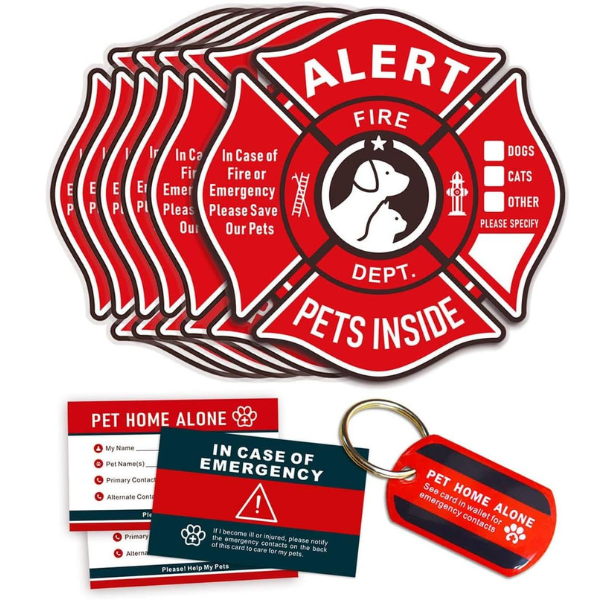
First Aid on the Road
Consider putting together a pet first-aid kit for your car. Here's a shopping list of first-aid essentials . Look for the icon of a little car 🚗, as it's these products that are the most essential in a smaller, travel-sized first-aid kit.
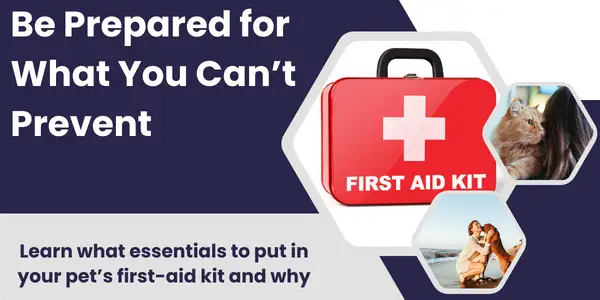
We encourage you to leave a comment below if you’ve got any tricks, tips, or products you’ve used that made car travel with your cats easier. Best of luck on your travels or your move. Have fun and be safe!
About the author

LeeAnna Buis, CFTBS, FFCP
LeeAnna Buis has adored cats her entire life and thought she knew them inside-out and sideways. But it wasn’t until she worked with a feline behavior consultant that she fully understood how incredible, complicated, and inspiring cats really are. Literally, that day, she made a career change knowing she wanted to give other cat parents the same experience of truly “seeing” and appreciating their cats. Now, she works virtually with cat parents all over the world through Feline Behavior Solutions and Preventive Vet.
LeeAnna earned her certification through Animal Behavior Institute, earning the CFTBS designation. She is a certified Fear Free® trainer (FFCP), a training professional member of the Pet Professional Guild (PPG), and a member of both the International Association of Animal Behavior Consultants (IAABC) and Cat Writer’s Association (CWA).
More about LeeAnna Buis, CFTBS, FFCP
Related Articles

8 Tips to Help Cats Enjoy Car Travel
:max_bytes(150000):strip_icc():format(webp)/Amy_Seren-56a110b53df78cafdaa8fcd9.jpg)
Sarah Scott is a fact checker with more than 16 years of experience in researching, writing, and editing digital and print media. She has verified and edited articles on a variety of subjects for The Spruce Pets, including pet behavior, health, and care as well as the latest trends in products for animals in the home.
:max_bytes(150000):strip_icc():format(webp)/_DSC3035-ac077953e8f34fe4937c796a7a00cf80.jpeg)
Cats can't imagine something that's never happened to them before. Instead, they remember past experiences and believe the same thing will happen again. Because a puppy or kitten's first car trips aren't always that pleasant, some pets dread traveling.
Instead, help cats associate cars with fun, happy experiences instead of just trips to the vet. The process, called desensitization using classical conditioning , takes patience and time but works whether your kitty acts scared , sick, or hyper. Use positive reinforcement, and once he realizes a car ride means wonderful things for him, he'll look forward to every trip.
8 Tips for Cat Car Travel
- For safety's sake, it is recommended that kittens and cats ride inside a carrier while in the car. A loose pet becomes a furry projectile in case of an accident. The driver needs to concentrate on the road and traffic, not the baby on your lap or under the pedals. Even well-behaved cats loose in the car could be injured, because an airbag will crush the pet if on the front seat during an accident. So be sure to crate train the cat before you hit the road for a vacation.
- Even though he'll be inside a crate, it's helpful for kitty to experience positive things about the car before you start the engine. Cats are sensitive to the environment and territory which is why they prefer staying home in familiar surroundings. So make the car familiar by allowing Kitty to cheek rub and spread his scent to claim the car as personal territory, and he'll feel more relaxed and happy during travels.
- Place the cat's bed, blanket, or a towel you've petted him from inside the car on the back seat. That way, his scent is already inside. Spraying Comfort Zone with Feliway on the towel or car upholstery also may help the cat feel more relaxed.
- Get inside the car with your cat, close the door, and let him sniff and explore a bit. Take care that small kittens don't squirm into cubbyholes under the dashboard. Five minutes is long enough. Be ready to get the kitty back into safe, non-scary surroundings should he act overwhelmed. You might see fluffed fur, down-turned ears , active tail , or vocalizations . Repeat this five-minute car visit a couple of times a day for several days, extending the time whenever the kitty stays calm.
- Make mealtime car time. Once he's calm in the car, feed all his meals in the car for a week, or offer very high-value treats that kitty gets at no other time. If your cat is more motivated by play or catnip, indulge him with favorites during the car times. He should learn that only these good things in life happen when you're near the car.
- You should be combining the crate training with car visits. Once kitty accepts the car as his territory, place him in his carrier, set it on the back seat (away from airbag danger), and start the car. Then turn off the motor and get out without going anywhere. Do this three or four times during the day until the pet takes it as a matter of course. Each time, you'll give him lots of play or other rewards once he's released from the crate.
- Finally, after you start the car, back the car to the end of the driveway and stop. Do this two or three times in a row, always letting the pet out after you return. If the pet cries or shows stress , you may be moving too fast for him. The process takes forever, but it works.
- Continue increasing the car-time by increments—a trip around the block and then home, then a trip down the street and back, and so on. Make every car trip upbeat and positive, so the experience makes the cat look forward to the next trip.
Treatment of Behavior Problems in Cats . Merck Veterinary Manual.
Travel Training for you and your Pets . United States Food & Drug Administration.
More from The Spruce Pets
- The Best Cat Carrier For Road Trips Is Crash Test Certified
- The 11 Best Travel Water Bowls for Dogs, Tested by Our Experts And Real Dogs
- The 8 Best Dog Car Seats and Restraints, Tested With Real Dogs
- The 6 Best Dog Seat Belts for Your Next Road Trip
- The 10 Best Dog Seat Covers Tested With Real Dogs
- 8 Tips to Make Traveling with Pets Much Easier
- Best Way to Restrain a Dog in Your Car for Safety
- The 5 Best Dog Crates for Puppies, Tested and Reviewed
- The 11 Best Cat Carriers Tested With Real Cats In Tow
- The 7 Best Dog Bike Baskets for Your Small-Breed Passenger
- How to Crate Train Your Cat
- The 10 Best Dog Crates of 2024, Tested and Reviewed
- Traveling With a Dog or Puppy on a Road Trip
- The 11 Best Dog Beds Tested With Real Snoozing And Drooling Hounds
- How to Take a Car Trip With Your Cat
- Understanding the Different Types of Pet-Friendly Transportation Options

How To Travel With A Cat In A Car Long Distance: 13 Useful Tips
Posted on Published: January 31, 2022 - Last updated: January 23, 2024
Categories Cat Travel , Travel , Travel Tips
So you’re planning to travel with a cat in the car?
I don’t want to tell you that travel with a cat in a car is going to be a breeze. I t’s all about your cat and their needs . Every cat is different and will behave differently in the car – especially to travel with cats in a car long distance.
A cat may be fine for a few minutes to an hour in the car, but once you hit the 3, 4, or even 8 hour mark – you can’t really know how they’re going to be?
What about the different terrains you may encounter while driving with a cat? It may not be flat the whole way so you have to be prepared for bumpy and mountainous driving conditions.
Because there are so many unknowns when you travel with cats in a car long distance, you have to prepare for the worst . Here are my top tips for when you travel with a cat in a car long distance.
P.S. If you’re traveling with cats long distance and staying overnight, be sure to read my top tips for staying in a hotel with a cat .
Psst! This blog post contains affiliate links in it which sends me a bit of extra money if you use them… at no extra cost to you!

Travel With Cats In A Car Long Distance – My Experience
My experience driving with a cat comes from my long distance road trips from Montreal to Florida, which is a 26 hour road trip each way.
Plus, we’ve also done some shorter road trips over the years together.
The drives are typically smooth sailing, but sometimes the little guy surprises me with some new behaviours. So you should always be prepared for anything!
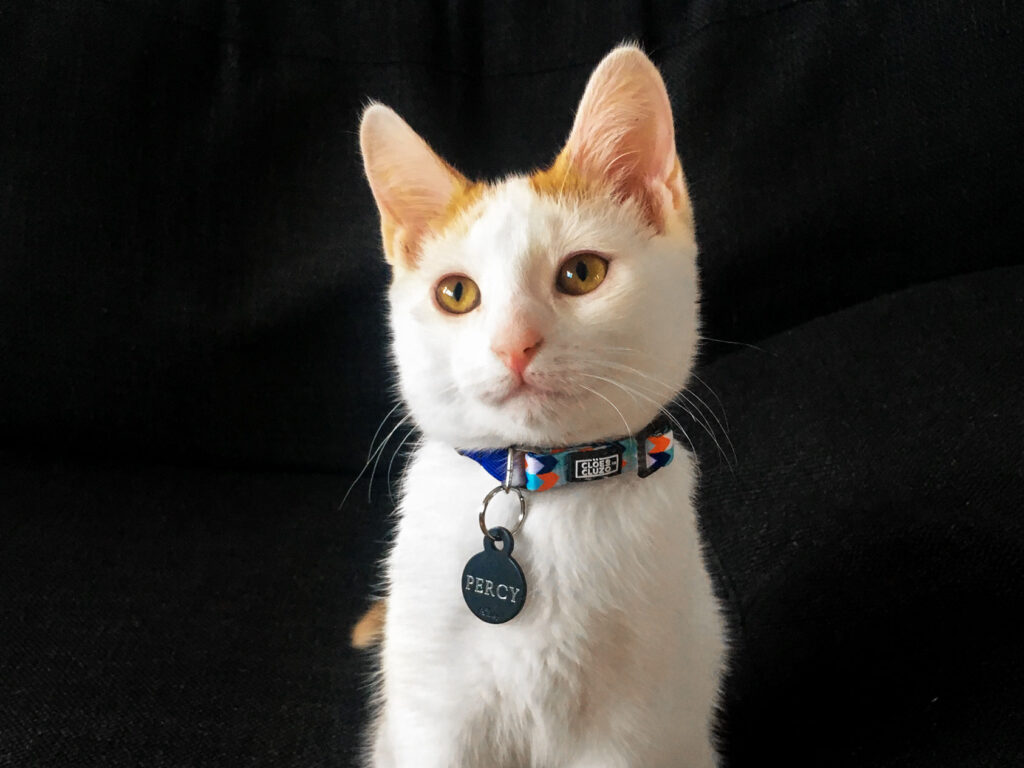
Never forget a favourite travel memory
- Everything You Should Know Before Travelling With A Cat: Is It Worth It?
13 Tips How To Travel With A Cat In A Car
Here are the top tips I’ve learned from driving with a cat in the car!
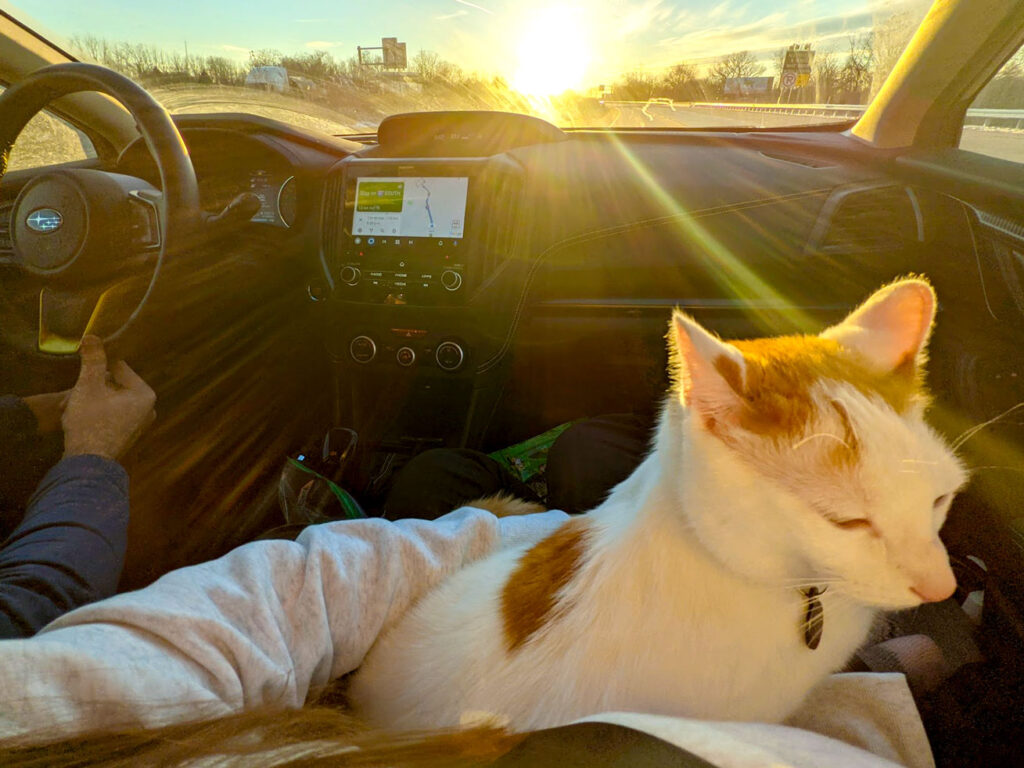
1. Find A Carrier They Love (Don’t Let Them Wander Free!)
When you travel with a cat in a car, the safest place for them to be is in a car safe carrier (like this one on Amazon ).
A free roaming cat in the car causes risks, not only for your safety but also theirs. Even the most well trained cat is risky.
There are so many carriers to choose from, from large to small. Originally I had the large carrier for him, like this one from Amazon . I thought this way my cat would be able to stretch his legs for a bit during longer journeys.
But, after a few road trips, I noticed he’s really in love with his Navigator cat backpack (see it on Amazon here ) and he’s completely okay sleeping in there for 11 hours on the road.
So now I take whatever we have space for in the car, knowing that he’s good in both!
Shop PetSeek Large Cat Carrier On Amazon

2. Get Them Used To Their Carrier Ahead Of Time
A cat’s carrier should be their safe space. You want them to be used to the carrier before ever bringing them into the car in it.
To do this, leave the carrier out in the house for your cat to constantly use. At the start, I left treats inside for my cat to find.
If you have enough time, I would also train your cat to be comfortable when the carrier is closed… this is where my cat starts to freak out.
Start closing the carrier, then give them a treat. Slowly keep the carrier door closed for longer periods of time before giving them their treat.
P.S. If you’re using a different carrier for the car and the hotel when you travel with cats in a car long distance, try to get them used to both. The car carrier is so large, we use a cat backpack to transport him from the car to the hotel.

You might also be interested in reading…
- Honest Cat Backpack Review: Pecute Cat Backpack
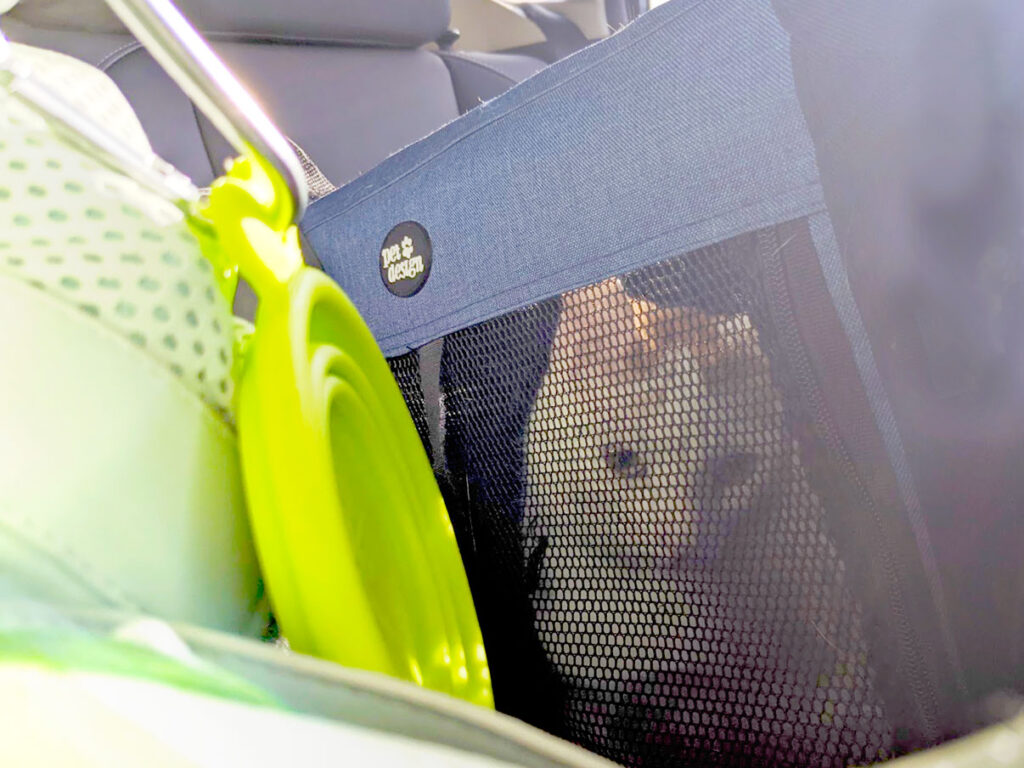
3. Travel With A Cat In A Car – Get Them Used To Driving
The best thing you can do before you travel with cats in a car long distance is to get them used to driving as much as possible beforehand .
Driving is a lot to handle for cats: there’s a lot of motion, different noises, lights …etc.
You want them to be as used to the car as much as possible before venturing on a long road trip. Getting them used to their carrier at home is one thing, bringing it into the car is a whole other ball game.
When we first started bringing our cat in the car he would meow like crazy and rip out of his carrier. I would have to sit in the back with him to put him back inside. Eventually – he learned. I can’t stress enough that this process takes time, so if you have time before you leave, there’s nothing better you can do for your cat.

How To Prepare A Cat For Travel: Training Tips & More
We started by taking our cat in the car as much as we could on short drives. Around the block, to the grocery store to pick up an online order…etc. Try going at different times of the day as well so they can be used to day time, and night time driving!
Eventually, our cat got used to it and now immediately falls asleep as soon as we get in the car.
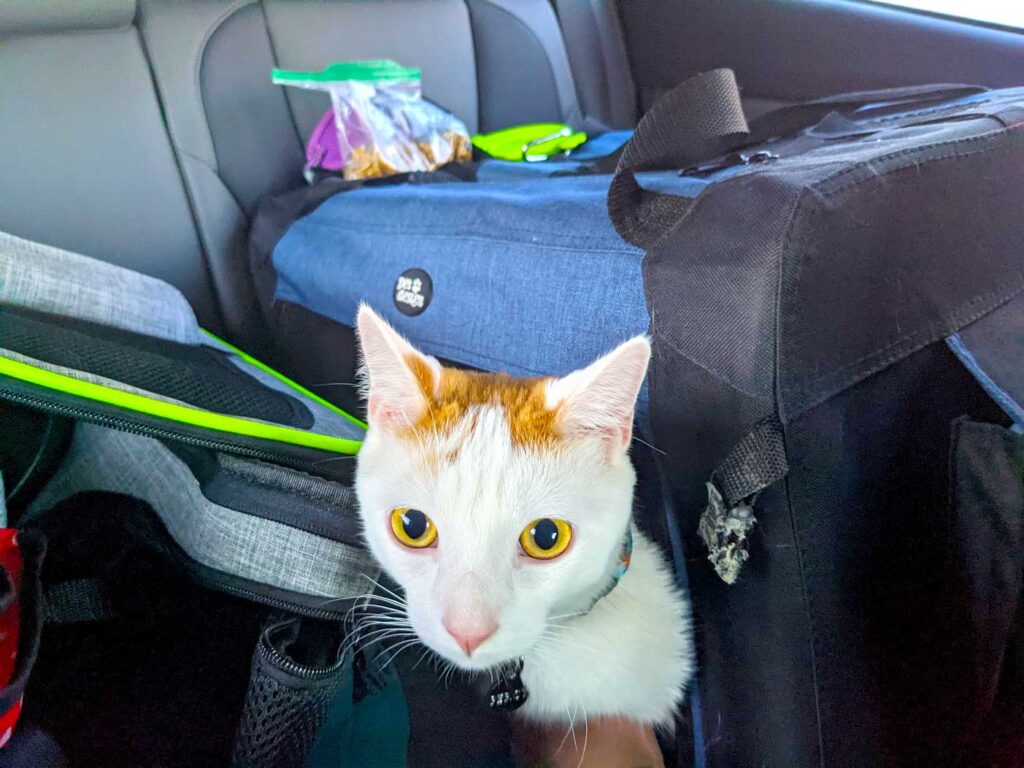
4. Make Their Carrier Feel Comfortable & Cozy
I know, it’s a lot about the carrier so far, bit this is their tiny home on wheels!
So you want there carrier to feel like home as much as possible, not a barren cold carrier they’re stuck in for several hours.
There are a few ways to make your cat feel more comfortable in their carrier to travel with cats long distances.
In the large carrier, I put his bed and a blanket inside so he has a warm place to sleep. I even put a scratcher in there if he wants to use it- although I never saw him even look at it. You can add a toy or two if you want to as well.
We did once have a poop incident, so now I always line the bottom of the carrier with pee pee pads (like these on Amazon )… but more on cat bathrooms breaks in a bit!
If you see your cat is overwhelmed in the car, you can also put a blanket on top of the carrier. This will make the space feel cozier and warmer, and now they won’t be able to see outside or any light reflections.

The ultimate cat travel planner!
My digital cat travel planner template has everything you need to travel with your cat: research pet-friendly places, cat packing lists and checklist. You can print it out or use it digitally on your phone, tablet, or computer.
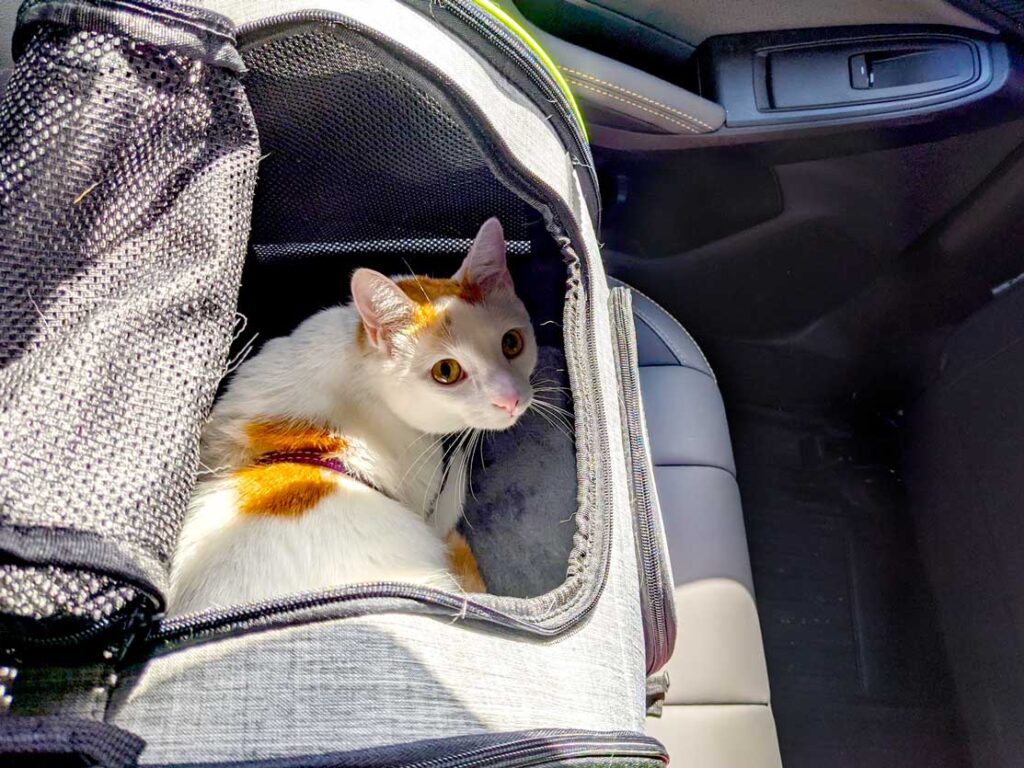
5. Car Travel With Cat: Keep Your Cat Calm While Driving
If your cat is still uncomfortable driving, you may want to get them something to calm their nerves a bit.
I’ve used a spray that mimics cat pheromones to calm them down, see it on Amazon here . Spray this in their carrier 15 minutes before you leave and it lasts from 4 to 5 hours. Heads up: people are nervous that the spray can make the driver sleepy, we haven’t noticed any issues with it.
Another option when going on a roadtrip with cats is to buy calming treats (like these on Amazon ).
If your cat needs something stronger, you can also speak to your vet about getting some medication to travel with a cat in a car.
Shop Ways To Keep You Cat Calm When You Travel With A Cat In A Car

Shop Amazon.ca

6. Be Prepared: Cats Can Hold In Their Pee… But Accidents Happen
You can try to get your cat to use their litter before leaving, but you most likely won’t be successful. And you shouldn’t really worry, cats can hold their pee for up to 24 to 48 hours , but realistically shouldn’t hold it for more than 12 hours (read more here ).
Of course, accidents do happen, especially if your cat is nervous.
With his in mind, plan for the worst. As I mentioned, after a poop incident one summer we now line our cats carrier with absorbent pee pee pads . That way, if our cat had an accident while driving, it’s an easy clean up. It’s also good to have in case your cat gets nauseous and throws up. See pee pee pads on Amazon .
You can still plan to offer your cat their litter box at every stop, but more likely than not they won’t use it… more on travel cat litter boxes soon !
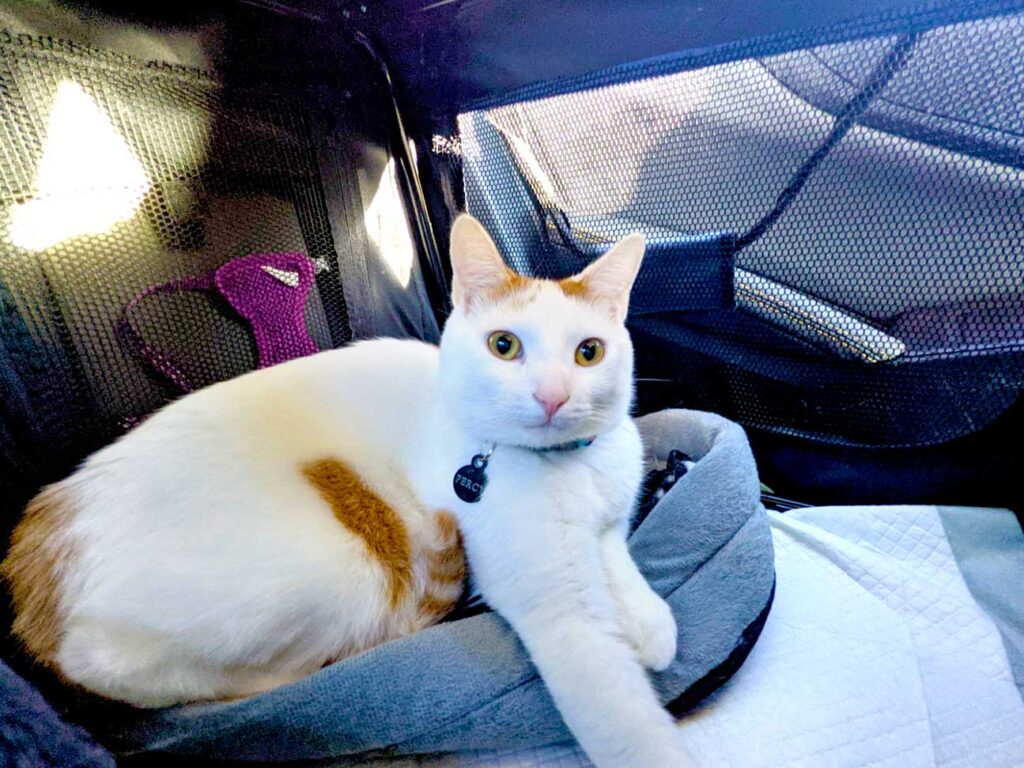
7. Buy Cat Travel Litter Boxes & Use Your Normal Litter…
A big question when travelling with a cat in the car is what to do about the litter box? It’s not like a dog that you can let out to pee on the grass.
You want to buy a smaller litter box that you can close. There are small cat travel litter boxes, like this one on Amazon , or you can just buy a small plastic container with a cover (what we do).
This way, you can easily cover it up and not worry about it spilling it in the car. Or if your cat does use it on the road trip, you can close it up and not have to worry about spelling it!
Another cat road trip tip for the litter box is to use the same litter you’re using at home ! And there are a few reasons for this…
If you buy a travel litter that comes with litter, it’s usually not quality litter that’s provided . It can be dustier and won’t mask the smell as well.
But the main thing is that your cat isn’t used to it. They’re already being introduced to so many new environments and changes – don’t change their litter on them!
Remember, you want to keep as many things as constant as you can. Using the same litter is one of the best ways to do that. Your cat is already used to it, you know they like it, why would you change it?
I even went as far as taking some old litter instead of a completely new bag (don’t worry I cleaned it out first!). But this way it already even smelled like him and he knew it was his!
Shop Cat Travel Litter Box On Amazon

8. What About Your Bathroom Breaks?
When you travel with a cat in a car, your needs often get overlooked. But they really shouldn’t.
Just like you you need to think about your cats bathroom breaks, you also have to think about your own. But unlike cats, we as humans can’t (and shouldn’t) be holding in our pee.
Depending on if you’re driving with anyone else when you travel with a cat in car, you may have to leave your cat alone in the car for a few minutes while you take car of business.
When you leave your cat in the car, make sure their carrier is closed, or they are attached to a leash. You don’t want to open the door to find them running out!
When we first started out driving with a cat, we didn’t leave him alone for a second. We were two people driving so while my partner would fill up with gas, I would use the bathroom. Then we would swap, I would stay at the car – seeing if the cat needed anything (water, food …etc.) while my partner used the bathroom. This way, it also never felt like we were ever waiting for the other person.
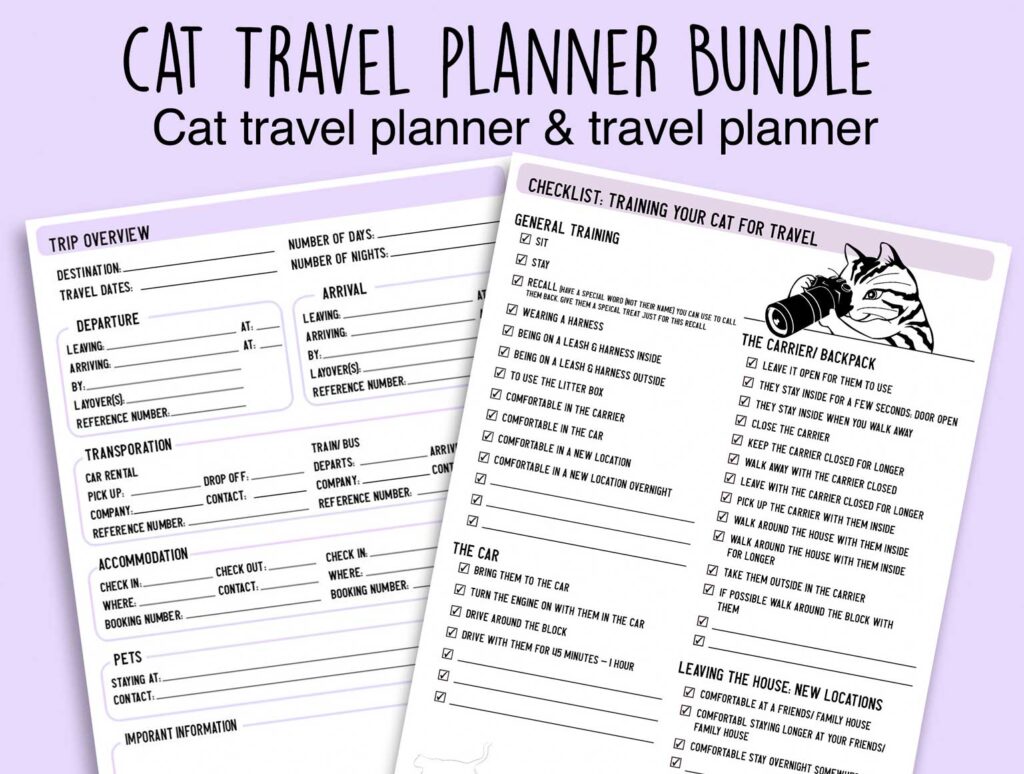
The ultimate digital travel planner bundle for you and your cat!
My digital travel planner template has everything you need to plan your vacation and it’s paired with my cat travel planner .
Click Here to see the bundle on Etsy
By the end of the trip, the cat was more used to staying in the car by himself so now we are able to leave him alone briefly.
If you’re alone driving with a cat, try to train them ahead of time to be okay in the car alone. Or another option is to use a duffel or cat backpack to bring them inside with you. We love the Pecute cat backpack for this.

9. How To Keep A Cat In The Car Hydrated!
If you’re packing water for yourself, make sure you have extra for your cat and a bowl to give it to them ( get a collapsible bowl on Amazon for this ).
Our cat didn’t want to drink water during the drive at all. Whenever I offered it to him he was too interested in what was happening outside.
It’s okay if they don’t drink during the day, but make sure they drink enough at night. Dehydration in cats is a real thing.
To make sure my cat stayed hydrated on our road trip I bought chicken in water from Purebites . You can also buy wet food to give them when you arrive at your destination to make sure they’re getting enough water.
Roadtrip With Cats – Keep Your Kitty Hydrated

- Made with only 1 ingredients; 100% pure Chicken Breast in water.
- 100% Natural & Grain Free, High in Protein and only 32 calories per tray.
- Cat parents love PureBites because our treats are rich in nutrients for a happy and healthy life

10. Pack A Quick Access Bag With Your Cats Necessities
You’ve packed everything for your cat and maybe even have a separate overnight bag for them.
But you’ll also want to pack a quick access bag. This bag will keep everything you may need for your cat while you’re driving . You can either keep it in the front with you or have it accessible in the back seat.
It should carry all your cats necessities and what you’ll either need in the car or when you stop. I packed a small bag of treats (two kinds for a nice variety!), food, his harness and leash, collapsible bowl, Feliway calming spray, and a toy.
You should also keep any medication that your cat has here as well as his proof of vaccination.
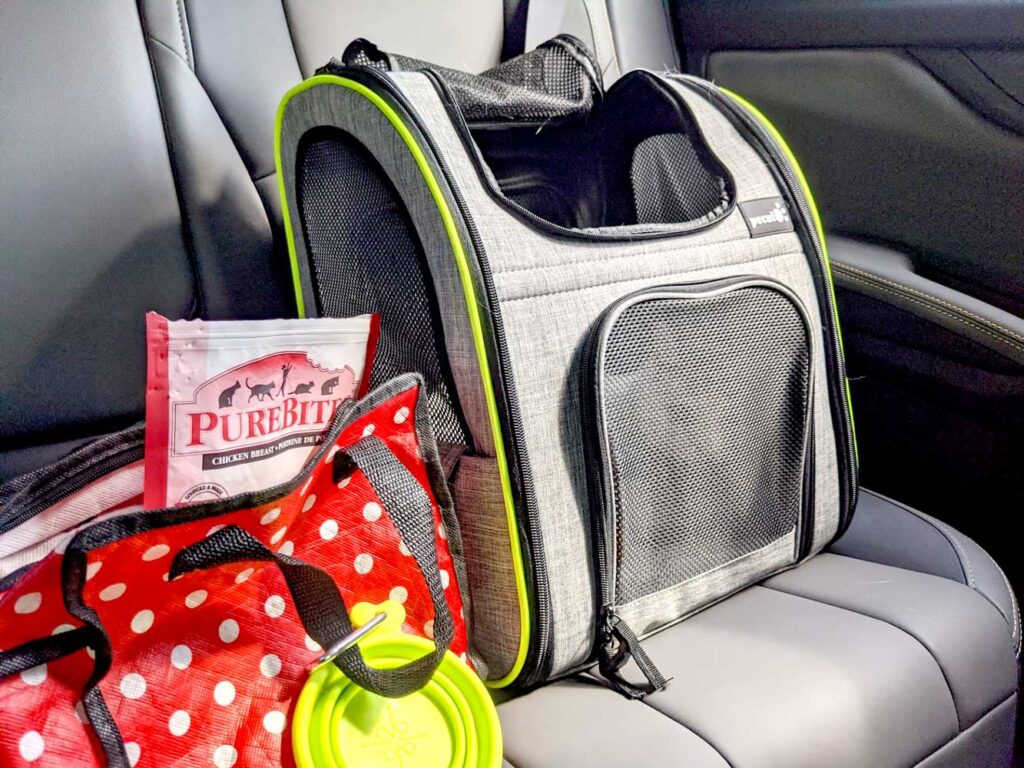
11. How To Travel With A Cat: Don’t Just Ignore Them For 8+ Hours!
This may sound obvious but depending on your cat, they may just sleep in the car the whole time, so they can be easy to forget about.
I noticed that towards the end of the day, our cat did get lonely. He would start meowing and pace in the carrier.
Every stop even if I didn’t take him out, I would go around to give him some pets and offer him food and water. But he was often too distracted by what was happening outside to even care about me.
So, instead, while on the road I would open up the carrier when he was calm and just stick my hand in to pet him every once in a while. He really appreciated this to know that we were still there and give him a bit of human touch. Normally he doesn’t go this many hours without sitting on our lap.
This is also where sometimes I would take him out of the carrier to sit on my lap if he was really agitated. This is really about listening to your cat and their needs.

12. Don’t Go Too Long Without Stopping With A Cat In The Car
Even if your cat doesn’t get out of the car when you stop, or you noticed they still don’t drink water, it’s still important to take a break.
You don’t want to go too long in the car without stopping and giving them the option to get out.
I would plan to stop max every 3 hours but also listen to your cats needs. If they’re getting restless stop earlier for them. Give them water, food, and maybe even offer them the litter box.
My cat never wanted to go out in the end, he felt safest in the carrier in the car. So I did stop taking him out and offering him water by the end of the trip – I knew he didn’t want it. But I would still visit him in the backseat and give him some much deserved pets!
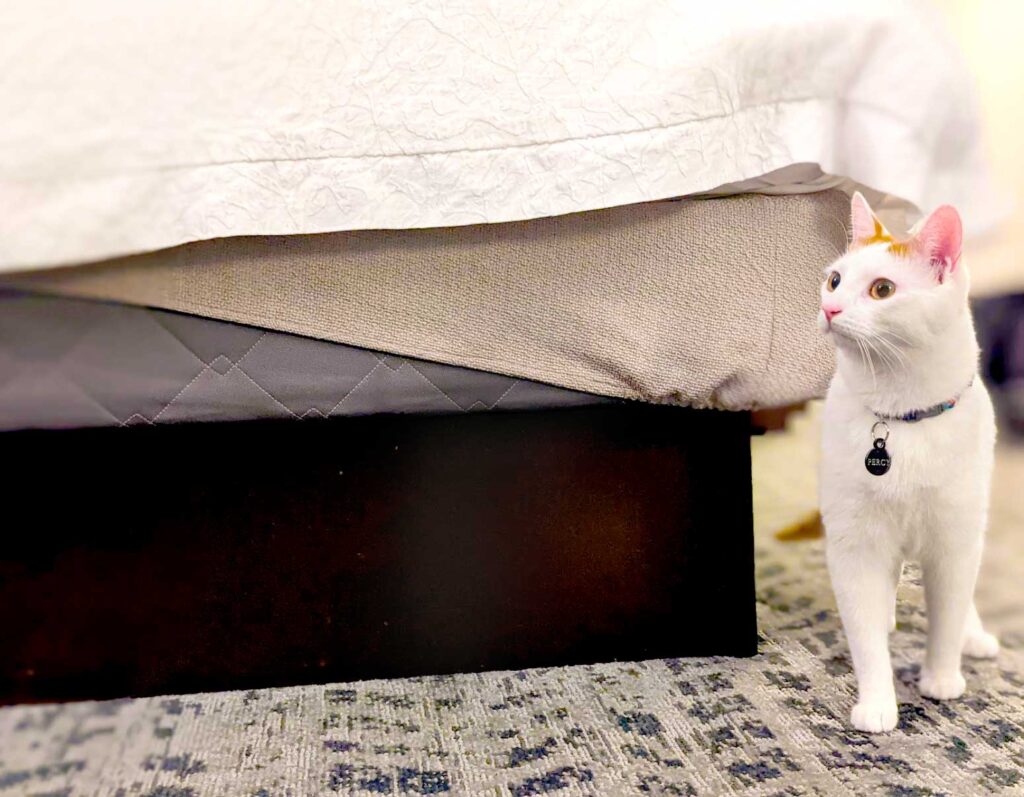
- 15 Important Cat Road Trips Tips For Staying In A Hotel With A Cat
13. Roadtrip With Cats: What Are The Best Places To Stop?
Depending on where you travel with your cat in the car, there may be road side rest stops. On route from Montreal to Florida rest stops right off the highway.
They had bathrooms and typically a large grassy area with picnic tables.
I found I could take my cat out to the grass on the leash and harness here (like this set on Amazon ). It’s a good spot to set up a bathroom break for your cat and offer water and food outside the car.
The only downside is that they may not have a gas station to fill up at. So you’ll still have to make another stop for that.
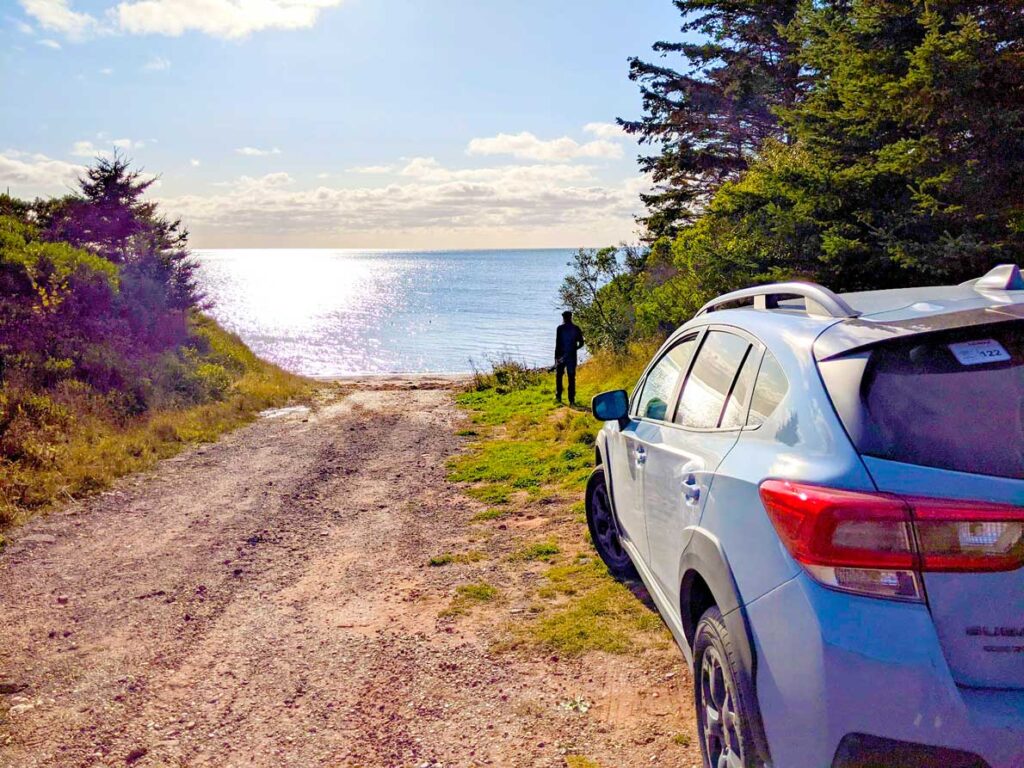
- Top 50 Long Distance Road Trip Tips For A Safe & Easy Drive
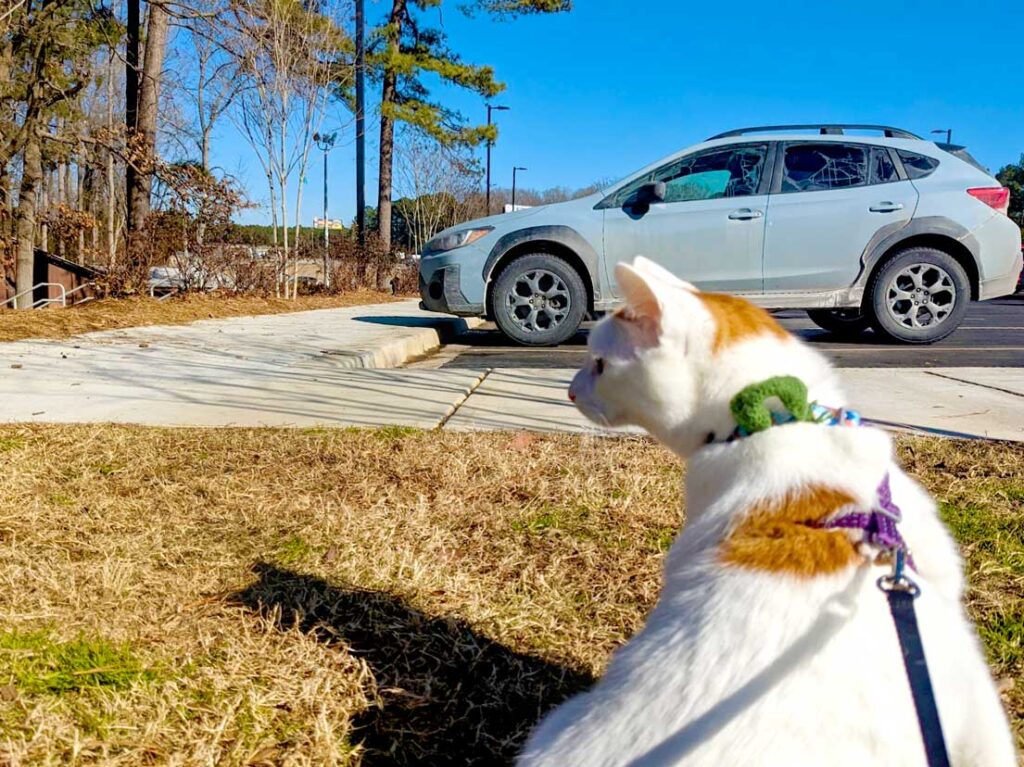
Quick Links – What You’ll Need To Travel With A Cat

Read More Related Posts
- What You Need To Travel With Your Cat In A Car Long Distances
Pin To Save Or Share This Post

Last update on 2024-04-28 / Affiliate links / Images from Amazon Product Advertising API
Pamela Schuman
Thursday 7th of September 2023
I am traveling from Washington to Indiana with four cats and I’m not sure how they’re going to do my one cat I drove from Indiana to Washington with when she was five weeks old that was it that was a breeze but she’s over a year now and the others are younger so I’m hoping my trip goes great. I’m thinking at least five days for overnights. What do you think?
Friday 22nd of September 2023
I hope your trip goes great too! It seems like you've planned a decent amount of time for the drive to allow for stops and shorter driving days if you need it. Take it one day at a time and see how your cats are doing, if you can try to take them in some short car rides before you head out on the big trip!
Good luck, happy cat travels :D
Saturday 19th of August 2023
Hello Meghan! 🐾
Enjoyed reading your helpful and practiced tips. I’m moving 1800 miles away at the end of Sept. Having tons of anxiety over driving or flying with my fur baby Templeton. 😻 He’s older and like most cats, doesn’t love car rides. 😾 Do you have any advice/articles on which is better - flying or driving? I’m sure it’s cat and owner dependent. The Vet said it’s going to be stressful either way, so get it over with quickly and fly with him. I go back and forth. I’ll need Valium! 😹
Oh no!! I'm sorry to hear that you're stressed about traveling with your fur baby but I totally get your stress.
I've actually never flown with my cat so I can't say from experience which is better. I would listen to your vet and get it over with if they don't like either!
Hope it goes well, best of luck!
Sunday 23rd of July 2023
Awesome article, great tips. I also read the article about hotels tips with cats. We're driving cross country with 2 cats and a new to them dog. These cats have never moved with us before. They will have each other to comfort each other. Lots of great tips and the links were very helpful!
Thursday 27th of July 2023
Thanks! Hope your cat and doggie travels go well!
Monday 3rd of July 2023
I'm contemplating a trip of approximately 1700 miles, traveling alone with my 2 cats. Really not sure I can do this. What is the most important thing you can advise me of.
Tuesday 4th of July 2023
It really all depends on your cats, my best advice is to get them used to the car as much as possible and start taking them with you any time you can before your trip! I would also say not to push it on the driving days as well. Start with shorter days and then if they're doing alright you can start adding time. Our cat was perfect for around 7 hours in the car and then by the 8 hour mark we noticed we would start getting antsy. So when we drove back home from Florida (about 1600 miles!) we made sure to never pass the 8 hour mark in the car.
Happy cat travels! Let me know if you have any other questions!
Monday 27th of February 2023
My Fuzzy beast, a 6 pound Ragdoll took to it as easily as my Alaskan Malamute x GSD, even sleeping in the back seat together, taking bathroom breaks in loose sandy soil. She approached new hotels with the same brief interest we all had, looked for the dog’s bed so she knew where she was sleeping that night if she wished … bugger all the dog. It wasn’t my magic touch though- I had a tuxedo who sat in the back window and moaned like he was going to vomit.
That's adorable! I like to think you still took some part in making it easy for your ragdoll to take to travel easier :D Just shows you how can really depend on the cat though sometimes! I hope it gets easier with your lil Tuxedo kitty!
- Search Search Please fill out this field.
- Sweepstakes
- Living with Pets
- Traveling with Pets
How to Travel With Your Cat in The Car (and Help Your Kitty Stress Less!)
It doesn't have to be so stressful for you or for your cat.
Janelle is a cat mum to two resident adventure kitties, Lyra and Atlas, and numerous cat and kitten fosters. Janelle and her furry family enjoy filling their days with hiking, kayaking, and seeking out the best cat-friendly destinations around the Pacific Northwest. You can follow Janelle, her adventure kitties, and adoptable fosters at @paws_pdx.
:max_bytes(150000):strip_icc():format(webp)/janelle-leeson-58f2c77d4a4b4b3c994938e0e0618d57.jpg)
Do Cats Like Car Rides?
Why is my cat panting in the car.
- How to Travel Long Distances
- Travel Gear
Cats have their own way of saying , "No thanks, I'll stay home!" From excessive meowing to hiding at the sight of their carrier—there is something about a trip in the car that many felines often dislike.
If you're like most of us cat lovers, you might be wondering if there are any kitties on earth who actually enjoy riding in the car. With all the hiding and meowing that happens ahead of a vet visit, it's tough to even imagine a world in which cats are willing to get in the car, let alone enjoy it. But pet pros say that with enough positive associations with the car and their carrier, it's possible for cats to actually learn to like an occasional ride here and there. With a little training and some help from his favorite treat, your kitty could be on their way to co-pilot status. So buckle up, because we've teamed up with two cat behavioral experts to determine how to make those wild rides just a little more enjoyable for everyone.
Before we try to modify a kitty's behavior, it's important to understand it. When considering why so many cats have an averse reaction to trips in the car, think about their experience with that action. Many times, a car ride is associated with a dreaded trip to the veterinarian. This negative association—combined with the motion of the car and all the new sights, sounds, and smells that go along with it—can cause a total sensory overload for your cat. This may be why your feline friend harbors her distaste for traveling in the car, explains Shannen McNee , CCBC at The Toronto Humane Society. But it doesn't have to be this way! McNee says that a little bit of training can make a trip in the car a less stressful experience.
So, how do you train your cat to like the car, or at least tolerate a ride to the vet? LeeAnna Buis , CFTBS at Feline Behavior Solutions, says training your cat for car rides starts inside your home. "Your cat may actually be reacting to the carrier more than the car," Buis explains. With a few desensitization strategies and positive reinforcement that incorporates high-value rewards (like favorite treats or toys), the carrier can become a safe, fun space for your cat.
To help your cat love his carrier, McNee suggests a few simple steps:
- Leave the carrier out so it becomes a part of your cat's familiar environment. Make it a cozy space by placing his favorite blanket inside.
- Encourage your cat to spend time in his carrier by rewarding him with treats and feeding meals inside the carrier. Playing with your kitty inside the carrier is a great idea, too!
- Once your cat starts relaxing in his carrier, close the door for short amounts of time followed by rewarding him with a tasty treat. Gradually increase the amount of time the door is closed.
- Once he is comfortable in the carrier with the door closed, start picking the carrier up for short amounts of time. Where will your first trip be? A walk around your house with him safely inside the carrier!
When your kitty successfully associates his carrier with positive interactions and as a cozy place to take a nap, Buis recommends slowly introducing him to a car ride inside of his carrier. "Start by just sitting in the car in the driveway," Buis explains. "After a few sessions of this, start the car. Move on to letting it run for a few minutes, then backing out of the driveway and pulling back in, and so on."
Lastly, Buis says to pay special attention to reward your cat for the desired behavior. "Never underestimate the power of positive reinforcement," Buis says. If a car ride comes with lots of verbal praise and treats, your kitty will be more likely to want to repeat it another time.
While cooling down is the most widely recognized reason for panting in animals, there are other reasons your cat may be panting while traveling in the car. One of those reasons, McNee says, is anxiety . To calm down your cat in the car, McNee has a few suggestions:
- Put some of your cat's familiar scent in the car by rubbing your cat's cheeks with socks or small cloths, then put them in the car.
- Play your cat's favorite tunes . That's right, there's actually music created specifically to calm cats (and it's quite soothing for humans, too). Composer David Teie created Music for Cats , an album of classical, species-specific music that scientific studies have shown actually reduce stress for kitties.
- Spray a calming pheromone like Feliway inside the car and carrier that mimics the natural essence that mama cats give off when their young are nursing.
How to Travel With a Cat in a Car Long Distances
When it comes to long car rides with your cat, Buis has three words of advice: practice, practice, practice. "Start well in advance of your trip with mini car rides and slowly work up to longer and longer periods in the car as your cat gets comfortable," Buis says.
McNee and Buis recommend planning each and every stop along your journey. "Call ahead to ensure the places you plan to stay are cat-friendly and plan your route to include regular water and elimination breaks," McNee recommends.
Cat Car Travel Gear You Might Need
Testing out your gear before a long-distance car ride isn't a bad idea either. Here's a few suggestions of the gear you might need for your kitty's next road trip.
1. Cat Car Carrier
Your cat's carrier should be large enough that he can stand up and reposition. "Look for carriers designed specifically to be strapped or belted-in for security," Buis recommends.
2. Cat Car Harness and Seatbelt Loop
"If your cat is harness trained for adventures and enjoys car rides, get a harness with a seatbelt loop to secure him," McNee suggests.
3. Car Seat Cover
A car seat cover is the best way to keep your car clean and free of pet hair, kitty puke, muddy paws, and anything else your cat drags in.
4. Calming Medication
"If your cat is prone to motion sickness or anxiety, talk to your vet because they may recommend medications that can help," McNee says.
Related Articles
More related articles.
- About Petfinder
- Adopting Pets
- Animal Shelters & Rescues
- Petfinder Foundation
- Dog Adoption
- Feeding Your Dog
- Dog Behavior
- Dog Health & Wellness
- Dog Training
- Other Dog Information
- Cat Adoption
- Feeding Your Cat
- Cat Behavior
- Cat Health & Wellness
- Cat Training
- Other Cat Information
- Exotic Pets
- Guinea Pigs
- Small & Furry Pets
How to Travel With Your Cat in the Car
Part 1: get your cat to like the car.
For many cats, riding in the car is unpleasant. But for some, it’s the worst thing that could ever happen to them (according to them, at least).
Before embarking on a road trip, first spend some time getting your cat to like the car. Then, once your cat is comfortable in his carrier , the next step to reducing the stress of vet visits (or travel in general) is to create positive car associations for your cat. The process takes some time and patience, but it’s worth it. Here’s how:
- Start young : Kittens usually adjust to new experiences and surroundings more easily than an adult or senior cats, so start the travel-training process as early as possible. If your cat is past kittenhood, don’t worry: Adult and senior cats can still learn to tolerate car rides.
- Rule out motion sickness : If your cat already has difficulty traveling in the car, ask your vet whether your cat could be getting motion sickness. Symptoms include drooling, nausea, vomiting, and diarrhea. If you suspect that your cat is getting motion sickness, your vet may recommend a medication such as Dramamine to treat nausea. (Never give your cat medication without asking your vet first.)
- Practice getting in the car : Bring your cat, secured safely in his carrier, out to your car (with its engine off). Strap him in with a seatbelt and sit next to him. If your cat is calm, give him his favorite treat. Repeat, gradually increasing the amount of time he has to wait in the car until he gets treats. If he seems upset or tries to get out, don’t give him a treat and try again with less time in the car. When you bring him back into the house, let him out calmly and without fanfare.
- Practice turning on the engine : After your cat learns that sitting in the carrier in the car is okay, try turning on the engine before giving him treats. Add this to your routine, rewarding calm behavior with treats and stopping when you observe nervous behavior.
- Practice driving around the block : Once your cat can stay calm while you have the engine on for a few minutes, try driving around the block, then give your cat a treat. After he’s eaten the treat, bring him back inside and let him out. If your cat did well on that short trip, repeat the process, gradually increasing the distance you drive and rewarding your cat for staying calm. Having a second person to give your cat treats while you drive can help.
- Practice driving at different speeds and around corners : After your cat’s a pro at driving around your neighborhood, try driving one exit on a highway and/or a short distance on a winding road. Once you’re in a safe place to stop, pull over and give your cat a treat if he’s done well.
- Practice driving to your vet’s office : If your cat’s like mine, he can tell where you’re headed from the twists and turns of the road. So get him used to the route you take to and from the vet’s office by following the same routine described above, rewarding calm behavior.
Part 2: Road Trip Checklist
- Talk with your veterinarian: Check that your cat is healthy enough to travel and learn what to do if your cat gets carsick.
- Check identification: Check that your cat is wearing an easy-to-read tag on his collar. Don’t forget to also check that your cat’s microchip information is up-to-date.
- Plan pit stops: Plan to stop every 2-3 hours to give your cat water and access to the litter box.
- Pack extra supplies: If your cat needs any special food or medicines, be sure to pack extra to avoid emergencies.
- Confirm your hotels: Call and confirm that any hotels where you’ll be staying will also allow your cat.
- Prepare for stress: If your cat tends to be easily stressed, talk to your vet about possible medical help.
- Before you drive off: Exercise your cat by playing with her before you leave. Also, give her some food and water (unless your veterinarian directs you to do otherwise).
- Keep your cat in the carrier: Restrain your cat while in the car avoid accidents and keep him safe. Worried that your cat will hate the carrier? Try these steps to help your cat like his carrier at the start of your travel planning. <insert infographic>
- Never leave your cat in the car! Cars heat up fast and in only a matter of minutes, your cat’s life could be in danger. Click on the image above to learn more about why you should never leave a pet in a car.
Finding pets for you...

13 Tips for Traveling in a Car With Your Cat
Cats and car travel can be a daunting combination, but there are ways to prepare for a road trip.

If your cat is anything like my first cat, car rides are screeching, howling, blood-curdling screams of agony until the destination is reached.
Longer trips across multiple states required sedation or she would become stressed and dehydrated from howling for hours. I limited the trips as much as I could, but here in the South a hurricane evacuation is sometimes unavoidable. Every single trip was stressful — probably more for me than my cat. My second cat loves his carrier and couldn’t care less about cruising in the car.
If you need to head out on the road and plan to bring Mister Floofikins, there are some car travel tips you can review.
The Carrier
The comfort and resources available within the carrier can make or break a trip when it comes to your cat’s comfort. Choose a carrier that allows your cat to stand up, turn around and lie down comfortably at a minimum.
Ensure proper ventilation is available on all sides of the crate with sufficient holes, mesh or a gate. Line the bottom of the carrier with an absorbent material in case of accidents. You can then cover it with a towel or your cat’s favorite blanket and toys.
Cats that are used to freely roaming and not used to being transported may throw a “Talk to the paw” up at the new carrier. Keeping the carrier inside with the door open will encourage your cat’s curiosity. Throw in a familiar material or some toys to entice Floofikins to check it out. Cats love boxes , and allowing them to enter and leave the carrier as they wish will (with any luck) not make them feel trapped when it is time to close the door and go for a ride.
If you have to make a stop to clean up an accident in the carrier, keep your cat in the carrier and try to look for a bathroom with a locking door and no escape routes (such as at a gas station). Once you are inside and are sure your cat can’t escape, feel free to open the carrier for cleaning.
It can be dangerous to let your cat roam free in the car while you drive. In addition to causing a distraction for you, your cat can get wedged in small spaces, find a way under the gas and brake pedals, or risk being jolted or thrown because of sharp turns or an accident.
Beat the Heat
Keep the carrier in an area of the car that will receive good air circulation. Avoid spots that will be in direct sunlight or cargo areas in the rear of the vehicle that might trap heat. Try to travel during months with milder temperatures when possible.
Do not leave your cat in the vehicle. If you stop, turn the engine off and take the carrier with you (or use a harness and leash if your cat is into that). Don’t leave your engine running either; it’s an easy target for thieves and you might lose your car and your cat.
The Supply Checklist
It is a good idea to determine what you need to bring before your trip so you’re prepared for any situation. Below is a checklist of items we suggest taking with you when traveling with one cat (increase quantities as needed for multiple cats).
- Food and snacks/treats
- Fresh water, preferably bottled or brought from home
- Clean cat litter
- Clean litter pan
- Brush or grooming tools
- Any medications
- Pet first-aid kit
- Extra collar and tag
- Extra harness and leash
- Extra blanket or towels to replace soiled materials
- Copy of vet records (3 copies)
- Picture of your cat (3 copies)
- An additional carrier that meets flight safety requirements in case you have to fly home unexpectedly
Triple the Paperwork
In the event of an unforeseen accident or circumstance, it may be possible that the carrier or your cat becomes separated from you. Permanently mark the carrier with “Live Animals” so observers will know an animal is inside. You may also want to permanently mark your contact information on the carrier.
When making copies of your cat’s records, make three copies:
- One copy stays in the vehicle.
- Another copy stays with you.
- A third copy should be placed in a weatherproof folder or plastic bag and secured to the carrier.
Keep a photograph of your cat with each copy. Also consider having your cat microchipped if not done already.
Accommodations
Don’t show up at a hotel or holiday home and expect them to welcome Floofikins with open arms. Many places do not allow pets, and ones that do may require advance notice, deposits or nonrefundable fees. Call ahead to check their policy or keep a list of pet-friendly hotels with you if you have to choose one while on the go.
Keep the litter box in the bathroom of your hotel room with a mat or towel underneath the pan to minimize mess. Make sure the food and water is separate from the litter pan as most cats will protest if they’re too close together.
Going Vertical
Some car trips will take you far from home, a state away or even across the country. If you are planning on being far from home, consider the possibility of having to fly home or to another destination in the event of an emergency. If you have a preferred airline, familiarize yourself with their pet policies before the trip.
Was YOUR Pet Food Recalled?
Check Now: Blue Buffalo • Science Diet • Purina • Wellness • 4health • Canine Carry Outs • Friskies • Taste of the Wild • See 200+ more brands…
CHECK RECALLS NOW!

If you’re not sure where to start, check out our Airline Pet Policies help guide to get started. Print it out and take it with you to have airline contact information, pet flight preparation tips and an idea of the costs you may have to pay to fly your cat with you.
Secure the Slider
An unsecured carrier can slide, turn over or go flying depending on the movements of the vehicle. After placing towels, blankets or waterproof seat covers over the seats (if desired), use the seatbelt to secure the carrier from sudden movements. In the event of an accident, the carrier can be thrown about the vehicle. Taking this extra step will help keep your pet safe from unnecessary injuries.
For cats with motion sickness or severe anxiety, talk with your veterinarian about the options available to help your cat travel. Sometimes keeping cats out of view of the windows may help, while other cats might need a mild sedative. Other alternatives such as [easyazon_link asin=”B00016QT7Q” locale=”US” new_window=”default” nofollow=”default” tag=”p51capital07-20″ add_to_cart=”default” cloaking=”default” localization=”default” popups=”default”]Rescue Remedy[/easyazon_link] or Feliway may be recommended.
Practice Runs
Once your cat has had a chance to become accustomed to the carrier, consider taking a few practice runs. Short drives allow your cat to be exposed to the experience of riding in the car while in the carrier. Short trips, such as driving around the block or through the neighborhood, can be a starting point until you feel longer drives are possible and your cat is comfortable (plus this shows that not every car ride includes a vet trip).
If you aren’t able to fully prepare for a trip, try to keep your cat calm by remaining calm yourself. Check that you have the necessary supplies and safety recommendations prepared before departure.
Additional Tips
- For long trips, you can use larger crates that might fit a litter box inside. A covered litter box will help contain the litter. If this isn’t a feasible option, plan to make stops throughout the trip.
- Don’t feed or provide water to your cat just before a trip to avoid immediate potty breaks or an upset stomach. Removing food and water a few hours before the trip is generally okay, but check with your vet (especially if your cat has any medical problems).
- Leaving your cat in a vehicle with cracked windows is dangerous. Heat can rise rapidly in the vehicle or dangerous cold can get in and risk freezing your pet. If you have to leave the vehicle, take the cat with you.
- Use highly valued treats to reward your cat when training with a new carrier or after returning home from practice runs.
- Remove all food and treats from the car when the trip is over. Do not keep cat food in the car for long periods of time just to have it on hand; it can spoil from the elements or expire.
Traveling with your cat can be stressful, but it can also be a pleasant experience with a little planning.
Don’t leave your pet’s food safety to chance.
Sign up for petful’s recall alerts today. (it’s 100% free.).

Stay informed. Protect your pets.
Meet Petful
- How We Help
Pet Food Safety
- Free Recall Alerts
- Pet Food Recalls
- Report Problems
- Vet-Approved Recipes
- Adopt a Pet
- Privacy Policy
- Cookie Policy
- Terms & Conditions
© 2024 Petful® / P51 Capital All rights reserved. Petful does not provide medical advice, diagnosis or treatment. More information.
- Skip to main content
- Skip to header right navigation
- Skip to after header navigation
- Skip to site footer

for traveling & adventuring cats
13 Tips for Traveling with a Cat by Car
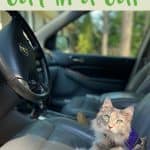
Traveling with a cat by car may seem like a crazy idea. Cats and car rides are just not usually two things you’d think would go well together. Most people would agree with you too.
Going on a cat road trip cat can actually be a lot of fun though, and your cat can even grow to enjoy it. There is also the added benefit of not having to hire a pet sitter if you’re able to bring your cat along with you on your travels. It takes preparation and practice, but we’ve got you covered with everything you need to know about how to travel with a cat in the car. Whether you’re wondering how to travel with a cat across country or just how to take a short road trip, keep reading for 13 cat road trip tips!
*Disclosure: This post contains affiliate links. If you make a purchase using one of these links, I will receive a small commission at no extra cost to you. This helps me to continue creating helpful content. Don’t worry – I would never recommend something I don’t like or use myself!
Planning a Cat Road Trip
As you may have guessed, traveling long distance with cats in the car is not as simple as just packing up and hitting the road. You’ll need to plan things out and make sure both you and your cat are prepared. If your cat is already harness and leashed trained , that’s a bonus. There are some other prep steps you’ll need to take as well before your trip.
1. Pick out a safe and comfortable cat carrier.
Your cat should always ride in a carrier when traveling in the car. No matter how well behaved your cat is, it is safest for them to travel in a carrier. You never know when something might spook your cat, you have to brake quickly, or God forbid, you’re in a car accident. A carrier will help keep you, your cat, and other people on the road safer.
Our favorite carrier is the Sleepypod Mobile Pet Bed . The Sleepypod doubles as a cat bed and a carrier, which allows for your cat to travel in the comfort of her own bed. This is perfect if your cat gets stressed while traveling . It also has a mesh-dome top that allows for your cat to have a clear view of their surroundings. The best feature of the Sleepypod though is that is has been crash tested. It can be strapped in with a seat belt and has proven to hold up in car accidents.

If you’re looking for something more spacious, perhaps for a longer road trip, the Pet Fit for Life carrier is a good option. It doesn’t have the safety features of the Sleepypod, but it can be strapped in with a seat belt and gives your cat more room to stretch their legs. The large size can fit two cats, and it also comes with a portable litter box.
2. Practice driving short distances with your cat.
If your cat is not accustomed to riding in the car, you’ll want to ease them into it. Put them in the carrier you will be using for your trip*, and go for a ride around the block. Next time, increase the distance you go. You don’t want their first car ride to be a trip across the country.
*Carrier Tip: Leave your cat’s carrier out in the house so they can get used to it on their own before you take them in the car. You can feed them in the carrier as well so they begin to associate it with positive experiences. You want them to view the carrier as a safe and comfortable hang out spot.
3. Make sure your cat’s ID tags are up to date.
Of course you don’t expect or plan to lose your cat when on a trip, but it’s always best to be prepared. On the off chance that your cat gets away from you, you want to be sure their ID tags are current before you leave for your trip. If they’re not already microchipped, you might consider taking that step as well.
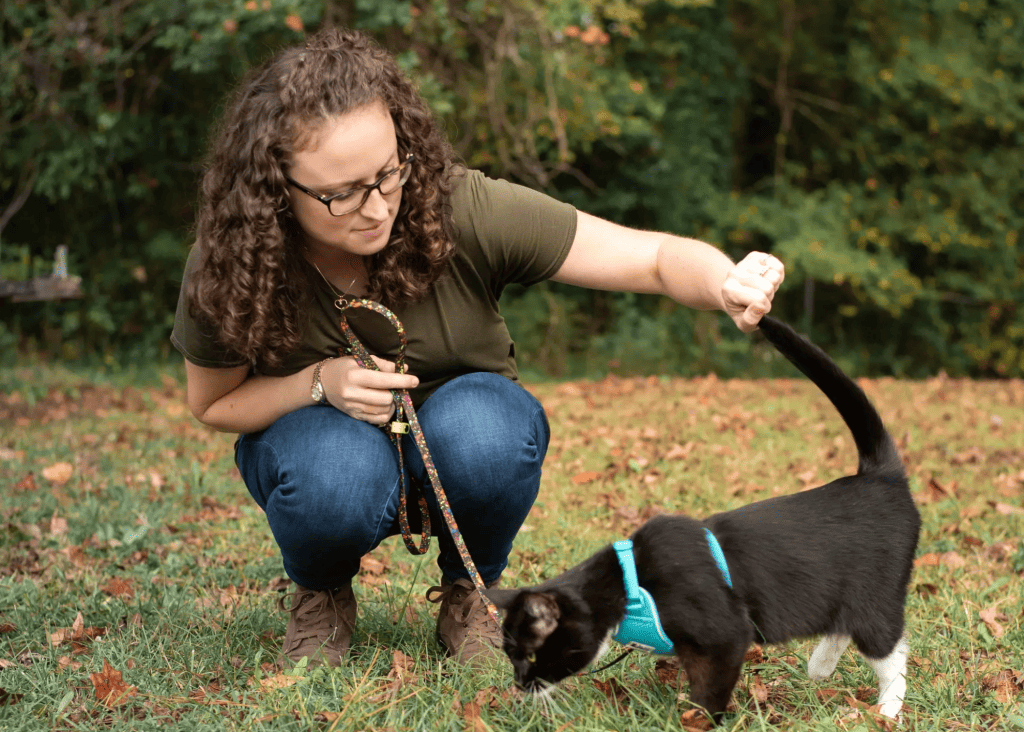
Is your cat meant for a life of adventure?
Take the interactive cat personality quiz to find out!
4. Make your reservations for cat-friendly accommodations.
While you may be able to wing it and stay at the first hotel you come to when you’re traveling alone, it doesn’t work that way when traveling with your cat. Finding cat-friendly accommodations isn’t always easy. Make your reservations ahead of time so you are sure to be able to find a place to stay.
When making your reservations, always confirm that they are cat-friendly. Don’t assume that because they are “pet-friendly” that that includes cats. Unfortunately, many hotels, motels, and other rentals are listed as pet-friendly, but what they really mean is that they are dog-friendly.
Contact the place directly and make sure they allow cats. Be sure to ask if there are any extra fees for staying with your cat as well. You don’t want to be surprised by any unexpected charges when you check out.
5. Have a litter box plan (but understand things might not go accordingly).
If your road trip is only a couple hours long, you probably don’t have to worry about having a litter box in the car. However, if you will be on the road for several hours, you will need to have a plan for how your cat can go to the bathroom. There are actually several ways you can handle the litter box situation when traveling with a cat by car.
- A small, disposable litter box
- A plastic storage container with a lid
- A reusable litter box meant for travel
- If your cat’s carrier is large enough, you may be able to fit a small litter box in with your cat.
- Line your cat’s carrier with pee pads in case they need to go or have an accident.
- If your cat is comfortable using the bathroom outside, then you can just stop and let her go at a rest stop (while harnessed and leashed, of course).
While you should definitely have a plan for how you’re going to handle the litter box situation, please understand that your cat may have a different idea of how things will go. For example, I always bring a litter box in the car on long trips, but my cats have never once used it. They always wait until we’re settled at our destination.
The best plan would be to have a couple different plans. Maybe have a litter box in the car for your cat to use on a pit stop, but also line her carrier with pee pads just in case. You never know how your cat is going to handle going to the bathroom on a road trip until you’ve done it a time or two. Give them options in the beginning until you know their road trip bathroom habits.
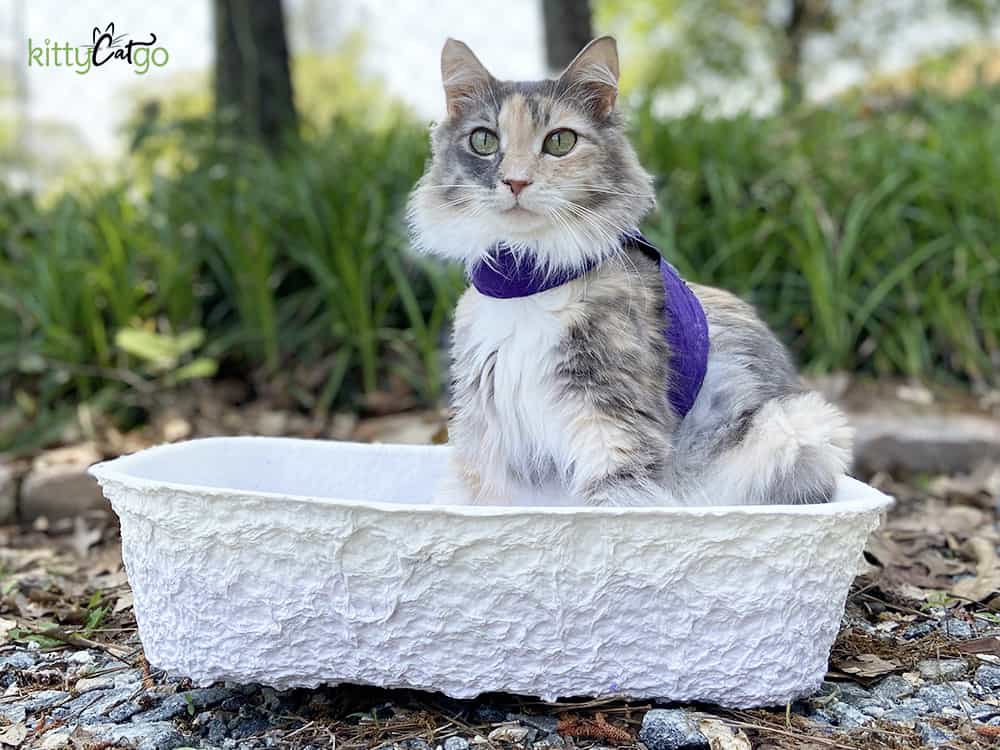
6. Make a list of things to pack for your cat.
Whenever I travel with my cats, I joke with my husband that their suitcase is bigger than mine. Cats need a surprising amount of stuff! Everything from the obvious food, water, and litter box to the less obvious dustpan and broom, trash bags, and can opener.
The best way to make sure you don’t forget something is to make a list. Be sure to include the obvious essentials and anything else that might make your cat’s trip more comfortable and less stressful. You’ll want to pack extra of things like food and litter too. Best to be over-prepared than to run out of something on your trip.
What to Do the Day of Your Trip
The planning is done. You and your cat are packed. Today is the day you leave for your trip! Before you guys jump in the car, there are a few things you can do to make the road trip go a bit more smoothly…
1. Don’t feed your cat the morning of your trip.
To prevent the chance of your cat getting nauseous or sick in the car, don’t feed them for several hours before you leave. They will be fine waiting to eat until the end of the day when you get to your destination.
2. Administer any medication to your cat (as advised/prescribed by your veterinarian).
Some cats suffer from motion sickness just like we humans do. If that’s the case with your cat, be sure to talk with your veterinarian about it. They can prescribe something or recommend an over-the-counter medication.
The same advice goes for if your cat gets stressed out riding in the car. There are several different prescription and over-the-counter sedatives and calming solutions that can help to keep your cat calm.
* Always consult with your veterinarian first before giving your cat any kind of medication.*
3. Exercise your cat.
In an ideal world, your cat would sleep through the entire road trip. That way you don’t have to worry about them being stressed, going to the bathroom, or getting hungry. My cats have gotten pretty used to riding in the car and can actually ride for 5-6 hours without any issues.
If this is your cat’s first road trip though, you shouldn’t be surprised if your cat gets a little stressed and doesn’t settle for the whole ride. If your cat is tired out though, the chances are higher that they will sleep or rest quietly for the trip. To tire them out, you can have a big play and/or exercise session before hitting the road.
4. Try to get your cat to go to the bathroom.
Unfortunately, you can’t have a conversation with your cat and explain to them the benefits of using the litter box before you get in the car. You can encourage it though by putting them in the litter box and seeing if they might go. You can actually even train your cat to use the litter box – check out these “how to” articles by our friends Cats Going Places and SparkleCat featuring Summer.
Using the Litter Box Before Cat Travel Cats Going Places
Going Before You Go, or Using the Litter Box Before Traveling SparkleCat featuring Summer
Hitting the Road with Your Cat
It’s time to hit the road! Though all of the prep and training work is done, there are still several things to take into consideration as you and your cat make your way down the road to your destination.
1. Have the necessities handy and easy to reach.
Most of your luggage will be fine in the trunk or back of your car, but you’ll want to have a bag of your cat’s necessities within easy reach. Things like water, treats, medication, pee pads, etc. – anything you might need immediate access to while on the road.
2. Plan pit stops.
If your road trip is only a couple hours long, your cat will likely be fine without a pit stop. However, if you will be in the car for several hours, you should plan on taking a pit stop every few hours. Give your cat the opportunity to get a drink of water and go to the bathroom. If your cat is harness and leash trained, you can take them for a little walk and let them stretch their legs a bit. If they are not, you can at least let them out of the carrier to roam the car for a few minutes before you get back on the road.
3. Don’t leave your cat in the car unattended.
Never leave your cat in a car unattended, especially in extremely hot or cold weather. What if you need to use the restroom yourself though and don’t have another human traveling companion who can stay in the car with your cat? In this case, you have a couple options. The first and best option is to travel with two sets of car keys so you can leave the car on, lock it, and run in to use the restroom. Your cat will be safe with the doors locked and the A/C or heat going.
If you don’t have an extra set of keys, then you’ll want to run the A/C or heat on high for several minutes before your stop so that the car gets nice and cool/warm. When you get to your pit stop destination, you can leave your cat in the car while you run in to use the restroom. Make it as quick as possible, as you don’t want to leave your cat in the car with no A/C or heat for more than a few minutes.
As you can see, there are many things to consider when traveling with a cat by car. It may seem overwhelming at first. The more you do it though, the better both you and your cat will get with it.
If you have any questions or need advice, feel free to contact us ! We are here to help 🙂
KittyCatGO LIVE – Episode 6: Traveling with Cats
About the Author

Emily Hall, ABCCT is a certified cat trainer and cat adventure enthusiast. As a “mom” to seven cats and one dog, she has been writing in the pet industry for 10 years, with a focus on traveling and adventuring with cats. Emily has a passion for getting out there and doing more with her cats – for pushing the bounds of cat expectations! She and her husband enjoy hiking, road-tripping, camping, and canoeing with their three cat adventurers. Read more about Emily here .
Reader Interactions
March 3, 2022 at 12:09 am
Having the necessities handy and ready to reach definitely sounds important when handling a cat. My pet kitten definitely acts very aggressively it doesn’t get something like a treat every few seconds, so I best keep this in mind. I’ll remember this when I take it with me on trips to the vet and other areas for sure.
May 25, 2022 at 7:39 pm
What car harness do you recommend?
May 26, 2022 at 1:55 pm
I wouldn’t recommend a car harness. A carrier is a much safer option. I’d recommend the Sleepypod Mobile Pet Bed carrier.
January 24, 2024 at 2:44 pm
I currently use a wire crate to travel 10 hrs with 2 cats. Wondered if they might like their own regular carrier. I am trying to give them more space, but sometimes think they might like something more cozy.
January 29, 2024 at 7:01 pm
It’s really a matter of personal preference and what works for your cats. I always travel with my cats in separate carriers so they have their own space and aren’t on top of each other. It can be safer that way too, in the case of a car accident or something.
[…] Up Next: How to Travel with a Cat in a Car […]
[…] you will be road-tripping with your cat, chances are you’ll be staying at a hotel, cabin, or other type of rental at some point along […]
Leave a Reply Cancel reply
Your email address will not be published. Required fields are marked *
Save my name, email, and website in this browser for the next time I comment.
Privacy Overview
How to Travel With a Cat by Plane, Train and Automobile
By: Greg Mellen Updated: February 21, 2024
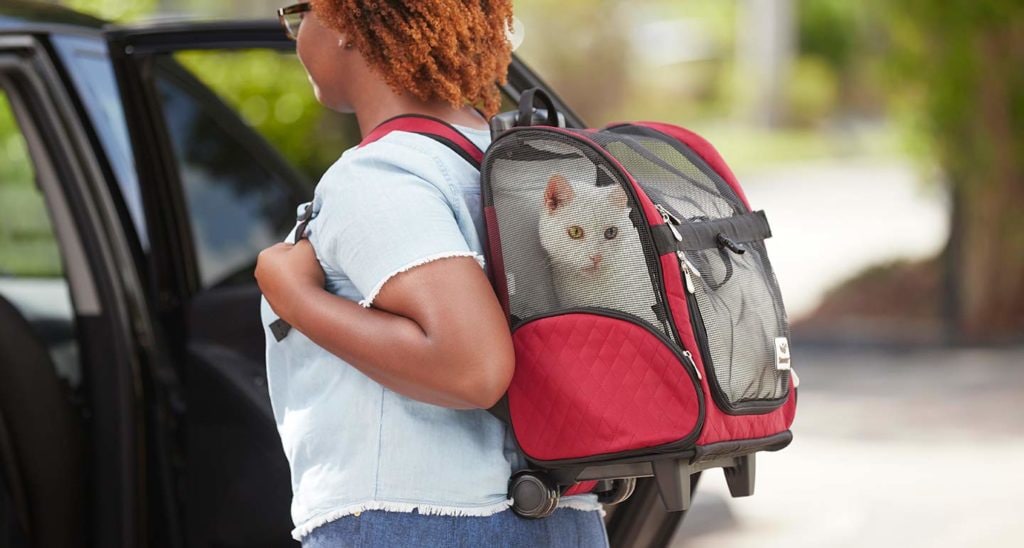
Home / BeInspired / How to Travel With a Cat by Plane, Train and Automobile
Want to know how to travel with a cat? Ask Jennie Lane. The certified animal behaviorist and owner of Synergy Animal Behavior in Germantown, Tennessee, has traveled with as many as seven cats at one time—and lived to tell the tale.
While many may believe that cats generally make terrible travel companions, it can be done. The key to successful cat travel, according to Lane, RVT, ACAAB, is to start when your cat is young so they acclimate to traveling.
“If they’re raised with travel from an early age, they can learn to love the experience,” she says.
Be aware, though, that not all cats will learn to love traveling, especially extended trips. Alice Moon-Fanelli , Ph.D., CAAB, certified animal behaviorist and owner of Animal Behavior Consultations LLC in Hartford, Connecticut, recommends leaving cats behind in many cases.
“Most cats are not good vacation travel candidates,” she says. “The majority of cats prefer to remain at home.”
But what if your cat is no longer a kitten, and you still need to hit the road for vet office visits, among other reasons? Or maybe you’re looking to try traveling with your cat for the first time? Before embarking on any trip with a cat, it is a good idea to check with a veterinarian and discuss whether the cat is prepared “physically and mentally for the planned excursion,” Lane says.
After you’ve determined that your cat is ready to ride, follow these tips to make traveling with a cat as stress-free as possible.
How to Travel With a Cat in a Car
Although your feline friend may disagree, and loudly, car travel is often the best option for a cat. Experts generally agree that the most important thing when traveling with a cat in a car is that they be kept in a proper pet carrier.
“The first thing to consider is how you are going to restrain your pet,” say Suzanne Hetts, Ph.D., and Daniel Estep, Ph.D., CAABs with Animal Behavior Associates Inc. in Sun City, Arizona.
That’s because pets can be highly distracting to drivers, and many cats have a particular affinity for climbing under a driver’s feet. But according to a July 2011 American Automobile Association and Kurgo survey, although 83 percent of drivers understand the potential danger of the distraction of a pet in a car, only 16 percent restrain their pets.
Vets generally recommend pet carriers large enough to allow the cat to stand and reposition itself.
“Put your cat in a large sturdy carrier that they can stand up in, stretch, and turn around easily,” advises the All Feline Hospital website . The Snoozer Pet Products Roll Around 4-in-1 Travel Dog & Cat Carrier measures up to 23x15.5x12.25 inches, holding cats up to 21 pounds, and comes with wheels to roll your precious pet along beside you. The MidWest Skudo Deluxe Plastic Pet Carrier is more of a classic design, made of sturdy plastic and a metal grate door that locks with the push of a button.
It is also best to keep the pet carrier in the back seat of the car, advises AAA . If an airbag deploys while your pet is in the passenger seat (even in a crate), it might injure your pet.
Because cats don’t often tolerate change as well as other pets, experts like Dr. Moon-Fanelli recommend acclimating the cat to their carrier by including treats or catnip and comfy blankets and toys. Pet parents can also take their cat on short trips to get them used to traveling. Dr. Moon-Fanelli says she would take her cat out for ice cream to associate the carrier with good memories.
Get more tips on teaching your cat to be comfortable in their carrier.
It is also important to plan stops to let cats stretch their legs and relieve themselves, and make sure all doors and windows are closed if you let the cat out of their carrier while stopped, AAA advises. Also be sure the cat is in the carrier, or in a snug cat harness and leash, such as the PetSafe Come With Me Kitty Harness , when you exit the vehicle.
Traveling With Cats on a Plane
Cats are becoming a more common sight on airplanes, although many experts recommend air travel only after other options have been eliminated.
More than 2 million live animals fly in the United States each year, according to the U.S. Department of Transportation (DOT), including more than 424,000 pets. Federal guidelines require service animals and psychiatric or emotional support animals to be allowed in-cabin on planes and fly for free under provisions in the Air Carrier Access Act .
Cats can also fly as pets for a fee in-cabin or as cargo on most major domestic carriers. Each airline sets its own criteria for the pets in regard to size. Generally, they must fit inside a pet carrier stowed under a seat and must remain there. Fees generally range from $75 to $125 for in-cabin pets and cargo rates vary. Southwest, Allegiant, Frontier, Jet Blue and Spirit airlines do not allow animals as cargo.
Read our Complete Airline Pet Policy Guide for All U.S. Airlines.
Many experts recommend against traveling with a pet as cargo, particularly cats. They say pet crates are often roughly handled, noises are loud and temperatures can fluctuate greatly during transport.
“I don’t know there’s a lot an owner can do to prepare a pet for that level of ‘over-stimulation assault,” Dr. Moon-Fanelli says.
Air travel can be particularly dangerous for brachycephalic animals, or those with "pushed in" faces, such as Persian, Himalayan and exotic shorthair cats. Because of their short nasal passages, they are particularly susceptible to changes in temperature and heatstroke as well as other environmental hazards. Due to these risks, some airlines, including United, limit the breeds of cats they allow as cargo.
Although airlines cannot limit the number of service or support animals on a flight, they often limit the number of pets allowed. If you plan to pay to bring along your cat as a pet, book early and give yourself plenty of time to check in at the airport.
Some airports impose limitations and restrictions beyond those of the airlines, so it is important to talk with your travel provider about those. For example, certain airports do not allow pet travel between certain dates when cargo temperatures may climb too high or low. Before you book, ask questions and research to reduce the potential for headaches en route.
No matter how you plan to bring your cat on a plane, be sure to provide clear identification on your cat and carrier in case of mishap or escape by the cat. If you are traveling with your cat in a carry-on, you’ll need to go through security while holding your pet; a harness and leash can also come in handy here.
If you are traveling internationally, be careful to check on added restrictions, including quarantines. Check with individual carriers about pet policies: American Airlines , Delta Air Lines , Southwest Airlines , United Airlines , JetBlue , Alaska Airlines , Spirit Airlines , Frontier Airlines , Allegiant Air .
How to Travel With a Cat on a Train
Amtrak launched a program to allow service dogs on its trains in 2016 and has since expanded to allow pet cats and dogs. Service animals are allowed on any train and can accompany the owner throughout the train, and they travel for free. Reservations should be made by calling 1-800-USA-RAIL (1-800-872-7245) in advance.
Cats, however, are generally considered “comfort animals” by the carrier and are subject to carry-on rules if they are not trained for a specific task.
The fee for carry-on pets is $26 each way for trips up to 7 hours. Before boarding, cat parents must fill out a Pet Release and Indemnification Agreement and should allow extra time at the station to review the document. One pet per passenger is allowed in coach class only. Pets must weigh 20 pounds or less, including the carrier which can be no more than 19-by-14-by-10.5 inches, and must be stowed under your seat. Carriers must be leakproof and waterproof with adequate ventilation.
Passengers can disembark with the pet at stops, when time permits, but should inform the conductor that they’re leaving and remain in proximity to the train, according to Amtrak.
Read more about Amtrak’s pet policies here .
Many metro, regional and tourist trains and subways across the country allow small pets to ride as long as they are leashed and muzzled or in carriers. Some train stations will require service animals to wear some sort of identifying vest or special identification to indicate their status.
In most cases, no proof of vaccination, health certificate, or any other paperwork is required, according to Million Mile Secrets’ train travel guide , which includes pet policies on more than 40 train carriers.
Cats may not be as popular as dogs are when it comes to four-legged travel companions, but they just may surprise you. Dr. Moon-Fanelli and Skylar became close travel buddies as she relocated often between school and jobs in her early career.
“He made many new friends, even changed the perspective of a few former ‘cat haters,’” she says. “He was a special cat.”
Featured Products
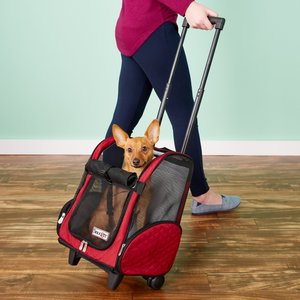
Related Posts
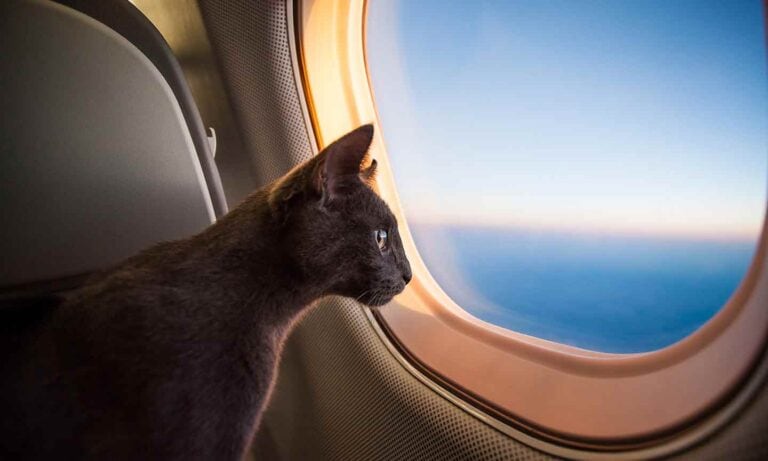
Flying With Pets: Pet Air Travel Guide and Pet-Friendly Airlines
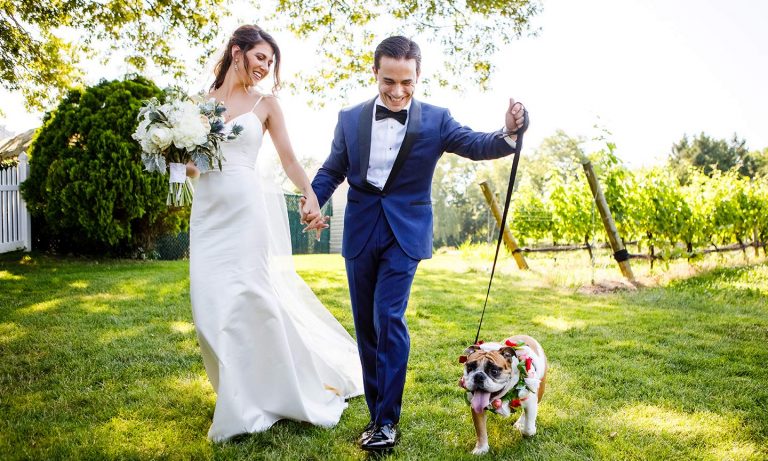
7 Unforgettable Ways to Include Your Dog or Cat in Your Wedding
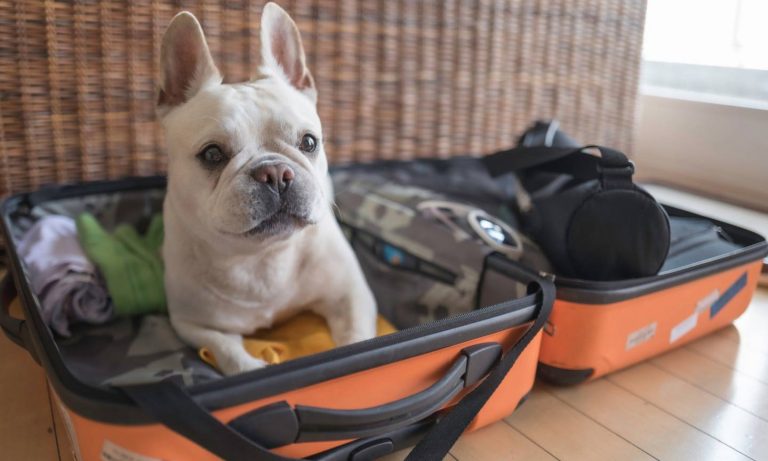
Travel Quiz: Where Should I Go on Vacation With My Pet?


Chewy Health Hour: Dr. Katy Nelson on Pet Travel Tips
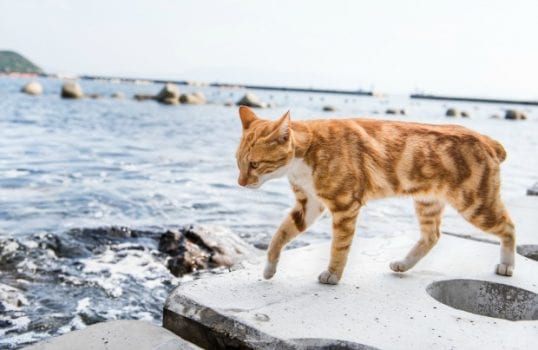
Visiting Japan’s Cat Island: An Animal Activist’s Perspective
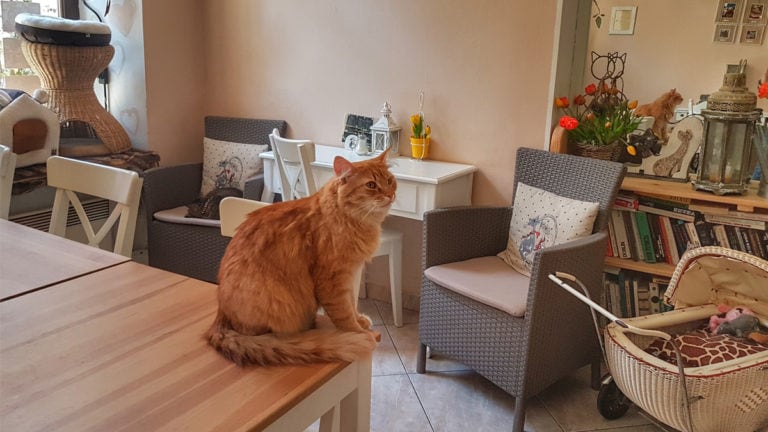
Cat Cafés Around the World
- Health & Nutrition
- View all in be well
- Style & Decor
- View all in be home
- Get Answers
- View all in be smart
- People X Pets
- View all in be inspired
- Chewy Gives Back
- Shelters / Rescues
- View all in be generous
Most Popular

By: BeChewy Editors Updated: October 10, 2023
Learn what to feed a puppy at every stage in their development with this veterinarian-approved puppy feeding guide for new puppy parents.
More Details

By: Linda Rodgers Updated: October 13, 2023
Some plants can give your pup diarrhea, others are extremely poisonous and can cause serious problems.

By: Irith Bloom, CPDT-KSA Updated: October 10, 2023
Want to know how you can potty train your dog in 7 days? Follow along on one family’s potty training journey and learn how you can housetrain your dog, too.
11 Proven Tips for Taking a Cat on a Road Trip
Published by sarah vaughan on june 7, 2021 june 7, 2021.
In March of 2021, we set off on a cross-country road trip from Virginia to California, taking our beloved cat, Fitzgerald, along with us! During that time, we’ve driven over 7,000 miles and spent more than 120 hours in the car with our furry friend. While taking a cat on a long distance road trip has its challenges, it’s absolutely doable! In this article, we’ve compiled everything we’ve learned from many hours spent in the car with Fitzgerald. We hope these tips will give you the confidence you need to hit the road with your feline companion!
Two Outliers may contain affiliate links and is a member of the Amazon Services LLC Associates Program. As an Amazon Associate I earn from qualifying purchases at no extra cost to you. For more information, see our privacy policy.
Our Story: Taking a Cross Country Road Trip with our Cat!
If you know me (Sarah), you likely know that I am a total sucker for animals – cats, dogs, horses – I love them all. When I’m not traveling, I spend my spare time fostering kittens for the SPCA. In fact, many of the pictures you’ll see in the post are of my foster kittens. And if you know the two of us, you know that our cat, Fitzgerald (aka Fitz, Fitzy, Ger, Ger Bear…), is our pride and joy.
And so, when the global pandemic hit and we found ourselves working remotely and contemplating a long-term cross-country road trip, there was never a question that we were taking Fitzgerald with us.

From Virginia to California
In March of 2021, we got rid of most our belongings, packed up what was left, subleased our apartment in Virginia and hit the road: California bound! We drove from Virginia to St. Louis in one day, then to Denver the next.
After spending one week in Denver to break up the road trip, we continued to Southern California. Over the span of that first week, we drove 2,653 miles and spent over 40 hours on the road, all with our cat!
P.S: You can read more about us here and keep up with our road trip adventures here .

A long-term road trip
Since driving across the country the first time, we’ve decided to make life on the road our permanent lifestyle and haven’t settled down yet.
Needless to say, Fitzgerald has gotten pretty used to long car rides and changing homes, and we have learned a ton about how to make him most comfortable and stress-free in the car. All in all, he’s traveled more than 4,400 miles and spent around 68 hours in the car with us!
In this article, we’ve outlined 11 tips that we use to ensure taking our cat on long distance road trips are stress-free every time ! We hope you’ll find our tips helpful for road tripping with your cat too!
Tip | About to head off on a long road trip? Check out this list of our favorite songs about travel and adventure and refresh your playlist before you hit the road!
You may also like

72 Best Songs about Travel and Adventure
11 tips for a taking a cat on a road trip.
Without further ado, here are the 11 tips we’ve learned from long distance travel with a cat in the car long-distance road tripping with Fitzgerald.
We hope these insights will help keep you and your feline companion stress free on the road!
- Try to stop as little as possible
- Get your cat a collar with tag for traveling
- Bring a familiar comfort item from home
- If possible, make one long trip rather than several shorter trips
- Create a “safe space” in the car for your cat to retreat to
- If your cat is especially nervous, try feline anxiety medication
- Try letting your cat roam free, but always pack a cat carrier just in case
- If you must crate your cat, leave the carrier out several days before your trip
- Pack your cat’s litter box, filled with clean litter
- Take away your cats food the night before the trip
- Set up a small, quiet place for your cat to rest at your final destination
Please note that these tips are based on our own personal experience road tripping with cats. All cats have different personalities and may react differently in the car! We are not veterinarians – please consult with your cat’s vet about the best way to travel with your cat in the car.

1. Try to stop as little as possible
When you first get in the car, your cat will be nervous (no matter how relaxed he/she normally is). However, most cats will settle in after a few minutes of adjusting to their surroundings and the motion of the car.
Each time you stop, there are new sights, sounds, and smells for your cat to take in, and he/she may become unsettled all over again. To minimize your cat’s stress, try to make as few stops as possible.
Pack snacks and lunches, fill up on gas the night before and only stop when absolutely necessary. In general, cats don’t like change, so trying to create a consistent environment is key.
2. Get your cat a collar with tag for traveling
My biggest fear when hitting the road with Fitzgerald is that somehow he’ll escape at a gas station or rest area and be lost forever! A bit dramatic, I know, but cats are so sneaky and it’s easy to imagine him getting startled and darting out the door.
I got Fitzgerald a collar and tag with his name and both our phone numbers engraved on the tag, and it gives me serious peace of mind to know that if he somehow gets lost, we at least have a solid chance of getting him back.
- For an extra layer of protection, attach a tracking device ( Apple Airtag or Tile ) to your cat’s collar.
Tip: You can get an inexpensive collar and engraved name tag super easily at most pet supply stores.

3. Bring a familiar comfort item from home
Fitzgerald has absolutely loved this old, raggedy orange blanket since he was just a little kitten. At home, he’ll knead, or “make biscuits,” on it all the time before he naps. It’s definitely his favorite comfort item (or security blanket, if you will)!
Whenever we road trip, we bring this blanket and make sure he has a comfy spot to curl up with it. If your cat has a favorite toy, blanket, bed, etc., it’s a great idea to bring with you! A little hint of familiarity from home can bring some comfort to your cat in a new environment.
Side note : When cats “make biscuits” like Fitzgerald does, they are replicating the act of nursing, and it’s typically because they lost their mother too early as a kitten.

4. If possible, make one long trip rather than several shorter trips
Let’s say you’ve got a 12 hour drive coming up. You may think it’d be best for your cat if you split this long drive up into two shorter 6 hours drives, stopping for the night along the way. In our experience, however, it’s actually better to just go for the full 12 hours at once.
Cats hate change , and one long drive means less change than 2 shorter drives. Typically, the most stressful parts of the road trip are getting into the car and settling into a new place at your destination.
Taking several shorter trips means more adjusting to the car and more adjusting to temporary new homes when you stop.

5. Create a “safe space” in the car for your cat to retreat to
This is especially important if your cat is a “hider.” Set aside a comfortable space in the car for your cat to retreat to when he or she gets scared.
We typically pack Fitzgerald’s cat carrier and leave it open with some toys and blankets during the car ride in case he wants to curl up in his own little “safe space”. He ends up spending most of his time in the car lounging inside the carrier.

6. If your cat is especially nervous, try feline anxiety medication
You should only try medication as a last resort . Many cats will be perfectly fine in the car without medication, as long as you take appropriate steps to keep them comfortable.
But if your cat is particularly anxious, it may be a good idea to talk to your veterinarian about anxiety medication to keep them calm in the car.

7. Try letting your cat roam free, but always pack a carrier just in case
We’re very lucky that Fitzgerald has a laid-back demeanor, and we’re able to let him roam free in the car. He typically spends his time in the car either sleeping on our laps, perched up on our piles of stuff looking out the window, or curled up in his carrier.
If your cat is laid back in the car, you may want to try to let them roam free, at least to start out. Having some space to move around will make your cat happier, and hopefully, mean less whining.
It’s a good idea to test this out with a short trip , and whether it’s a good idea for you depends on your cat’s personality. If you are traveling alone, it’s best to keep your cat in the crate since you will have no one to help you in the event that the cat starts to become a distraction.
That being said, safety should always come first. If your cat starts to try to get under your feet or becomes a serious distraction to your driving, it’s better to be safe and crate them. Always pack a cat carrier or small crate just in case, even if you don’t think you’ll need it.

8. If you must crate your cat, leave the carrier out several days before your trip
If you plan on crating your cat, it can be helpful to leave your car carrier out in your home a few days prior to your trip. Put some of your cats favorite toys, blankets, or bed in there and let them get used to being in the crate before the trip.
Doing so will give your cat some time to adjust to life in the crate and reduces the chance they will freak when it comes time for your road trip.
9. Pack your cat’s litter box, filled with clean litter
Cat’s have an amazing ability to hold in their urge to go to the bathroom. That being said, sometimes the urge can be overwhelming and your cat will need to use the litter box on the road, particularly if you are road tripping long distance . Make sure their litter box is accessible in the car so they can relieve themselves if nature calls.
Most importantly, make sure the litter box is clean before you leave! You do not want to be stuck in the car with a dirty litter box for hours.
The smell of clean litter can be overwhelming on its own! We recommend getting a covered litter house with a door , if you don’t have one already, to help contain the smell and reduce the likelihood of any litter spills.
10. Take away your cat’s food the night before the trip
Your cat might be mad at you for taking away their food, but trust us, it is not as bad as a puking cat at the start of a road trip.
Our cat, Fitzgerald, usually does great on road trips but both times we’ve forgotten to take away his food, he has thrown up within an hour of being in the car. The first time we were lucky and he made it to his litter box. The second time, he barfed all over Matt’s legs in the passenger seat. Not fun for felines or humans!
To reduce the chance of any pukey cats, take away their food before going to bed the night before your trip. They may whine at first but they will be okay, and you will definitely be thankful when you have a barf-free car ride!
11. Set up a small, quiet place for your cat to rest at your final destination
How you introduce your cat to his/her new environment is just as important (if not more!) to your cat’s mental health as how you handle the car ride.
Like we’ve said, cats do not handle change well so giving them time and space to adjust to new surroundings is super important. They will also likely be tired from a long and stressful journey in the car.
Once you get to your final destination, it may take some time for your cat to warm up to their new surroundings. This is perfectly normal. Try to make them feel as comfortable and safe as possible by setting up a quiet place for them to rest and adjust.

Road trip packing list for your cat
To help you prepare for taking your cat on a long distance road trip, we’ve summarized the most important items to pack:
- A favorite item from home: make sure you have something available in the car that reminds your cat of home and brings them a sense of comfort. This can be anything – a favorite toy, blanket, pillow, bed, etc.
- Cat carrier : for moving your cat to and from the car, and just in case you need to contain your cat while driving.
- Collar and leash with name tag : for moving your cat to and from the car, and just in case your cat gets loose.
- Litter house (with a door) : so your cat can use the bathroom while in the car if necessary, without spilling litter everywhere.
- Comfortable bed or blanket: If you are traveling with a fully loaded down car, make sure you have a comfortable spot for your cat to relax.
- Anxiety medication: if needed, talk to your vet
- Treats! But only for after you arrive at your final destination (Fitzgerald’s all time favorites are Temptations Shrimpy Shrimps )
- Scratching post : At home Fitzgerald loves his scratching post with hammock . Even though its a bit bulky, we always bring it with us on road trips because it means he won’t scratch up furniture at our Airbnb/hotel/short-term rental. 100% worth the space it takes up!
Other Useful Resources
Planning a road trip? You may also be interested in the following resources:
- Road trip | 59 Best Songs About Travel and Adventure
- Road trip| Complete List of Road Trip Camping Essentials
- Road trip | 27 Highlights of Our Life on the Road in 2021
- Road trip | The Ultimate 1 Week Arizona and Southern Utah Road Trip
- Road trip | How to Plan an Epic Utah National Parks Road Trip
- Road trip | Texas to California: 14-Day Itinerary
With the right preparation, you can ensure that both you and your cat have a low-stress and safe road trip experience. Let us know if you have any questions as you get ready to hit the road or other tips you use to make road tripping with your furry friend a breeze .
Sarah Vaughan
Hello! I'm Sarah, one half of the couple behind Two Outliers! In 2023, I quit my job as a Data Scientist to travel around the world on an epic 15-month journey in search of the world's greatest hikes and outdoor adventures. Matt and I started Two Outliers in 2021 as a place for visitors to find concise, accurate, and honest information to plan their own adventures. We hope our experiences inspire you to hit the trail! Happy Hiking! Sarah
11 Comments
Judy McCormick · September 4, 2022 at 8:32 am
We bought a large, comfortable carrier for our back seat that has it’s own litter box, but, made the mistake of giving him treats before we left which our cat threw up and, ended up sitting in the litter box! Will definitely take advice about stopping food night before, and think will try to have his regular litter box outside the carrier, because it is very hard to clean that carrier! Are planning to take him to Florida in February, and, appreciate any help we can get! Would like to know if you should try to give food and water to your cat while traveling?
twooutliers · September 11, 2022 at 5:32 pm
Hi Judy! We typically give Fitzgerald water while traveling (especially on longer trips) but try to avoid giving him food if possible because we’ve found that it upsets his stomach in the car. Also, we have a litter box house with a lid that does wonders to prevent the mess in the car! It’s definitely a bit large, but we like to give him the option to have it and it’s pretty easy to take with us.
Marcus Koolmees · August 30, 2022 at 5:34 am
Thanks for this article, I was wondering though: Do you let Fitzgerald roam free outside when you get to the new location? I’d be worried of the cat walking off / getting lost?
Jenny Wong · August 18, 2022 at 2:06 pm
What a fantastic well written article! I am potentially moving from Ontario, Canada to Alberta, Canada which is a 45 hour or more car ride if we make no stop. We plan on making stops. This was a great read and I’ve wrote down some notes. I will for sure also talk to my veterinarian for further advice.
twooutliers · August 22, 2022 at 9:47 pm
Thanks so much! We were just in Alberta – it’s one of our absolute favorite places!
Syd · July 12, 2022 at 1:55 pm
Most of this seems like very solid advice, but I genuinely don’t think letting the cat roam about in the car while it’s moving is a good idea, given that the cat could easily get around the pedals and potentially cause a very dangerous situation. Every vet I’ve ever been to heavily emphasized even on short trips taking your cats in carriers specifically because of this. They may be somewhat less happy about the situation, which does suck, but is likely better than the potential death of everyone in the vehicle.
twooutliers · July 13, 2022 at 8:39 pm
Hi Syd, completely see your point. I think it depends a ton on the personality of the cat. We’ve traveled thousands of miles in the car with our cat and never had any trouble. But certainly, not all cats are as laid back, so whether it’s a good idea definitely varies and should be up to the cat’s owner who knows their personality best. We’d also never do this if traveling alone, in case the cat starts to become distracting or tries to get under the driver’s seat. I’ve updated that section to include a few extra words of warning on this 🙂
Sherry Kirchoff · May 30, 2022 at 11:02 pm
Thanks bunches for your amazing tips for taking Fitzgerald on car trips! My child and I have two rescued cats, and our trip is going to be 14 hours plus delays/stops. I designed the cats’ collar tags (HippieClecticHope on Zazzle), but I was otherwise clueless about preparation (I don’t normally travel, let alone with passengers).
twooutliers · June 8, 2022 at 8:41 am
Hi Sherry, best of luck with your trip! Hope you and your cats have a safe drive. That’s so cool that you designed the collar tags yourself!!
Alexandra Romanyshyn · May 20, 2022 at 12:11 pm
A lot of great advice here! Just to add on: if you do let your cat roam free in your car, be sure to disable your airbags. Airbags are deployed with enough force that they can crush an animal, or even a carrier. God forbid you do get into an accident, the safest place for your pet will be in a crate buckled into the back seat, which will prevent them from getting jostled around as much and also protect them from airbags. There are many articles on this issue, but here’s one for starters: https://www.express.co.uk/life-style/cars/1427837/driving-animals-pets-road-safety-airbags-danger
twooutliers · June 5, 2022 at 5:49 pm
Hi Alexandra, that’s a great point, thanks so much for the tip!
Leave a Reply Cancel reply
Related posts.

Backpacking Baron Lakes Idaho: Complete Trail Guide
The Alice Toxaway Loop in Idaho is a minefield of amazing teal-blue alpine lakes, framed by the jagged peaks of the Sawtooth Mountains.

Grand Teton Inspiration Point & Hidden Falls Trail Guide
Nestled in the foothills of the Grand Tetons, Bradley Lake makes for a great spot to enjoy head on views of the iconic rocky peaks.

Adventure Activities
The ultimate packing list for road trips (plus road trip checklist).
Living full-time on the road with only our mid-sized Subaru means we've perfected our packing list for road trips, and we're excited to share it with you!
Discover more from TWO OUTLIERS
Subscribe now to keep reading and get access to the full archive.
Continue reading
Traveling with cats in the car
Make traveling with cats in the car much more smooth with our guide, whether you’re moving across the country or visiting the vet

Traveling with cats in the car may sound daunting, but it doesn’t have to be. Cats are generally not big fans of travel and would much rather stay curled up in the comfort of their own home. However, there is plenty you can do to make for a stress-free trip with your kitty from researching the best cat carriers to making the car a more comfortable environment. Whether you’re taking a short trip to the vet or cattery, going away on holiday or moving home, this guide will provide you with all the information you need for a safe and happy pet.
How long can a cat travel in a car?
There are no specific regulations for how long a cat can travel in a car. They are able to travel for extended periods of time as long as they are comfortable and their basic needs are met. Their carrier should be the right size, made of a sturdy material, well-ventilated and with a favorite blanket inside. Make sure they have enough water, food and a litterbox to do their business in. It is generally recommended that they do not travel for more than six hours and you shouldn’t keep your cat in a carrier overnight. If possible, take them out to let them stretch and go to the bathroom every two to three hours. How often they will need to stop will depend on the individual cat so it’s important to understand their needs and how often they will want to eat and relieve themselves.
How do you take a cat on a long car journey?
This is everything you need to know to travel with a cat in the car:
Start early The younger you can get your cat used to traveling in a car the better. You want to get them used to it so it’s just as easy to take them to the vet as it is to move house with them.
Check their health Make sure your cat is up to date with their health checks at the vet to avoid any problems when traveling. Start with shorter drives first, not only to acclimatize your cat, but to rule out any other issues such as motion sickness in case they need any medication.
Make sure they’re secure and comfortable Be sure to research the right carrier for your cat. It should be the right size, sturdy and ventilated. Try a carrier where the top comes off to make it easier to get your cat into it. Make sure it is secure in one of the back seats using a seatbelt and that your cat is comfortable by putting their favorite blanket, toys and treats inside. You will also want to adjust the temperature of your car accordingly.
Pack extra bedding Take extra bedding and paper towels in case there are any accidents.
Food and water Your cat should have access to food and water while they travel, but you may not want to feed them in the hours before your journey in case it makes them ill.
Take breaks Plan stops throughout a long journey so your cat can stretch and go to the toilet if they don’t have a travel litterbox. Pack a cat harness and leash for a safe way for them to get some exercise during their breaks.
Don’t leave them Never leave your cat in the car as your vehicle can easily heat up and be unsafe for your cat. Instead make sure you pack food and take them with you when you stop for any reason.

How to keep a cat calm in the car
The best way to ensure your cat is safe and happy during your travels is to keep them calm. As well as thinking about their comfort, here are just some of the ways you can do this:
Get your cat used to their carrier by keeping it out in the house instead of stored away. Leave the door open and put their favorite blanket and treats inside. Once they are comfortable sitting in it, take them for a short trip around the block before going on a longer journey.
Play with your cat before you leave the house so they feel loved and safe with you.
Use pheromone spray or wipes on their blanket or carrier which will imitate familiar smells to make your cat feel more secure in an unfamiliar situation or environment.
As well as placing a blanket inside your cat’s carrier, you may want to think about covering the top of the box with a breathable blanket to give them privacy if they’re feeling vulnerable.
If they do not cope well with traveling, give them an oral sedative 1.5 -2 hours before you travel, but consult with your vet first about the best cat sedatives .
The car is a new environment for your cat so make sure it is as comfortable and as friendly as possible. Check the temperature, don’t play your music too loudly, speak to your cat in a soft, gentle voice while you travel and try to drive without braking too hard or taking sharp turns.
If you want to take breaks, research pet-friendly hotels ahead of time.
You may think of traveling with a friend who can keep your cat calm while you focus on driving.

Cats in cars: The law/Can you travel long distance without a carrier?
While traveling without a carrier is legal in the UK and in most US states as long as your cat is properly restrained, you could still get in trouble as there are laws against dangerous driving. Traveling without a cat carrier is not recommended as if they distract you this could pose a danger on the road and risk a fine, prosecution or an accident. Carriers are the best way to make sure your cat is safe; however if you don’t want to buy one, there are other options if you want to know how to transport a cat without a carrier such as a cardboard box or pet seat belt.
Cat car travel litter box vs cat carrier for the car
There are pros and cons for both a travel litter box and a carrier for the car. If you don’t want to stop as often when traveling with a cat, you’ll need a travel litterbox, but you may not like the idea of having your cat do their business in the car. There are lots of different types so make sure you do your research to ensure you buy the best carrier or best travel litterbox . Portable litterboxes are lightweight so easy and convenient to carry. Disposable litterboxes are smaller and cheaper, but may work better for shorter trips as they may leak on longer trips. The benefit of a self-cleaning travel litterbox is that they don’t need cleaning every time your pet relieves themselves; however they take up more space in the car and they can be expensive. A cat carrier with a litterbox built into it offers two in one but again these can be costly. Cats may not need to relieve themselves for up to eight hours, but do you want to risk it? If you don’t want a litterbox in the car, make sure you know how often your cat is likely to need to do their business and make frequent stops. You can also place pee pads in their carrier in case of any accidents, but ideally choose one of the options above.
PetsRadar Newsletter
Get the best advice, tips and top tech for your beloved Pets

Is it normal for a dog to sleep all day?
Do cats know we love them? An expert has the answer
32 reasons to love St. Bernards
Most Popular
- 2 32 ways your dog shows they love you
- 3 32 easiest cat breeds to train
- 4 Is it normal for a dog to sleep all day?
- 5 32 reasons to love Burmese cats
- PRO Courses Guides New Tech Help Pro Expert Videos About wikiHow Pro Upgrade Sign In
- EDIT Edit this Article
- EXPLORE Tech Help Pro About Us Random Article Quizzes Request a New Article Community Dashboard This Or That Game Popular Categories Arts and Entertainment Artwork Books Movies Computers and Electronics Computers Phone Skills Technology Hacks Health Men's Health Mental Health Women's Health Relationships Dating Love Relationship Issues Hobbies and Crafts Crafts Drawing Games Education & Communication Communication Skills Personal Development Studying Personal Care and Style Fashion Hair Care Personal Hygiene Youth Personal Care School Stuff Dating All Categories Arts and Entertainment Finance and Business Home and Garden Relationship Quizzes Cars & Other Vehicles Food and Entertaining Personal Care and Style Sports and Fitness Computers and Electronics Health Pets and Animals Travel Education & Communication Hobbies and Crafts Philosophy and Religion Work World Family Life Holidays and Traditions Relationships Youth
- Browse Articles
- Learn Something New
- Quizzes Hot
- This Or That Game New
- Train Your Brain
- Explore More
- Support wikiHow
- About wikiHow
- Log in / Sign up
- Pets and Animals
- Travel with Cats
How to Travel with a Cat
Last Updated: January 13, 2023 Approved
This article was co-authored by Pippa Elliott, MRCVS . Dr. Elliott, BVMS, MRCVS is a veterinarian with over 30 years of experience in veterinary surgery and companion animal practice. She graduated from the University of Glasgow in 1987 with a degree in veterinary medicine and surgery. She has worked at the same animal clinic in her hometown for over 20 years. wikiHow marks an article as reader-approved once it receives enough positive feedback. This article has 13 testimonials from our readers, earning it our reader-approved status. This article has been viewed 651,051 times.
Most people do not relish the thought of bringing their cats with them on a vacation or on a road trip. There are a few fearless felines that are not finicky about traveling, but for many cats, traveling and leaving their familiar surroundings can be sheer terror. However, it is possible to travel with a cat without a huge amount of problems. The key is to the prepare ahead of time by acclimating your cat to travel gradually and preparing supplies well before the departure date.
Preparing Ahead of Time

- Give your cat treats while it is in the car. This will give it better feelings about being there.
- Look upon these as trial runs to work out any kinks before you have to take a long trip far from home.

- The signs of a cat with motion sickness (while in the car of course) include: crying or vocalizing that doesn’t quit after a few minutes into the car ride, excessive drooling, immobility, or acting afraid to move, or excess activity or pacing, vomiting, or urinating or defecating.
- Ginger has also been used to treat nausea in humans and it is safe to use in cats; this can be found in liquid form or chews from on-line or brick and mortar pet stores or in the occasional veterinary clinic.

- Discuss dosages with your veterinarian and follow their advice carefully for the best result.

- Most sedatives won't knock the cat out cold and should only take the edge off. If the drug is too sedating or not sedating enough, you should let your vet know before you leave. The cat should remain alert to its surroundings, even when on the sedative.
- While on the medication trial, put the cat in the carrier and take it for a drive. This way, you'll know what behaviors to expect while you're traveling with a medicated cat. Make sure your vet gives you enough medication for the duration of your travel (to and from) and ask for an extra pill or two to try at home before you embark.

- Be sure to test your cat's reaction to Feliway before spraying it in the carrier. A small minority of cats interpret the spray as another cat's markings and may have a negative or even aggressive reaction to it.
Taking Your Cat on a Trip

- Never make your cat stay in its carrier for longer than eight hours without providing it with food, water and a chance to use the litter box.

- The carrier should be placed in a secure spot in the car, preferably strapped in place with a seat belt. If the seat belt won’t work, you can use bungee cords or small lengths of rope to secure the carrier in the car in case of sudden stops or an accident. [4] X Research source

Expert Q&A

- Note that airlines will not accept a sedated animal because it is more difficult to know if it is experiencing any health problems, including heat stroke. If you are making a long drive to the airport with your cat do not give it a sedative as it will not be able to fly. Instead, Rescue Remedy is an acceptable calming alternative as the animal remains fully alert. Thanks Helpful 1 Not Helpful 0
- Don't forget to bring a scratching post or cardboard scratch pad! People have a tendency to forget this, and it may cause your cat to resort to scratching on unwanted surfaces, such as the hotel curtains or bedspreads. Cats need to scratch; not only is it instinctual, but it also allows them to get a good stretch and use muscles they wouldn't normally use. Thanks Helpful 0 Not Helpful 1
- On long trips with more than one cat, a large collapsible dog carrier that fits in the back seat is a great option. You can fit in a small covered litter box that doubles as a cat booster seat to look out the window, in addition to having room for a cat bed, food, water and toys. The zippered screened sides allow for easy access, as well as letting your cat see you and the scenery out the window. The larger carrier doubles as a safe place when visiting others with pets if you need to go out, as the cats can still use the litter box and have room to move around. Thanks Helpful 2 Not Helpful 0

- Make sure your cat is wearing the collar and ID tags at all times! You never know if your cat will somehow weasel its way away. A microchip with up to date information on record with the chip company is a never-loose ID tag. A rescuer will need to have a vet or shelter scan it to get the number. Thanks Helpful 37 Not Helpful 13
- Do not allow a cat unrestricted access to your car when you're driving. Even the smallest things can spook a cat, and the last thing you need is a cat hiding in the back of your car, under the seat where you can't reach it, or dashing under your feet to the pedals. If you're riding with passengers and your cat likes to look out the window, putting a harness and leash on and allowing the cat to sit that way may not be a bad idea. Be careful your cat does not become agitated about it, however. Thanks Helpful 28 Not Helpful 11
- Never leave your cat in the car alone, even with the windows cracked. It can take less than twenty minutes for your pet to overheat and die when left in a car. Thanks Helpful 0 Not Helpful 0
Things You'll Need
- Food and water dishes
- Cat carrier
- Small towel or blanket
- Scratching post or pad
- Cat toys, string
- Cat harness and leash
- Cat collar with ID tags
- Enzyme based cleaner in case your cat has an accident in the car or hotel.
- Rescue Remedy spray
- Medications
You Might Also Like

- ↑ http://www.petmd.com/cat/conditions/digestive/c_ct_motion_sickness?page=2
- ↑ http://www.vcahospitals.com/main/pet-health-information/article/animal-health/motion-sickness-in-cats/6528
- ↑ http://www.feliway.com/uk/What-causes-cat-stress-or-anxiety/Traveling-with-a-cat-in-a-cat-carrier
About This Article

To prepare your cat for travel, make sure your cat eats and drinks several hours before traveling and has access to the litter box until it's time to go so it doesn't need to go on the road. Right before putting your cat in its crate, place a harness on it so you can easily leash your cat when you open the crate. Plan to let your cat out to stretch its legs every few hours, and use the leash to keep your cat from running away! For more tips from our Veterinarian reviewer, including how to use pheromones to keep your cat calm, keep reading! Did this summary help you? Yes No
- Send fan mail to authors
Reader Success Stories
Debra Bassett
Jul 14, 2016
Did this article help you?

May 2, 2017
Lilbelle Larson
Apr 14, 2017
Caden Briggs
Oct 7, 2016
Kim Ostgard
Oct 10, 2018

Featured Articles

Trending Articles

Watch Articles

- Terms of Use
- Privacy Policy
- Do Not Sell or Share My Info
- Not Selling Info
Get all the best how-tos!
Sign up for wikiHow's weekly email newsletter
Best overall
Best expandable, best stylish, best budget.
- What to look for
- How we tested
How to prepare a cat for flying
The 4 best airline-approved cat carriers of 2024, tested and reviewed.
When you buy through our links, Business Insider may earn an affiliate commission. Learn more
Air travel with a cat is stressful, but one of the best airline-approved cat carriers can make it easier. When a cat is flying at your feet in the plane cabin, a durable soft-sided carrier with some key features will ensure your pet's comfort and safety, and your peace of mind.
To select the best carriers for flying with a cat, we spoke with a veterinarian and pet travel experts and tested 24 different airline-friendly pet carriers. Our top pick, the Sleepypod Air , is as durable as it is comfortable for pets and humans alike. If you're looking for a more affordable airline cat carrier, the simple Frisco Premium Airline Compliant Quilted Carrier Bag will keep your kitty comfortable from the beginning to the end of your journey.
Keep in mind that carrier size requirements vary by airline. Delta , American Airlines , and United allow pet carriers up to 18 inches (L) by 11 inches (W) by 11 inches (H). Some airlines have smaller maximum sizes, so make sure to check the airline's website before embarking with your pet.
Read more about how Insider Reviews tests and researches pet products .
Our top picks for the best airline-approved cat carriers
Best overall: Sleepypod Air - See at Chewy
Best expandable: Mr. Peanut's Gold Series Expandable Carrier - See at Amazon
Best stylish: Diggs Passenger Travel Carrier - See at Amazon
Best budget: Frisco Premium Airline Compliant Quilted Carrier Bag - See at Chewy
The crash-test-certified Sleepypod Air has plush bedding, optimal ventilation, and a roomy interior to keep cats calm and comfortable in the air and on the ground.
- Check mark icon A check mark. It indicates a confirmation of your intended interaction. Optional privacy screen
- Check mark icon A check mark. It indicates a confirmation of your intended interaction. Double-layered mesh
- Check mark icon A check mark. It indicates a confirmation of your intended interaction. Crash-test certified
- Check mark icon A check mark. It indicates a confirmation of your intended interaction. Ample storage
- Check mark icon A check mark. It indicates a confirmation of your intended interaction. Padded carry handle
- Check mark icon A check mark. It indicates a confirmation of your intended interaction. Washable interior mat
- Check mark icon A check mark. It indicates a confirmation of your intended interaction. Unzips into bed or car seat
- con icon Two crossed lines that form an 'X'. Carry handle may cause discomfort for those with larger hands due to its small size
- con icon Two crossed lines that form an 'X'. Expensive
Our cat testers weren't shy about expressing their clear preference for the Sleepypod Air. During a recent trip to the vet, they both piled into the carrier, opting for its cozy sanctuary over their other carrier. The Sleepypod Air's plush bedding, just-right ventilation, and spacious interior proved calming and comfortable. For skittish fliers, the carrier includes a privacy screen you can slide through the mesh top, though this significantly reduces your cat's access to fresh air.
The carrier stands out for its innovative design and commitment to pet safety — it's certified by the Center for Pet Safety (CPS), a nonprofit consumer advocacy organization that researches and crash-tests pet carriers to ensure their safety. Rather than doors, it features one continuous zipper that runs end to end. With one pull of the zipper, the carrier transforms into an open bed, converts into a car seat, or rolls up for convenient storage. It's also designed to fold in approximately 2.5 inches at each end, meeting the size requirements of most major airlines. We recommend practicing compressing the bag before your trip.
The padded cross-body shoulder strap felt supportive, and the carrier rested comfortably against the body without collapsing inward. With the luggage strap, the carrier easily stayed balanced on a suitcase when rolling over curbs and rough sidewalks.
The Sleepypod Air isn't cheap. However, given its versatility, comfort, and impressive safety features, we believe it's well worth the investment. You can return it, used or unused, within a year, and Sleepypod guarantees a replacement if it's damaged in an auto accident.
Mr. Peanut's Gold Series Expandable Carrier unzips to almost double in size, providing a cat with extra room on long travel days.
- Check mark icon A check mark. It indicates a confirmation of your intended interaction. Front and top-loading carrier
- Check mark icon A check mark. It indicates a confirmation of your intended interaction. Expandable compartment for more space
- Check mark icon A check mark. It indicates a confirmation of your intended interaction. Secure luggage strap
- Check mark icon A check mark. It indicates a confirmation of your intended interaction. Padded detachable shoulder strap
- Check mark icon A check mark. It indicates a confirmation of your intended interaction. Washable interior bed
- Check mark icon A check mark. It indicates a confirmation of your intended interaction. Easy to store
- con icon Two crossed lines that form an 'X'. Limited pocket space
- con icon Two crossed lines that form an 'X'. Expandable section can't be used in flight
- con icon Two crossed lines that form an 'X'. No warranty
On long travel days with time spent in airports, Mr. Peanut's Gold Series Expandable Carrier offers jet-setting cats extra space to stretch out. It includes a zippered panel on its right side that unfolds into a mesh atrium that nearly doubles the carrier's interior space. While the expandable section can't be used in flight, this feature makes it the best airline-approved cat carrier for cross-country flights with layovers and extended stays away from home.
The spacious carrier is front- and top-loading with a roll-up privacy flap over the top door, and it offers plenty of ventilation to keep a cat from overheating. Inside, there is a soft plush bolster bed and safety tether. Outside, it has an adjustable padded shoulder strap and a faux leather carry handle. There is one 10-inch by 4-inch mesh pocket on the backside.
With sturdy mesh screens and smooth zippers, Mr. Peanut's carrier excelled in our testing. It was easy to spot clean, and although the bed is labeled hand-wash only, it came out of the washing machine looking nearly new after air-drying.
When we tested the luggage strap, the carrier remained mostly balanced on our suitcase, slipping only about an inch to one side. Carrying it on the shoulder was comfortable, and the strap was easy to adjust to the correct length.
The Diggs Passenger Travel Carrier stands out for its eye-catching design that prioritizes safety in the air and at your destination, all without compromising on convenience or comfort.
- Check mark icon A check mark. It indicates a confirmation of your intended interaction. Multiple pockets
- Check mark icon A check mark. It indicates a confirmation of your intended interaction. Side panel opening for easy access
- con icon Two crossed lines that form an 'X'. Offers the least ventilation of the carriers tested
- con icon Two crossed lines that form an 'X'. Interior mat is spot-clean only
The Diggs Passenger Travel Carrier not only looks great but also prioritizes safety. Like the Sleepypod Air, it is crash-test certified by the CPS . It also has an interior safety tether and a zipper-locking mechanism to prevent unintentional openings during transit.
The cushy interior mat provides maximum comfort for your kitty copilot while the padded cross-body and secure luggage straps ensure that your precious cargo has a smooth journey from point A to point B. We also appreciate the thoughtful conveniences for human travelers, including three pockets for storing your or your cat's belongings, including a large 16-inch by 6-inch front zipper pocket. There's a D-ring to clip your keys too.
In case of accidents, the carrier comes with one custom-fitted pee pad (more sold separately) that you can access via a side panel to minimize disturbing your pet. The nylon fabric carrier has a moisture-resistant quality that causes liquids to bead up on contact, so bigger messes won't readily adhere. However, the mat has a bolstered edge where gunk can get stuck, so you'll want to thoroughly spot-clean the interior cushion once you reach your destination.
Despite the carrier's 20-inch length, each side compresses by an inch, ensuring it meets most in-cabin airline regulations. Despite the carrier's 20-inch length, each side compresses by an inch, ensuring it meets most in-cabin airline regulations. The width of the carrier also exceeds airline regulations by a half inch but as long as you don't overstuff the side pocket, it can compress.
This Frisco cat carrier is a cozy and budget-friendly option that holds up well to wear and tear.
- Check mark icon A check mark. It indicates a confirmation of your intended interaction. Two loading doors
- Check mark icon A check mark. It indicates a confirmation of your intended interaction. Velcro-secured pocket
- Check mark icon A check mark. It indicates a confirmation of your intended interaction. Holds large cats
- Check mark icon A check mark. It indicates a confirmation of your intended interaction. Comes with ID tags and collapsible travel dish
- con icon Two crossed lines that form an 'X'. Shoulder strap lacks padding
- con icon Two crossed lines that form an 'X'. Luggage strap not as secure as other carriers
- con icon Two crossed lines that form an 'X'. Only one color option
Although this carrier is a fraction of the price of our other picks, it still performed well in durability testing. At home, it was also the carrier our tester cats consistently chose to lounge in time and time again. Simply put, the cozy Frisco Premium Airline Compliant Quilted Carrier Bag is an excellent budget airline cat carrier.
Susan Nilson , a cat and dog trainer and behavior specialist, recommends leaving a carrier with the doors open at home so your cat can get accustomed to it before travel. We did just that, and the carrier quickly became one of our cats' favorite spots to nap. Even after machine washing the interior fleece mat, it didn't lose its softness or cat appeal.
The carrier has two doors, top and side, and two storage pockets: a secure Velcro pocket to stash your keys and phone and a mesh pocket to keep your cat's treats and travel documents easily accessible. The included collapsible silicone bowl and ID tag ticks two essentials off your packing list.
The adjustable shoulder strap and carry handle lack padding and may become uncomfortable on longer journeys. Similar to pricier options, the Frisco carrier includes a luggage strap designed to attach the carrier to the telescopic handle of your suitcase. However, the strap doesn't keep the carrier well-balanced on curbs and sidewalks, so you'll want to have a free hand for added support.
What to look for in an airline cat carrier
Cat carriers come in many different styles at varying price points. To ensure you get the best value for safety and comfort, our experts recommend considering the following factors when shopping.
Safety: Unlike child car seats, there are no universal safety standards or inspections for cat carriers. However, some brands go the extra mile by subjecting their carriers to rigorous testing by reputable third-party or nonprofit safety organizations. Among our recommended picks, the Sleepypod Air and Diggs Passenger Travel Carrier have been crash-test certified by the Center for Pet Safety (CPS), a nonprofit consumer advocacy organization that studies the safety of pet products.
Currently, CPS studies do not extend to air travel and flight safety. Despite the absence of standardized air travel safety tests, crash-test certification remains the gold standard. As Lindsey Wolko, founder and CEO of CPS, points out, you'll want to consider your entire journey, including driving from your home to the airport and transportation at your destination.
Wolko says carriers are most susceptible to failure at seams where the mesh connects to the carrier body. She recommends inspecting carriers for any signs of loose threads, weak spots, or faulty zippers to ensure their overall safety and reliability throughout transit.
Size: A carrier should be roomy enough for your cat to comfortably turn around and lie down while still being compact enough to fit under the seat in front of you. Carrier size requirements vary by airline, so double-check your airline's specific requirements.
Fortunately, size isn't usually a limiting factor for cats. More often than not, they prefer to curl up in a small ball and hide during the trip, says Dr. Jo Myers , a veterinarian with Vetster. She says extra room for playing, eating, drinking, or using the litter box during the flight is typically unnecessary. However, if you anticipate a long layover and want extra legroom for your cat, an expandable carrier like Mr. Peanut's Gold Series Expandable Carrier is a good choice.
Weight restrictions: Many in-cabin cat carriers are suitable for cats weighing up to 15 or 18 pounds. If your cat is on the heavier side, double-check the weight limit for the carrier you're considering purchasing and make sure your cat has room to comfortably move around in the carrier.
Ventilation: Most carriers are designed with enough ventilation (at least 16%) to meet the International Air Transport Association (IATA) minimum requirement . Some carriers may have less or more, so the amount of ventilation you choose depends on you and your cat's preferences.
Since Myers says most cats prefer to hide in stressful environments, carriers with privacy walls and flaps may be beneficial. Alternatively, she recommends bringing a towel or blanket that you can place over the carrier if your cat becomes stressed. "Even if you cover the carrier with a towel, it's far from airtight," she says. "Simply check on your cat occasionally, without disturbing them any more than necessary."
How we tested airline-approved pet carriers
We developed our selection and testing criteria for this guide to the best airline-approved cat carriers with advice from our experts. The 24 carriers we evaluated underwent the tests described here.
Feature comparison: After conducting interviews with our experts, we created a point rubric for scoring each carrier based on the following features:
- Shape and design
- Interior mat
- Loading doors
- Carrying straps and handles
- Ventilation
- Privacy flaps
- Interior safety tether
- Luggage strap
- Dimensions and in-cabin airline capability
- Safety certifications
- Ease of storage
Scrape test: We scraped a mesh section of each carrier 50 times with a fork to test its durability, noting any damage or discoloration.
Zip test: To test the durability of each carrier's zippers, we completely zipped and unzipped one of its loading entrances 50 times. In the process, we observed changes in the zipper's ability to smoothly run its course.
Luggage test: If a carrier included a luggage strap, we evaluated how well it remained balanced on top of a suitcase. We placed a 10-pound weight inside and attached the carrier to a suitcase handle so it rested on top of our luggage. Then we rolled it over a curb, up a ramp, and along the sidewalk and street of a city block.
Ventilation test: According to Wolko, ventilation is important to prevent a cat from overheating during travel. We measured the dimensions of each carrier's mesh panels and calculated the percentage of the total surface area they comprised. We favored bags with more ventilation. According to IATA live animal regulations, pet carrier bags must have a minimum of 16% ventilation.
Walk test: We took each soft-sided carrier containing a 10-pound weight on a 15-minute walk around a neighborhood. Each was carried using the shoulder strap and held at the front of the body the way a person would if they had a real cat inside. For the last block of the walk, we switched to using the hand-carry straps. The backpack carriers were taken on the same walk but were not carried by hand. With each one, we paid attention to how comfortable it was to carry, how much it bounced, and whether it collapsed inwards.
Goop test: We devised this test to determine how easy it would be to clean the carriers if a cat vomited or defecated in transit. We mashed together cat kibble, canned food, and water with a mortar and pestle to make the goop, then spread a tablespoon on an exterior wall and interior mat of each carrier. After 48 hours, we wiped the goop from the exterior using dish soap and water and cleaned the mats in the washing machine.
Drop and stomp tests: We brought the carriers to a local park, loaded each one with a 10-pound weight, and threw them off of a 10-foot play structure, looking for any damage that occurred upon landing. We then rolled the bags several times on the ground with the weight still inside, looking for damage to the stitching, mesh, or zippers. Later, at home, we placed each carrier on a rug and stomped on it a dozen times with bare feet, noting whether its frame changed shape or the bag suffered any other damage.
Airline cat carrier FAQs
What is considered an airline-approved pet carrier.
To fly with a cat in the cabin of a plane, you'll need a soft-sided carrier that fits within the allowable dimensions of the airline, which vary a little from airline to airline. Regardless of the carrier you use, Wolko says to make sure your cat has enough room to stand up, turn around, and lie down comfortably. Additionally, there should be at least 2 to 3 inches of clearance from the top of their ears to the interior roof of the carrier.
How much does it cost to fly with a cat?
Fees for flying with a pet in the cabin of a plane vary between carriers. At United Airlines , a one-way flight for your cat adds $125 to your ticket price. At Delta , there is a $95 fee for domestic flights. Flying a cat in the cargo hold on a domestic flight is typically about $300 per trip. Sending a cat on an international flight can cost up to triple that amount.
How much ventilation should a carrier have?
For soft-sided carriers, Wolko says mesh ventilation should be on at least three sides of the bag. In cargo, airlines require that a kennel is ventilated on all four sides. According to the IATA live animal regulations, both soft- and hard-sided pet carriers must have a minimum of 16% ventilation.
Do cats need to go to the bathroom on a flight?
Unless a cat has a medical condition, they will be fine without access to a litter box for the duration of a flight. "Just based on the physiology of cats, they could probably go from Boston to Hawaii without needing to void," says Dr. Bob Murtaugh , a veterinarian and chair of veterinary medicine for the National Academies of Practice.
In the cargo hold, kennels cannot be outfitted with a litter box or anything other than an absorbent liner and a soft bed or blanket. "If the travel day will be more than eight hours, during a layover pet owners can arrange a comfort stop for cats to be let out of their carrier," says Elaine Mathis, pet travel specialist and project manager at Happy Tails Travel . When you let your cat out of their carrier, you'll want to make sure your cat is safely secured with one of the best cat harnesses attached to a leash.
Do cats need food and water on a flight?
On shorter in-cabin flights, it's unlikely your cat will require food or water. However, if you're flying your cat in cargo, Mathis says a food bowl and water bowl should be in the carrier regardless of the flight length. She recommends using dishes that fasten to the crate's door and can be refilled easily from the outside, such as Lixit's Quick Lock Crock 10-ounce bowls .
What are the signs that my cat may be in distress in flight?
According to Murtaugh, a few obvious signs may indicate your cat is in distress during a flight, either due to fear or excessive heat. A cat that is panting, restless, and vocalizing could be experiencing significant anxiety or overheating. If the membranes in their gums turn bright red, the latter is most likely, and it's important to cool them off quickly. If a flight attendant approves, placing the carrier on your lap so they can feel the air blowing from the vent above your seat or wiping them down with a wet cloth may help lower their body temperature. Before your travel, Nilson recommends lightly spraying the carrier with calming pheromones.
In the weeks before their trip, introduce your cat to their carrier or kennel in a positive way. "Make the carrier feel like a cave or a home or something that's comfortable, something that they're not just jammed into the first time they're on their way to the airport," says Murtaugh.
Place the carrier in an area of the home where your cat spends a lot of time and encourage them to explore it by placing catnip and treats inside or by playing with them in and around the space.
Murtaugh says that taking your cat on a car ride or other forms of transportation while in their carrier may also be helpful in the weeks before the flight. He recommends placing a bed or blanket that smells like home inside the carrier and using a pheromone spray or collar to help take the edge off.
If your cat has a history of experiencing debilitating stress during travel and will be flying in the cabin, you can speak to your vet about prescribing an anxiety-relieving medication. However, it's important to test medication out before your flight. "Make sure there won't be any untoward side effects," says Murtaugh. "Your vet can help you tailor that to your cat's needs."
The IATA recommends against sedating a cat before flying in the cargo hold. It can be fatal for older, chronically sick, or highly stressed animals. Nilson says calming pheromones such as Feliway or Pet Remedy are safe alternatives.
You can purchase logo and accolade licensing to this story here . Disclosure: Written and researched by the Insider Reviews team. We highlight products and services you might find interesting. If you buy them, we may get a small share of the revenue from the sale from our partners. We may receive products free of charge from manufacturers to test. This does not drive our decision as to whether or not a product is featured or recommended. We operate independently from our advertising team. We welcome your feedback. Email us at [email protected] .

- Main content

How Much Does It Cost to Ship a Cat?
_US_UK.png)
Whether you plan on moving abroad or domestically in the US, you probably wonder how much you should budget for your cat's part of the move. It's important to keep in mind that there are many pieces to moving a cat that determines the costs.
Even if you choose not to hire a professional service to organize a safe move plan for your cat, the individual expenses can add up to a hefty price tag. To help give you a better idea of what to expect with the costs of your cat's move, we've put together some items to remember when budgeting for your travels.
Attention: The below estimates only provide a general idea of how much it costs to ship a cat without hiring a service provider to help. Involving a service provider or adding various conditions to your move will vary prices. Contact a PetRelocation Consultant here to determine what your cat's move will cost with our services.
Travel Crate Veterinary Services Airline Tickets and Fees Ground Transportation and Pet Taxis Government Endorsements Import Permits Custom Clearance Quarantine DIY vs. Hiring a Professional
Expenses for Domestic and International Cat Shipping
Travel crate.
Is your pet traveling in-cabin or in the cargo hold? Either way, you must purchase a kennel that meets the airlines' requirements. We have some tips and tricks for finding the right kennel for your cat for cargo travel on this page .
Research the costs of travel crates beforehand, and don't forget to purchase two water bowls to attach to the door!
Example Estimate: A medium PetMate Sky Kennel, what most airlines consider to be the best size for cats traveling in cargo, can cost anywhere between $50 USD and $200 USD.
.png)
The amount you'll need to spend at the veterinarian depends significantly on where you travel. If you are flying across the country, a simple health check and general vaccinations will be all you need. However, some destinations will require blood tests, like a Titer test , a veterinarian must perform that with USDA accreditation. Titer tests and other possibly required blood work can cost hundreds of dollars. Read the pet import requirements for your destination and discuss the process, including the related costs, with your vet.
Example Estimate: Vet costs will vary greatly. We've seen a simple health certificate for domestic travel range from $75 to $200. However, the more complicated the import requirements and the more pets you have, expect the costs to rise. We have seen international health certificates and required vaccinations come up to $1,200 for one pet for destinations like Singapore .
Airline Ticket and Fees
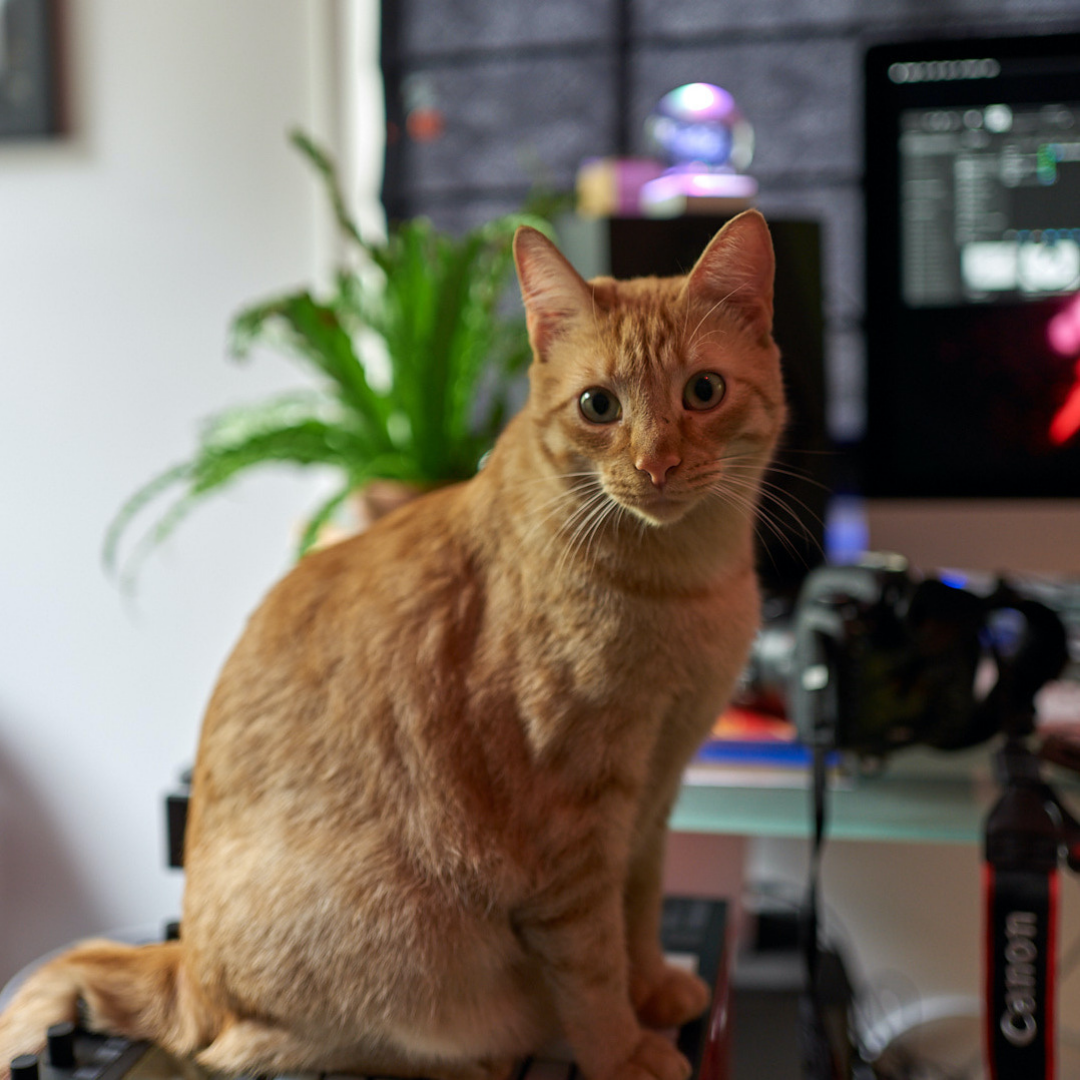
Additionally, you must consider how the costs will be affected if your cat's routing requires a layover. Layovers for pets that last more than a few hours can add additional fees, which ensure they are well looked after at an animal lounge until they are put on the next flight. While you may be able to jump on a discount flight to your destination without worrying about routing or stops, pets have to be carefully routed to ensure they're only flying in and out of airports that have pet-friendly airlines.
Lastly, it is important to note that some airlines will not allow you to book directly with them to fly your cat internationally to some countries. Instead, you'll be required to hire a pet-shipping company with an airline account. This is because they want assurance that the import procedures and paperwork were completed correctly to avoid penalties or fees.
Example Estimate: The cost of flying your cat as manifest cargo will depend greatly on the destination. The cost of flying one small cat domestically as manifest cargo will likely range between $275 to $300. However, the further the destination, the more the rate will increase. For example, flying a typical house cat to Australia may be closer to $1,000.
Other Transport Services
Ground transportation .
If you're moving with your pet within the continental United States, ground transportation may need to be an option you consider. Due to COVID-19, there are not as many airlines accepting pets as there previously were.
Example Estimate: The cost of ground transportation when needed will vary based on the length of the journey. PetRelocation's ground transportation rates start at $2200 - $2400 for a 10-hour drive and increase to around $6000 - $6400 for a cross-country journey.
Pet Taxi
Considering that your cat's travels may not align with your travel plans, looking into hiring services to transport your cat to and from the airport may be a good idea. Hiring a professional pet taxi or driver with a climate-controlled vehicle may not be as inexpensive as you consider the time spent on the drive, the distances traveled, fuel costs and traffic.
Also, if you plan on having someone check in your cat at the airport, it may take a few hours to ensure that all of the paperwork is in order and that your cat is weighed and prepped for departure.
Example Estimate: Animal transportation costs vary based on the city, distance from the airport, number of pets, and time of day the travel takes place. The transport of one cat in a major US city (like New York) during regular business hours to an airport within 10 miles of your home may cost you up to $275 USD.
Additional International Expenses
Government approvals or endorsements.
Depending on where you are moving, you may need to take your cat's veterinary paperwork to get government approval or endorsement before travel. Some countries even require multiple endorsements, such as Consular and USDA.
Again, knowing the rules for importing a cat to your destination is important.
Example Estimate: USDA endorsement fees can be found on their website here . If your cat does not require blood tests, your endorsement fee may be as low as $38. However, if your destination country requires blood tests, the cost will be raised to $121, along with additional fees for each pet. Keep in mind that this does not include the time spent to book and attend an in-person appointment or the cost of mailing in paperwork to be endorsed.

Import Permits
Some countries will only allow pets to enter with an import permit. As you can imagine, getting formal approval from the government to bring your pet overseas can often come at quite a price.
If your destination requires an import permit, try looking for these fees on that country's government website.
Example Estimate: The fees for obtaining an import permit for a pet going to Australia can be found on the DAFF website here . For just one cat, the import permit fees will cost $480 AUD.
Customs Clearance
Once your cat arrives, clearance steps need to be taken. These can include brokers, taxes, tariffs, and other country-specific fees that need to be paid for your cat to be released to you.
Most airlines will gladly share any of these customs fees with you when you book your cat's flight. If that's not the case, check your destination country's government website to see if any customs fees are indicated there.
Example Estimate: New Zealand’s governing body over pet imports, MPI, lists their border clearance charges on their website here . Depending on the country your cat is traveling from, this fee can range anywhere between $28.19 NZD (fixed) to $186.30 NZD (hourly).
If you're moving to a country requiring a quarantine period, like New Zealand, Singapore, or Malaysia, you must consider the fees required to keep your pet at the quarantine facility. Remember that these facilities offer more than just accommodations for your pet. They provide food, outdoor time or walks, and medical care if needed.
Example Estimate: The quarantine fees for pets moving to Singapore can be found on the AVA website here . In short, it will cost at least $242 SGD (roughly $200 USD) for a cat to stay in quarantine for 10 days (the typical minimum period for pets).
DIY vs. Hiring Professionals
While some people choose to handle their pet moves independently, many owners eventually decide to have a service organize it all. Managing the costs and logistics of a pet move can be complicated and stressful, so hiring an all-in-one service relieves most. Hiring a pet shipping professional to arrange your pet's move is more expensive, but since the pet pros will be managing your cat's move, you have one less thing to worry about!
Don't just take our word for it! Here is some insight from other pet owners who are happy they sought PetRelocation's assistance with their cat's travels:
"The first time I was trying to figure out how to move Charlie and Chloe by myself, I found you, and everything fell into place so seamlessly." Read More
"We made the decision to use a pet relocation agency very late in our travel planning process due to misinformation from the airline. With 10 days to move our cat, Cosmo, Jon, and Julia were amazing!" Read More
"Moving countries is no easy feat, let alone if you have other precious goods to relocate. But after working with PetRelocation, and specifically Maegan and Linda, I couldn't have been more impressed nor comforted with the entire process. " Read More
"We contacted PetRelo in February, and they guided us through the process. Our biggest concern is the safety of our pets, and later we realized the pets had a much smoother flight than we did!" Read More
Ready to start planning your cat's move? Contact us to discuss your safe pet move options.
Teen faces multiple animal cruelty charges for allegedly throwing cat out window of car

A 16-year-old boy will face animal cruelty charges after he allegedly killed a cat by throwing out of the window of a moving car Monday night near Brimfield.
The Peoria County State's Attorney's Office said that the teenager was charged with aggravated cruelty to animals and a depiction of animal cruelty for his alleged role in throwing the feline out a moving car Monday night along westbound U.S. 150 near Brimfield, with the incident being recorded for post on Snapchat.
More: Five employees fired, accused of theft from Peoria nonprofit. Here's what we know
Peoria County Animal Protection Services found the dead cat Tuesday and informed the Peoria County Sheriff's Office , who began an investigation into the incident. Witnesses said that the cat had actually belonged to someone who had left the country and the boy had been tasked with disposing of the feline.
During an interview with sheriff's deputies on Wednesday, the boy admitted his actions and was arrested. He spent the night in the Peoria County Juvenile Center , but was released Thursday over the objections of prosecutors.
The case will remain in juvenile court and will not be transferred to an adult court due to the defendant's lack of legal history. Those with further information on the case are asked to contact the sheriff's office at (309) 697-8515.
More: 'Disingenuous' mother sentenced to 100 years for murder of 8-year-old son Navin Jones
- Cat Behavior
- Health & Care
12 Best Cat Carriers for Car Travel In 2024 – Reviews & Top Picks
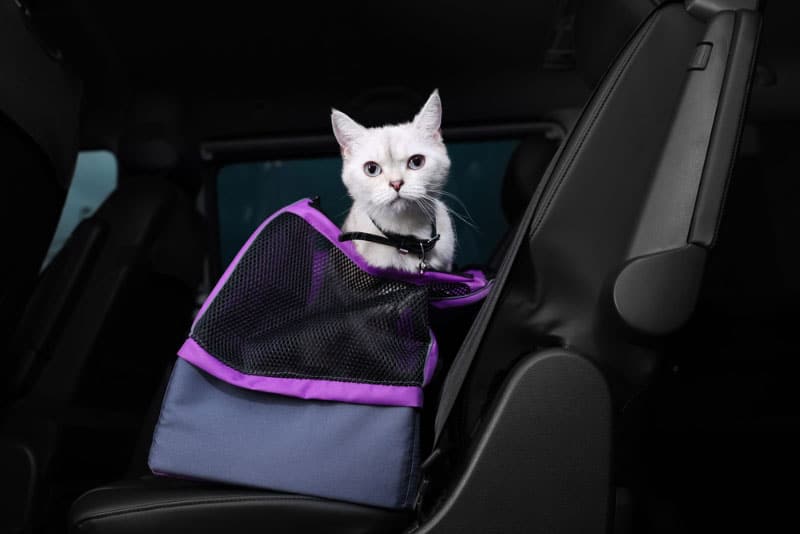
Image Credit: New Africa, Shutterstock
Last Updated on April 26, 2024 by Catster Editorial Team

Every cat owner knows the struggles of traveling with their pet and how difficult it can be for both parties. While you’re looking for the most convenient way to transport your cat, your kitten just wants to feel safe and comfy. Finding an ideal cat carrier is easier said than done, as there are many options to choose from.
To help you narrow your options, we have reviews of the 12 best cat carriers that may fit all your needs and requirements. These cat carriers are specifically made for car travel to help make trips less stressful for your cat (and you!).

- A Quick Comparison of Our Winners (2024)
- The 12 Best Cat Carriers for Car Travel
- 1. Pet Gear Signature Dog & Cat Car Seat & Carrier Bag – Best Overall
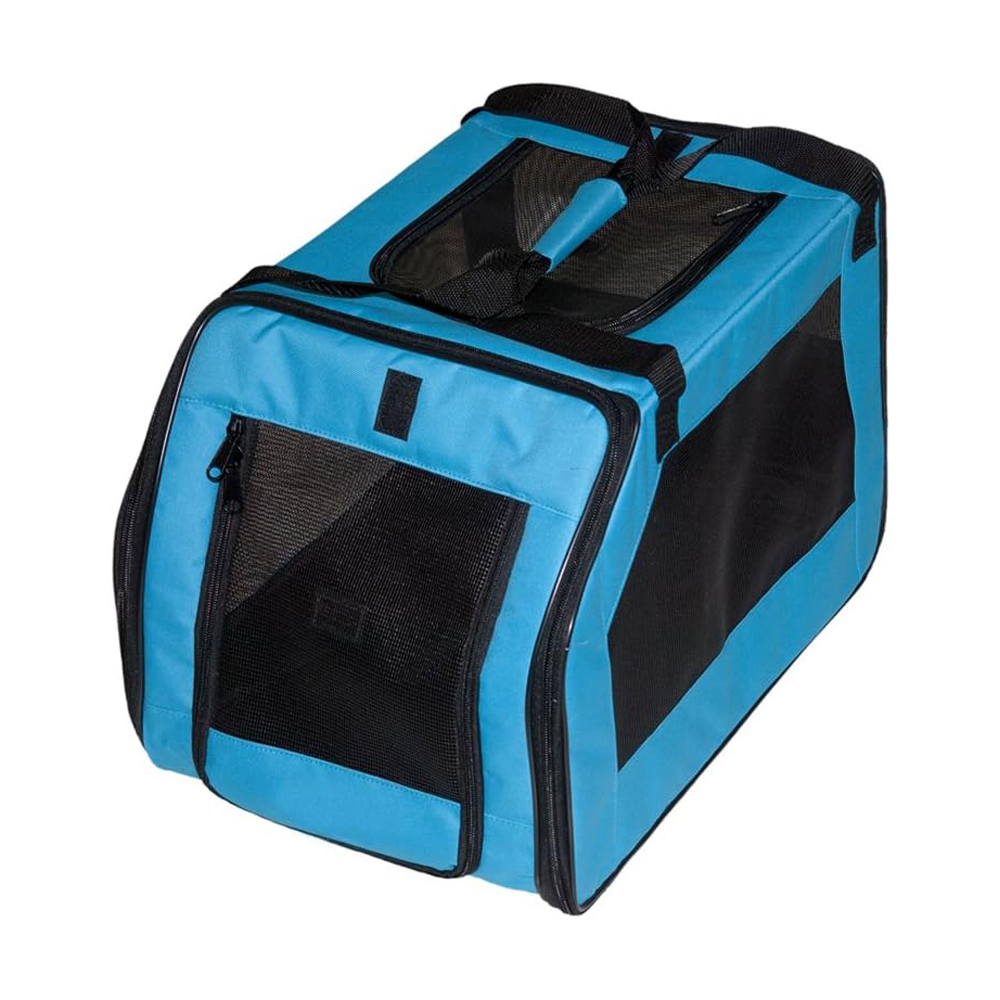
This Pet Gear Signature Cat Car Seat and Carrier is perfect for long and comfortable car travels with your pet. It is incredibly spacious and gives your cat a great view of its surroundings. This pet carrier is our overall best choice because of its sturdiness and durability, ideal for larger cats and even small dogs. While the mesh may not withstand anxious kittens not used to being confined, it will make your cat feel safe and cozy when inside.
It comes with a removable fleece pad that makes it convenient to remove and wash if there are any accidents during the trip. While the zipper may not endure long-term wear and tear, this product offers excellent overall quality.
- Folds flat for convenient storage
- The fleece bottom pad is removable and washable
- The top and front open for easier access
- Safety belt loop, pockets, interior tether
- The zipper may break over time
- Anxious cats can easily break through the mesh during a trip
- 2. EliteField Soft-Sided Airline-Approved Cat Carrier – Best Value
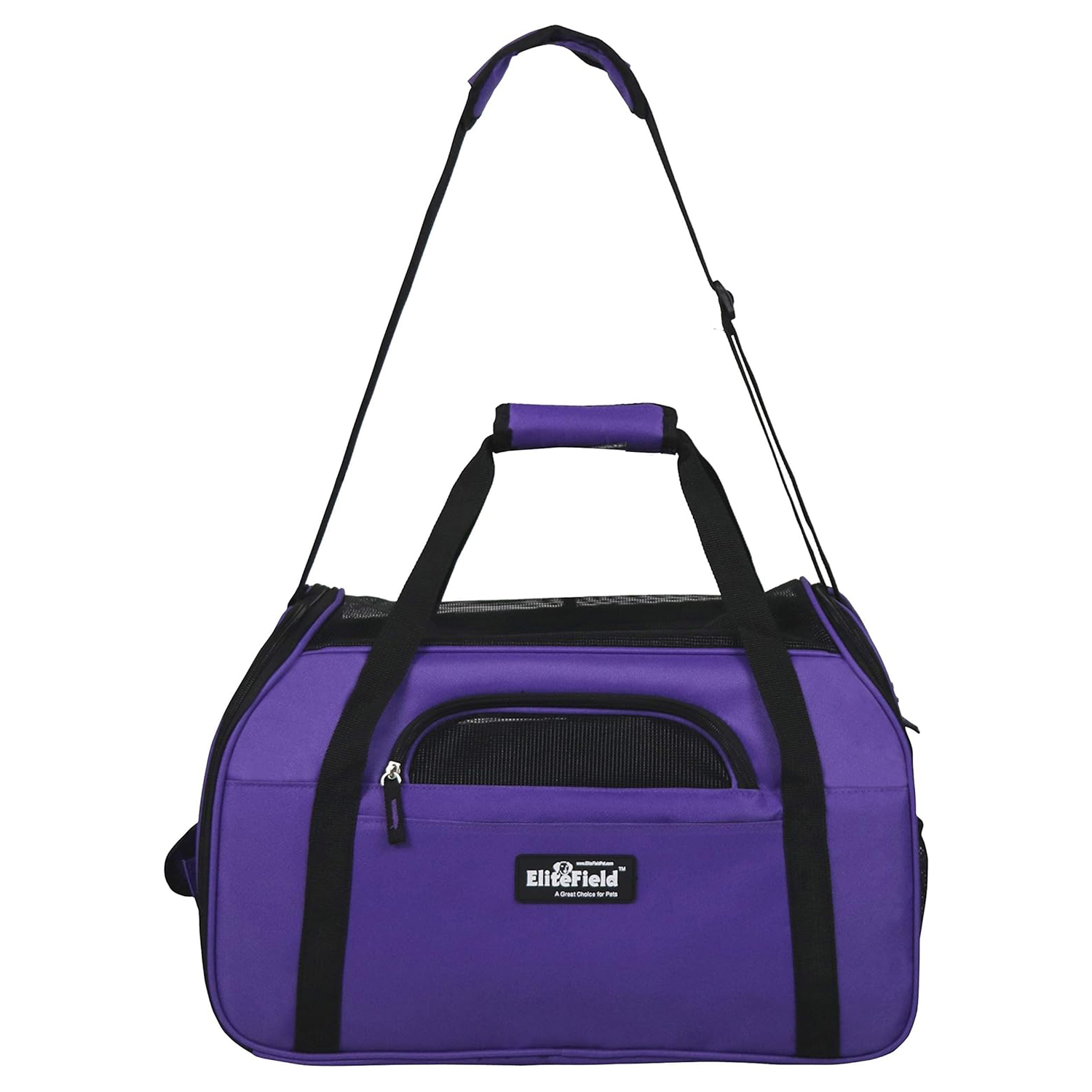
The EliteField cat carrier is a product of excellent quality and is the best cat carrier for the money. It comes in six colors, so every pet owner can find something that matches their taste. This carrier is soft-sided, which is an advantage and a potential drawback as the sides may collapse, but it’s perfect for fitting under airplane seats.
The EliteField carrier is suited only for smaller pets up to 12 pounds and comes with a convenient 3-year warranty. It can be carried by the two handles or by the comfortable, padded shoulder strap. It has enough pockets to fit all your pet’s necessities and can be folded flat for effortless storage.
- Airline-approved
- Waterproof and easy to clean
- Hand and shoulder straps
- 3-year warranty
- It comes in six colors
- Suitable for smaller pets only
- 3. Pet Gear View 360 Booster Travel System Cat Carrier – Premium Choice
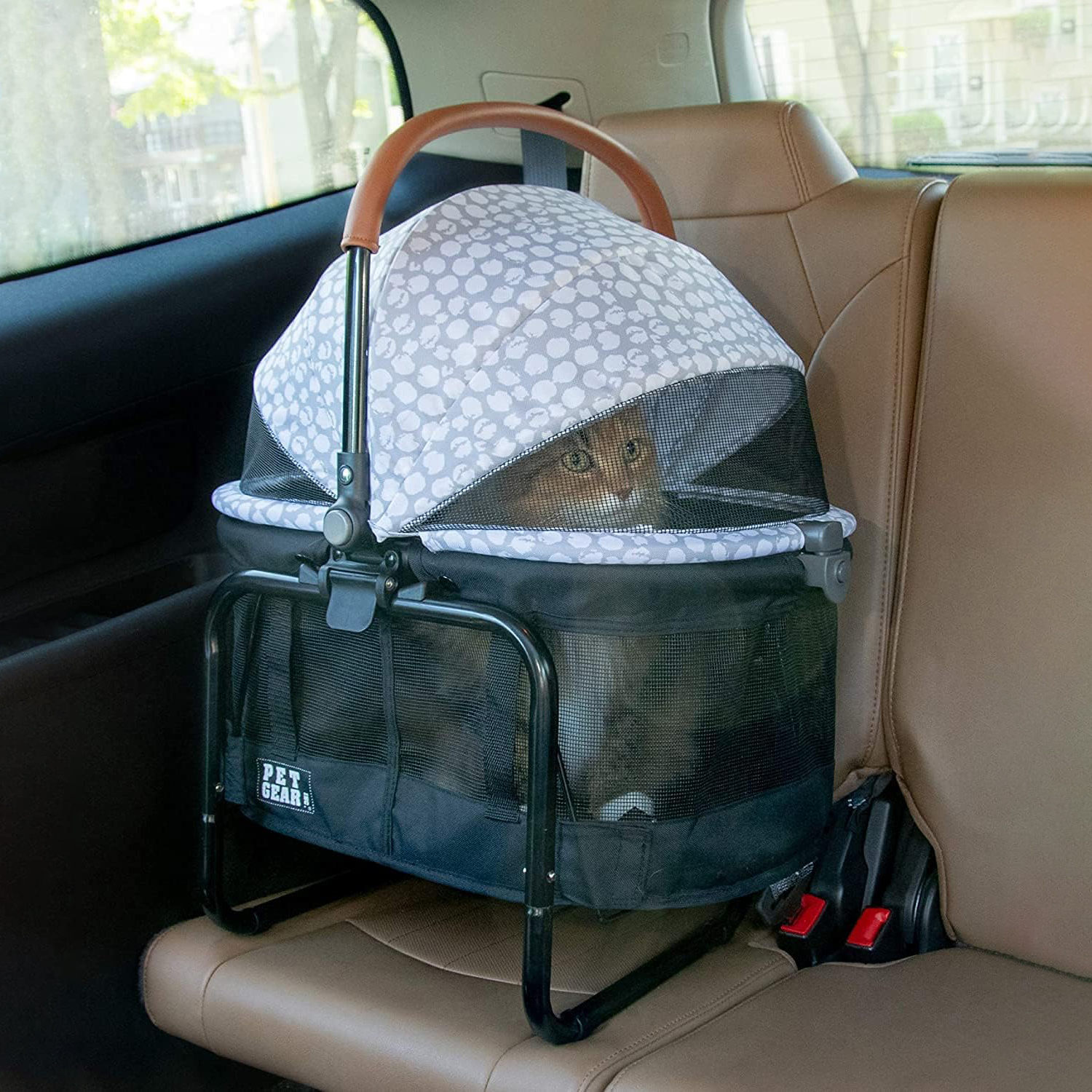
This Pet Gear View 360 Booster carrier is another impressive product on our list, and several valuable features make it our premium choice. This carrier doubles as a booster seat and is exceptionally convenient for car traveling. It contains an inside tether to secure your pet’s harness without worrying about them during the ride.
While the carrier comes with a unique zipperless design that most pet parents love, it might be easy to accidentally push the open button, opening your pet’s carrier and creating a risk during travel. While the Pet Gear carrier has a higher price, it is worth it due to its convenient and sturdy design.
- The carrier doubles as a booster seat
- The zipperless design opens with a single push of a button
- Equipped with an inside tether to easily secure your pet
- Removable and easily washable cushion
- The opening button can accidentally be pressed
- 4. Frisco Single Soft-Sided Expandable Cat Carrier
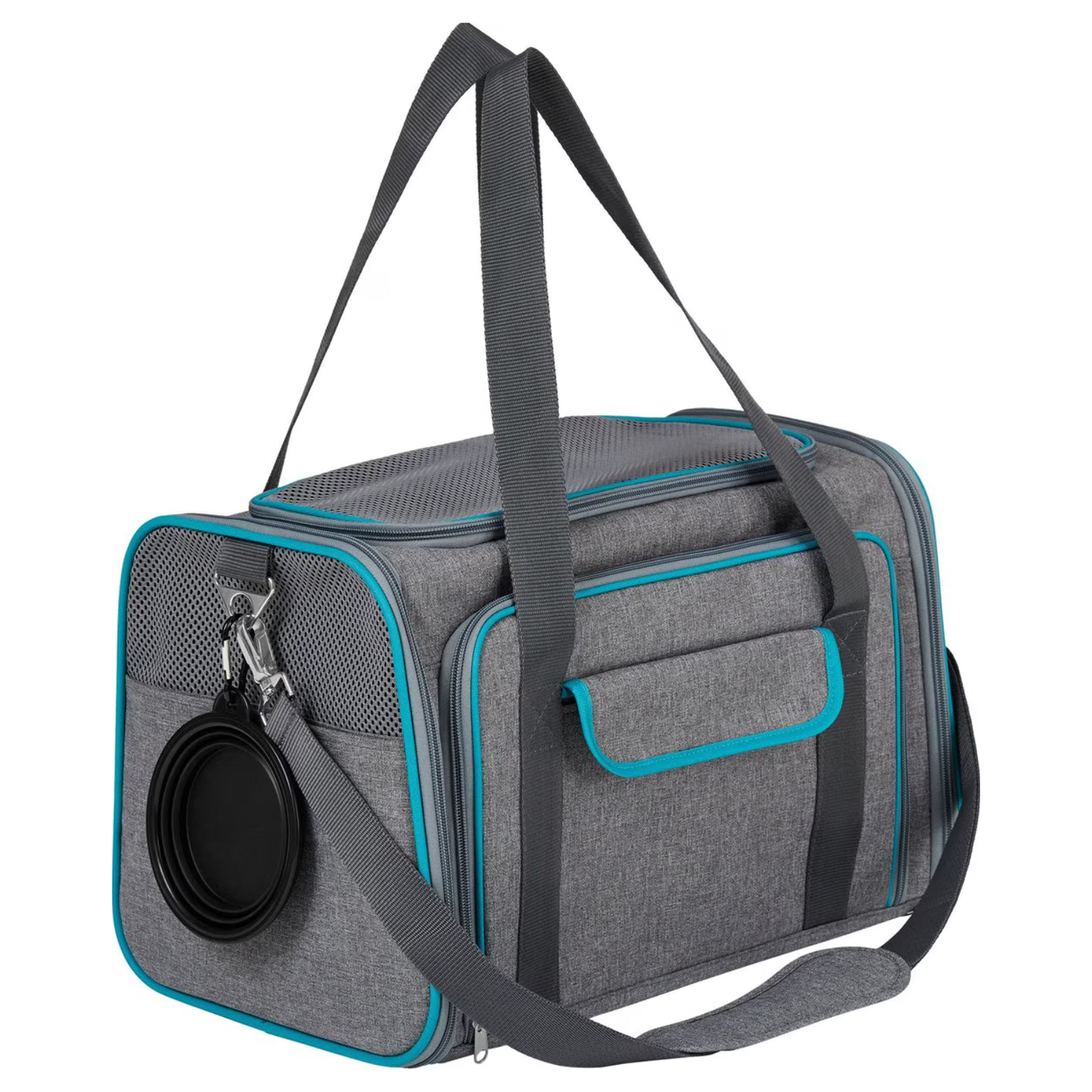
This Frisco Single Soft-Sided carrier is a great choice for pet owners who frequently travel by car or airplane with their cats. It’s very versatile, as the sides can collapse, which can come in handy when storing the carrier beneath a seat. The Frisco carrier’s low price draws most cat owners towards it, and the expandable sides will make it a comfortable experience for your pet.
It also comes with a soft shoulder strap so you can easily carry your pet hands-free.
- Expandable mesh sides
- Airline approved
- The sides may collapse easily
- 5. K&H Pet Products Travel Safety Pet Carrier
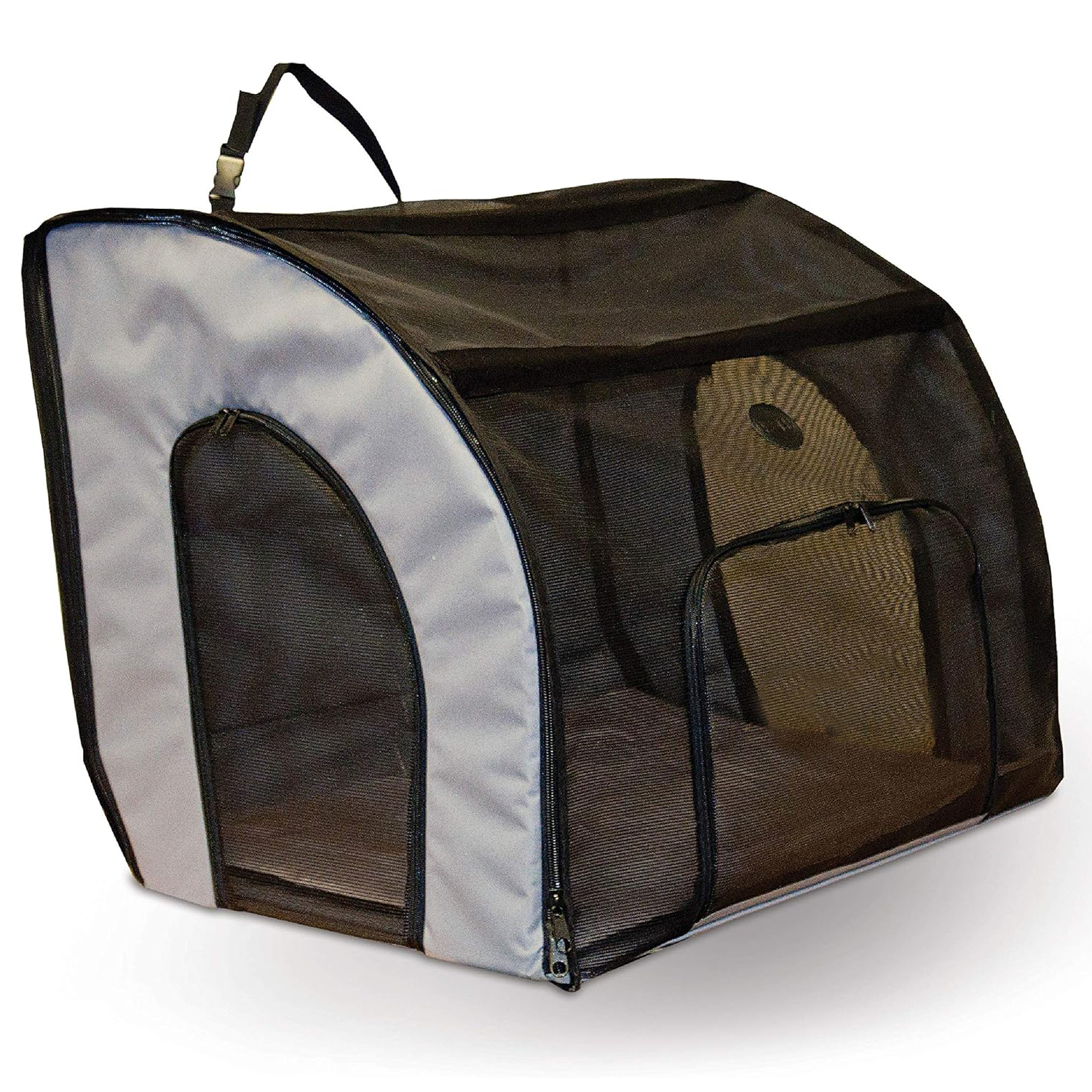
The K&H Travel Safety pet carrier is another very convenient product that can make travel for your cat much more comfortable. It is cozy, secure, and safe for your pet since it can be easily fastened to the car seat. It’s mostly made of breathable mesh to give your kitten a view of the surroundings and good airflow.
One of the very few minor inconveniences this carrier has is the small entry door compared to the overall size of the carrier. However, you can open three sides of the unit to allow your pet easier access. Some customers also reported a slight chemical odor when they received the product.
- Multiple entry points
- It can be safely secured to a seat belt
- It comes with a removable pad
- Small entry door
- Chemical odor
- 6. One for Pets Fabric Portable 2-in-1 Double Pet Kennel and Shelter
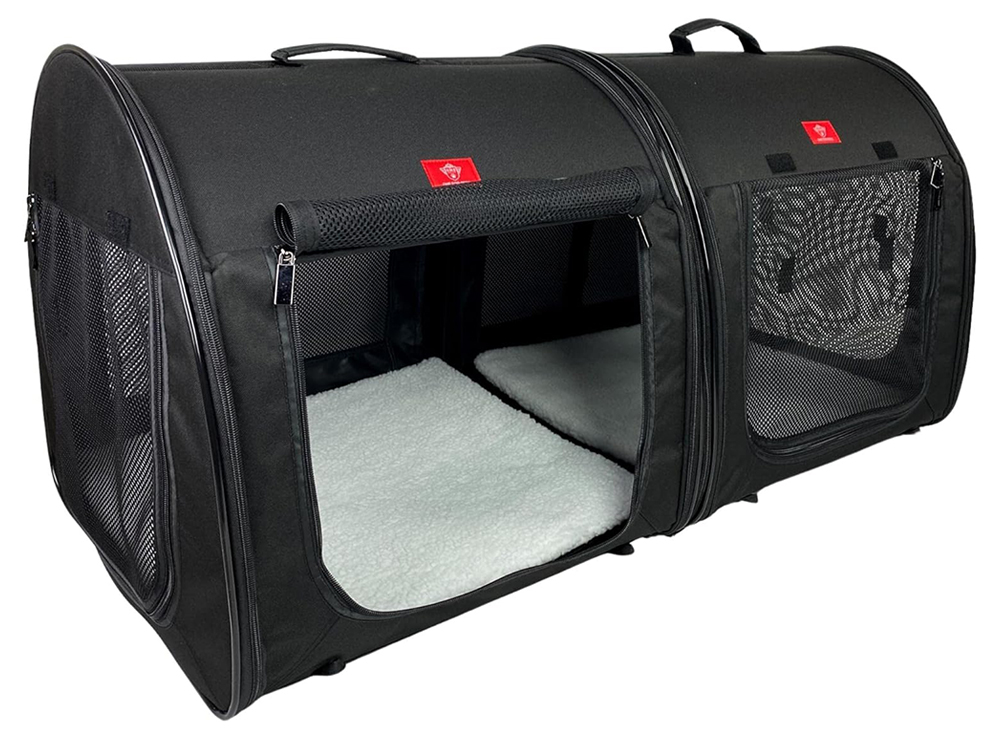
The One for Pets Fabric Portable Double Carrier is a fantastic choice for those looking for a larger unit for more than one cat. While it comes at a higher price, it offers an extra spacious unit for your pets to stay safe and secure during travel. The double design allows space for two cats, with a divider in the middle—but when unzipping the partition, you get one large space if needed.
The only risk with this carrier is that some cats can quickly figure out how to unzip the zipper from the inside, which can be dangerous during a car ride. However, the carrier can easily be secured to the car seat.
- Double design
- Two separate units or one large unit
- Cats may be able to open the zipper from inside
- 7. Siivton 4 Sides Expandable Cat Carrier with Removable Fleece Pad
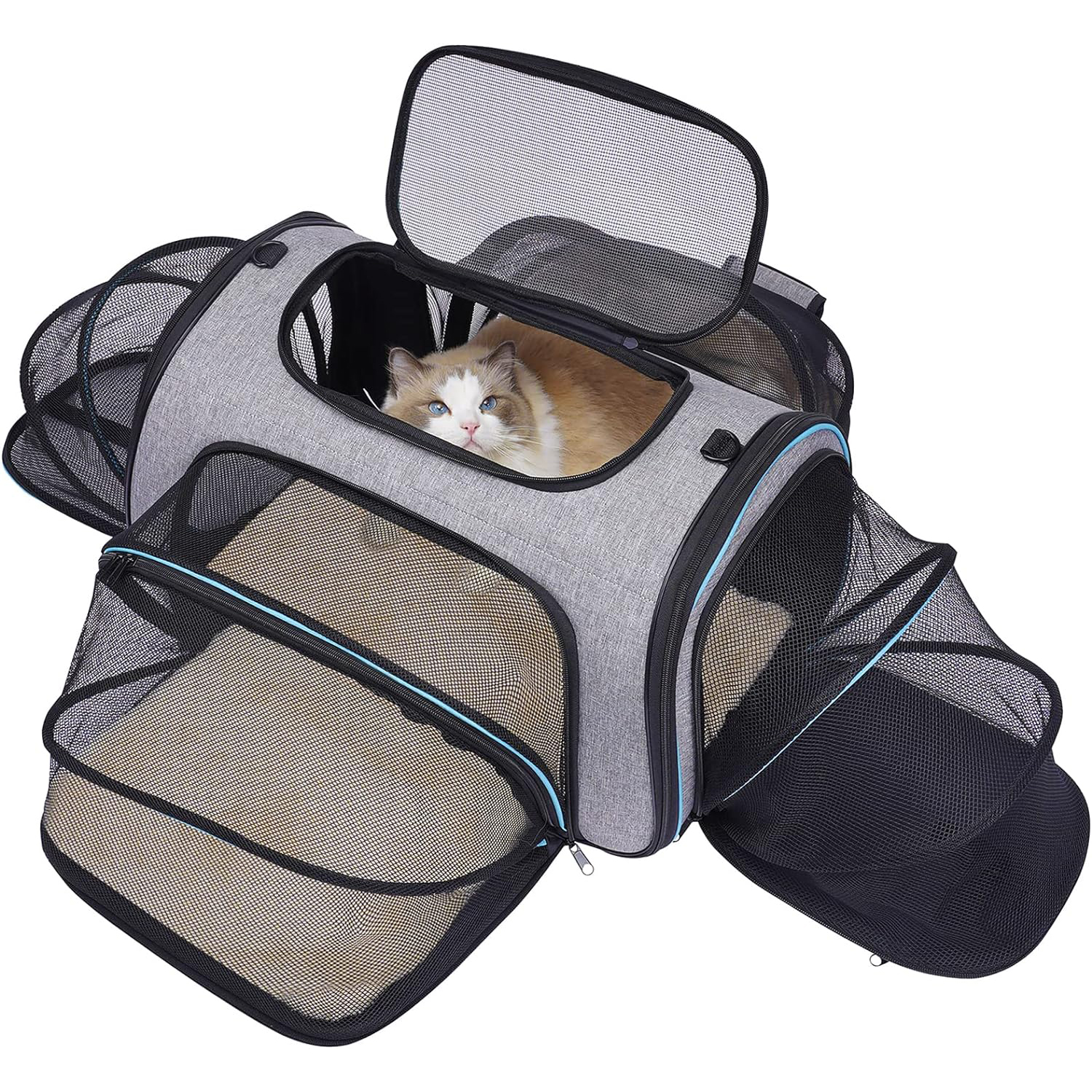
This Siivton Expandable cat carrier is a fantastic choice for overly anxious or claustrophobic cats. It makes traveling much easier and more comfortable for our furry friends, and the breathable mesh cloth makes them feel like they are not confined. Because of its convenient and sturdy design, you can even use it on airplanes and fit it snugly beneath any seat.
While the bottom is flexible, it may collapse under heavy weight when carried on the shoulder. However, it is double-sided to provide your pet maximum comfort while resting. When receiving the product, you may notice a chemical odor that can be unpleasant for pets, especially during longer trips, so make sure to air out the carrier before use.
- Four expandable sides
- Doesn’t take up too much space during travel
- Flexible bottom
- 8. GAPZER Travel Carrier for Large and Medium Cats
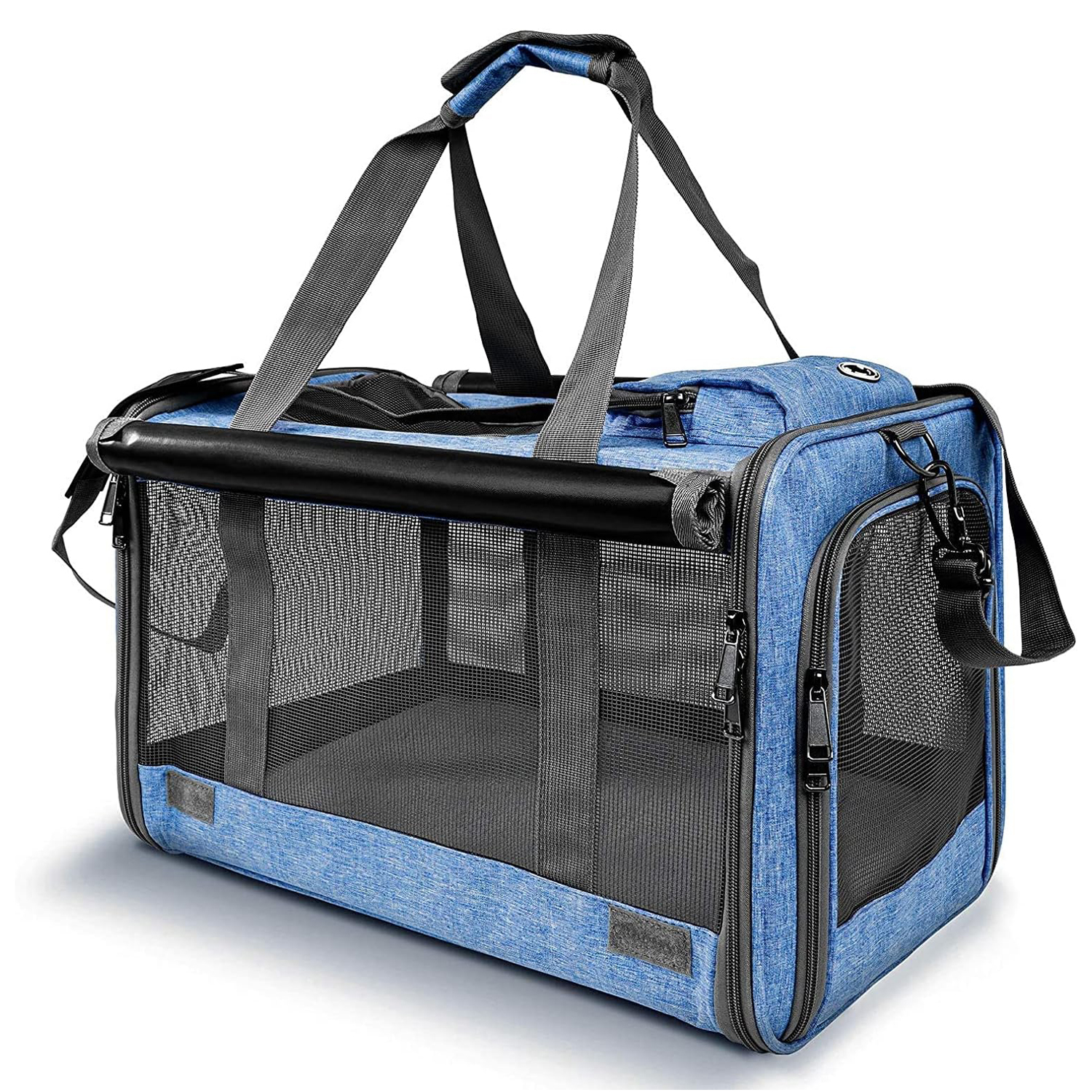
The Gapzer Travel Carrier is one of the best value carriers, considering its low price. It is incredibly affordable and offers fantastic quality. The all-mesh design gives your kitten a perfect view with excellent air circulation.
The zipper is extra strong, and a cat cannot open it from the inside, although the mesh may get caught by the zipper sometimes. This carrier is perfect for road trips because it comes with a strap to secure your pet to the seat. It can be folded easily for your convenience and easy storage.
- Long strap to secure the carrier
- All-mesh surface
- Easy to fold and store
- The zipper may get caught easily
- It might collapse when open
- 9. Prutapet Large Cat Carrier with Collapsible Litter Box and Bowl
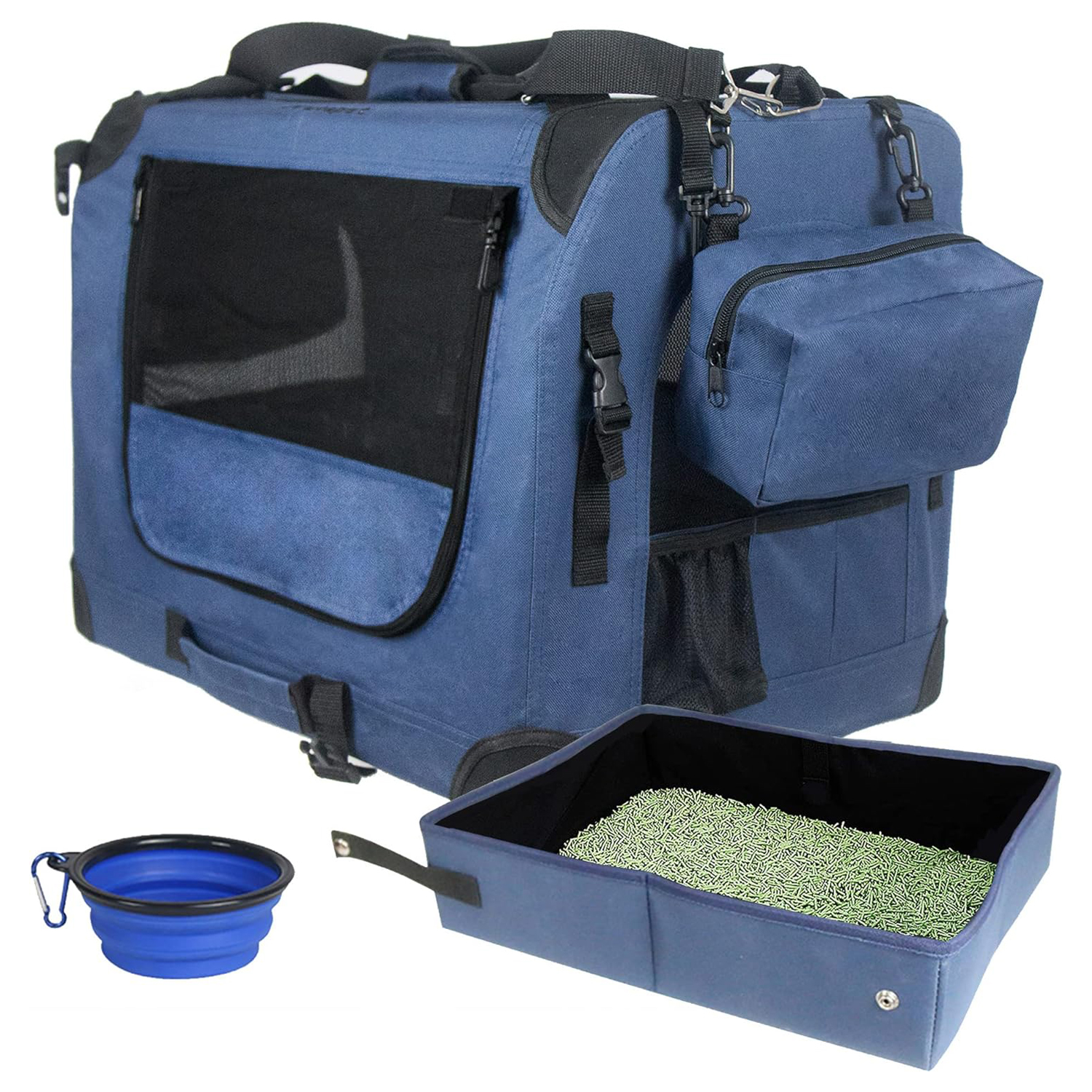
The Prutapet Large Cat Carrier is an excellent product for all small pets, including dogs. One of this carrier’s best features is the additional collapsible litter box and a water bowl, making road trips and camping much more convenient.
Because the bottom is equipped with a soft lamb fluff, your cat will enjoy using this carrier and resting inside. It is ideal for car rides because it can be buckled for safety, and when you are not using it, you can fold it for easy storage. While the zipper makes it quick to open the carrier, some skilled cats may find a way to open it and get out—so keep an eye on that!
- It comes with a travel litter box and a water bowl
- Foldable for easy storage
- The carrier can easily be buckled during car rides
- Unpleasant chemical odor
- Cats may open the zipper inside
- 10. Wakytu Portable 2-in-1 Cat Carrier for Travel
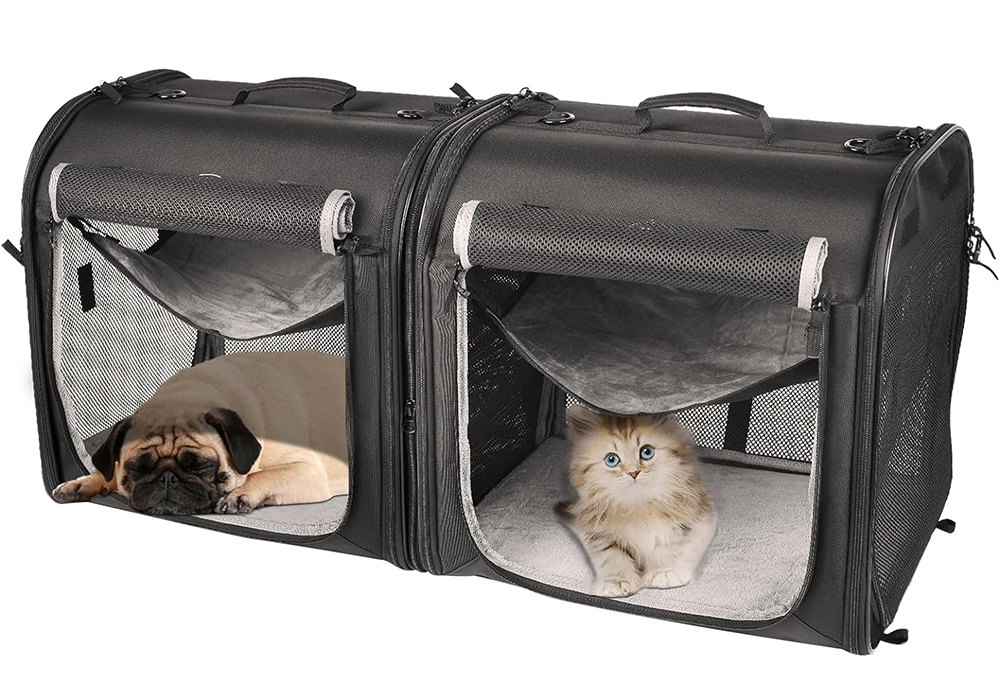
The Wakytu Portable 2-in-1 Cat Carrier is an excellent solution for traveling and home use. While most pet owners choose this carrier for car traveling and camping trips, it is also an effective crate for your cat to rest at home.
While the carrier may be a bit more expensive, it comes with several convenient accessories if you want to use it for travel. For camping, you can use the four gift tent stakes to windproof your carrier and secure it. The mesh may be a bit weak for cats that may try to break free, as they can easily tear a hole in the fragile material.
- Includes extra accessories
- It can be used as one large pet carrier or two separate carriers
- Waterproof, washable material
- Mesh can be ripped from the inside
- 11. Petprsco Large Soft Cat Carrier with Washable Pad
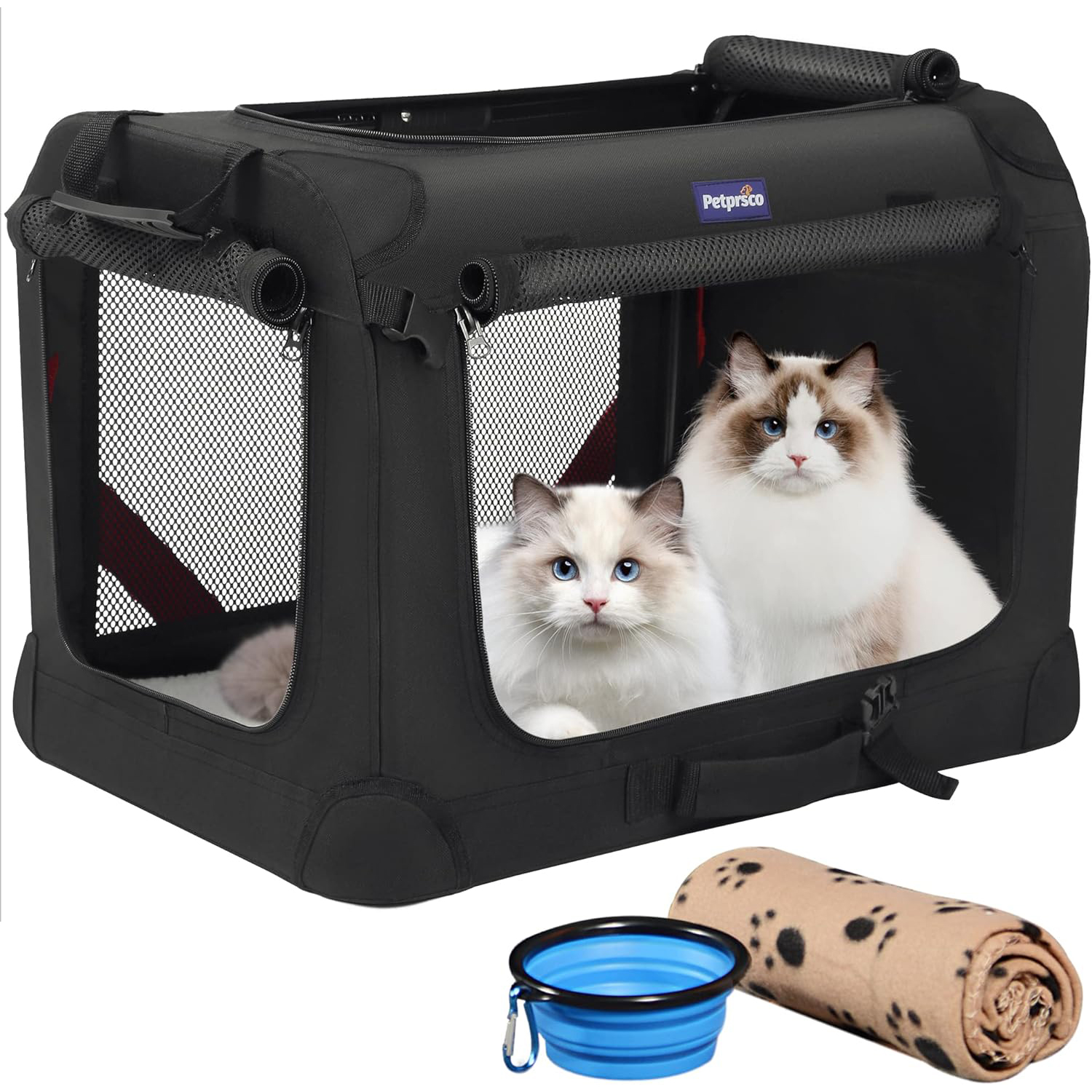
This Petprsco Large Cat Carrier is versatile and convenient for transporting your pet. It is a perfect product for car travel as it contains many useful features such as side pockets, a built-in safety leash, and additional gadgets. While it doesn’t come with a handle on the center of the carrier, it has handles on each side, making it fairly easy to use.
While the anti-scratch mesh is handy for anxious pets, it might not be entirely scratch-proof; if your cat is not used to traveling this way, several scratches may rip the mesh. The plushy pad and warm blanket should help make your cat more comfortable.
- Three openings
- Waterproof, anti-scratch mesh
- It comes with a plushy pad, warm blanket, and foldable bowl
- It doesn’t include a shoulder strap
- No center handle
- 12. Jespet Soft-Sided Airline-Approved Travel Cat Carrier
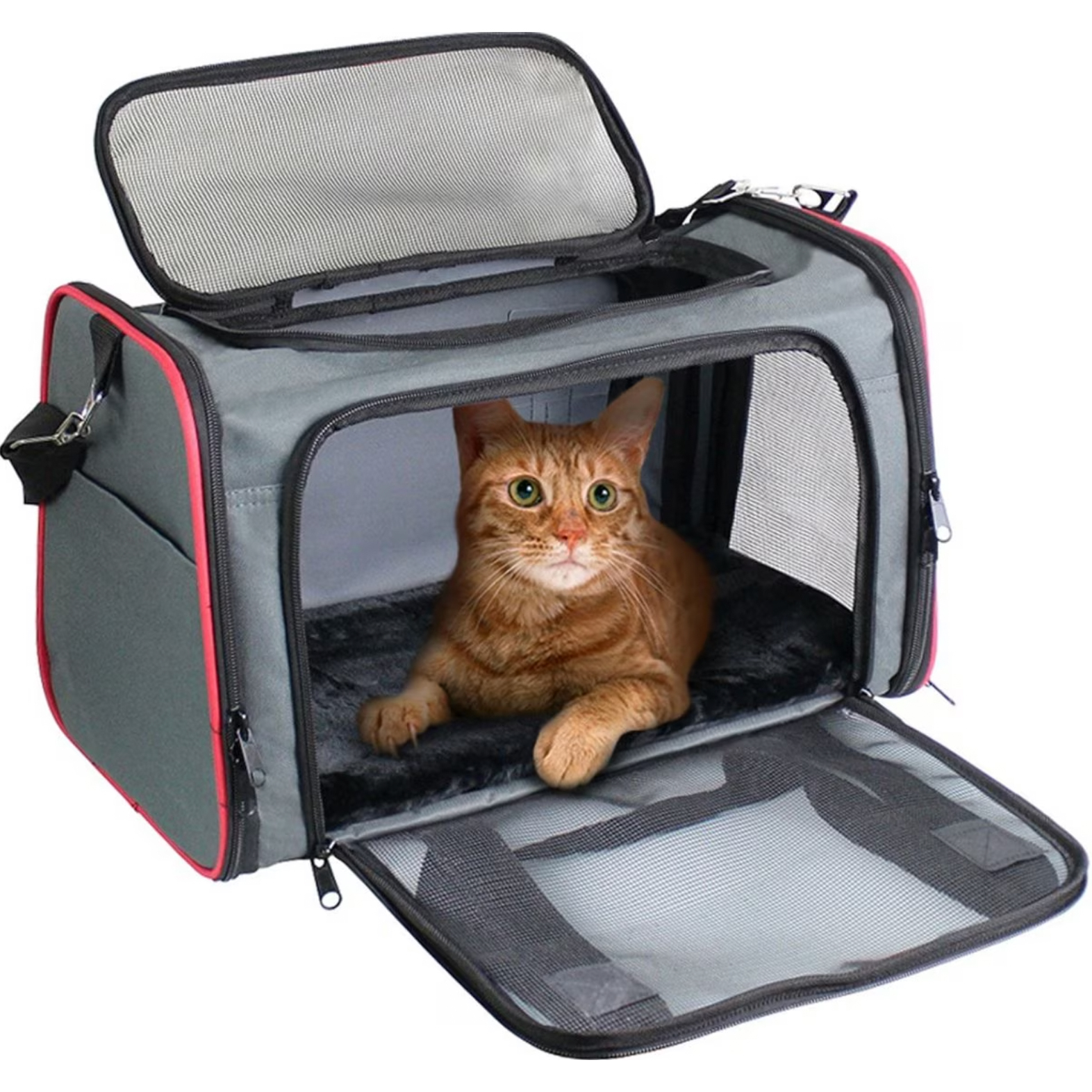
The Jespet soft-sided travel carrier might take the last spot on our list, but it is still one of the better carriers on the market. It has an amazingly low price and offers excellent value for money. It can easily be collapsed for storage and is perfect for car rides.
The inside ridges are made of fiberglass, which can be dangerous if your cat tries to chew on them, so keep an eye on them while they get used to the carrier. Also, a determined cat will tear through the mesh easily. The carrier is soft-sided and convenient for traveling as it’s lightweight and easy to stow away.
- Collapsible
- Includes carrying handles and shoulder strap
- The inside ridges are made of fiberglass
- Not highly durable
- Mesh tears easily

- Buyer’s Guide: How to Pick the Perfect Carrier
Picking out the ideal cat carrier depends on its intended use. Some pet owners use their carriers only for monthly or annual vet trips, and others use them for regular trips. Whether you take your cat on a vacation or need to transport them from point A to point B, you’ll need a sturdy and durable unit.
It is best to search for carriers that include portable litter boxes and bowls for longer trips, while some may even have tent stakes. A comfy, fluffy mat is another plus to keep your cat warm and cozy. If you are looking for a simple transporter carrier, it’s best to find one with sturdy edges that won’t collapse and plenty of attachments to secure it to the car seat.
When deciding on the ideal cat carrier size, there are several factors you’ll need to consider. The larger the carrier, the better. While the cat’s weight is an essential measurement for a perfect fit, you must also consider the cat’s length. Some cat carriers have an excellent weight capacity but tend to be a little shorter, so you don’t want your cat to feel uncomfortable or cramped.
Finding a large enough carrier can make vet visits and trips much more tolerable, as your cat won’t try to scratch their way out and destroy the carrier. Search for a cat carrier with as much mesh fabric as possible, giving them sufficient airflow and allowing them to view their surroundings.

We know how difficult finding a perfect carrier can be, and hopefully, our reviews will give you some great options to consider. We discussed several high-quality carriers but we have a few favorites we recommend over the rest.
To recap, the Pet Gear Signature Cat Car Seat and Carrier is ideal for long car travels with your pet and is our top choice overall. If you’re looking for a more budget option, the EliteField cat carrier provides an excellent value for the price and is ideal for airline traveling.
- How to Sedate a Cat for Car Travel
- Best Cat Water Bowls
Featured Image Credit: New Africa, Shutterstock
About the Author
Jana Blagojevic
Upon completing my degree from the College of Fine Arts, I embarked on a quest to find a platform to manifest my wild imagination. It was then that I discovered my passion for content writing, which swept me off my feet. As a freelance writer, I am always on the move, with an adventurous and restless spirit that propels me forward. When I am not typing away in my cozy writing nook, I spend my time honing my skills as a sculptor, painter, and woodworker in my workshop. Writing has become my primary medium of expression, and I plan to nurture this passion further, using it as a conduit for my never-ending creativity.
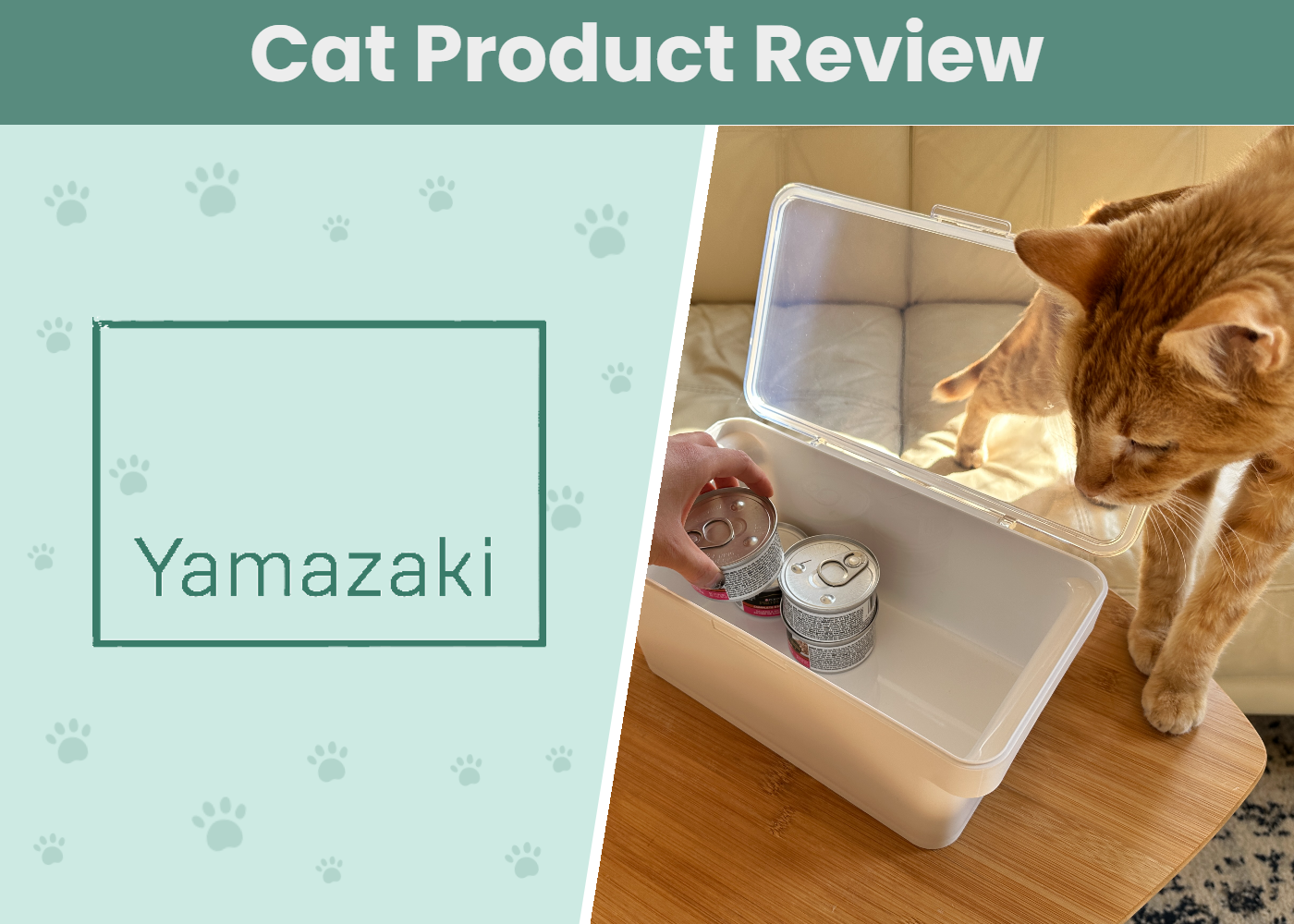
Yamazaki Airtight Pet Container Review 2024: Our Expert’s Opinion

Funny Fuzzy Cat Sofa Bed Review 2024: Our Expert’s Opinion

Pet Remedy Kitten Calming Kit Review 2024: Pros, Cons, & Our Verdict
Get catster in your inbox.

Here Comes the Sun: Is It Alright? Dangerous Things Cats Like

Cat Dogs: Cats for People Who Think They Don’t Like Cats

Strange Places That Cats Hide: Olga’s Preferred Spots
© pangolia pte. ltd. all rights reserved..
Nearly 50 cats were rescued from a hot car. Now one is a Target model.
Jill lebrun was stunned and delighted to see her rescue pet’s image plastered on buckets of cat litter at target.

The scene was heartbreaking: Nearly 50 cats were crammed into a hot car at a rest stop near Minnesota’s Twin Cities.
The cats were piled from floor to ceiling inside an SUV, and police soon learned that their owner had been living inside the car with them.
The owner agreed to surrender the cats to area animal shelters, but during the rescue, one of the cats escaped. Hercules, a gray and white feline, scampered off that sweltering day in June 2022, said Nicole Perreault, a veterinarian who runs Tuff Start Rescue , a Minnesota foster and adoption nonprofit.
Animal rescue volunteers searched for the cat for a month, she said, until Hercules was finally spotted sitting on someone’s doorstep in the area. His jaw was fractured, he was covered with maggots and his tongue was severely damaged, Perreault said.
The person who found Hercules outside brought the cat to the veterinary clinic.
Perreault said she suspected the cat was Hercules and contacted his previous owner, who confirmed it.
“This gentleman said he had fallen on hard times and had been evicted so he was staying in his car with all of his cats,” she said. “He was very polite, and it seemed he loved them very much. He was happy to know that Hercules had been found and was getting a lot of love.”
She did not know what happened to the man who was evicted. She assured him Hercules would be taken care of, she said.
“We suspected he might have been hit by a car,” Perreault said of Hercules. “He was so near death that I wondered if it would be more humane to euthanize him.”
But then Hercules lifted his head and looked right at Perreault.
“I got the impression that he really wanted to fight,” she said.
Perreault and her team fed Hercules and cleaned him up, then gave him fluids through an IV and put him on pain medication. When the 6-year-old feline was strong enough, Perreault took him to an animal oral surgeon to have his jaw repaired.
Perreault said she posted a few photos of Hercules on her Facebook page to let people know the cat had been found and was gradually healing.
“He ripped my heart out when I saw him,” she wrote. “… I decided we owed it to him to give him every chance to recover from this horrible ordeal, so that hopefully he can experience the love and TLC that awaits.”
Jill LeBrun, a pediatric nurse from St. Paul who has fostered dogs and cats for Perreault’s rescue over the years, was immediately interested.
“As a nurse, I’m attracted to medically fragile animals,” said LeBrun, 50. “I knew that Hercules was going to need to be fostered and I felt that I could do it.”
Once Perreault and her staff determined that Hercules was strong enough to leave veterinary care, LeBrun took the cat home. Hercules was soon snuggling up for naps with her other cat, Kay.
LeBrun quickly realized she’d be adopting the feline instead of fostering him.
“He’s pretty special — he also gets along with our new puppy, Juni,” she said.
“His jaw is a little crooked and his tongue almost always hangs out because of what happened to him,” added Perreault, 44. “But he’s a sweet, tough cat. The name Hercules suits him.”
Last fall, LeBrun said, she was scrolling on social media when she came across a post from the Animal Connection , a pet talent agency in search of cats with unusual faces. It was scouting pet models for Target, which is based in Minneapolis.
LeBrun said the agency loved the photo she sent of Hercules with his tongue hanging out . She was asked to bring her cat to a studio for a photo shoot so his personality and star appeal could be assessed.
“Hercules did great — he’s a friendly cat and everybody loved him,” LeBrun said, noting that she was paid $100 to participate. “They told me his picture would appear on something for Target in early 2024.”
In mid-March, when LeBrun still hadn’t heard back, she made a trip to her local Target and walked down the pet aisle.
When she came to a display of store-brand cat litter, she was stunned and delighted to see her cat’s image — with his dangling pink tongue — on every bucket of Up & Up Fragrance Free Clumping Cat Litter on the shelf.
She bought some right away.
“So did all my friends and neighbors,” LeBrun said. “One of my friends didn’t tell her son about it when she took him to the store. But he saw the litter and said, ‘Mom! That cat looks just like Hercules.’”
LeBrun said Hercules was recently called in for a second Target photo shoot, which means he’ll probably be appearing on other merchandise in a few months. The TV station Kare 11 recently reported on the cat’s sudden fame as a model.
“He’s a natural and he loves to be the center of attention,” LeBrun said, noting that her cat has remained humble and is not the least bit finicky.
She said she still marvels at his journey from being hoarded in a sweltering car, then escaping and nearly dying, to becoming a feline model.
“I feel very lucky to be the person who gets to spend every day with him,” she said.
- He forgave the man who killed his son, and helped free him from prison April 18, 2024 He forgave the man who killed his son, and helped free him from prison April 18, 2024
- They were bitter rivals. Then one of them needed a kidney. April 9, 2024 They were bitter rivals. Then one of them needed a kidney. April 9, 2024
- ‘This is Cecil. He has never done anything bad in his life until he ate $4,000.’ January 3, 2024 ‘This is Cecil. He has never done anything bad in his life until he ate $4,000.’ January 3, 2024

Every product was carefully curated by an Esquire editor. We may earn a commission from these links.
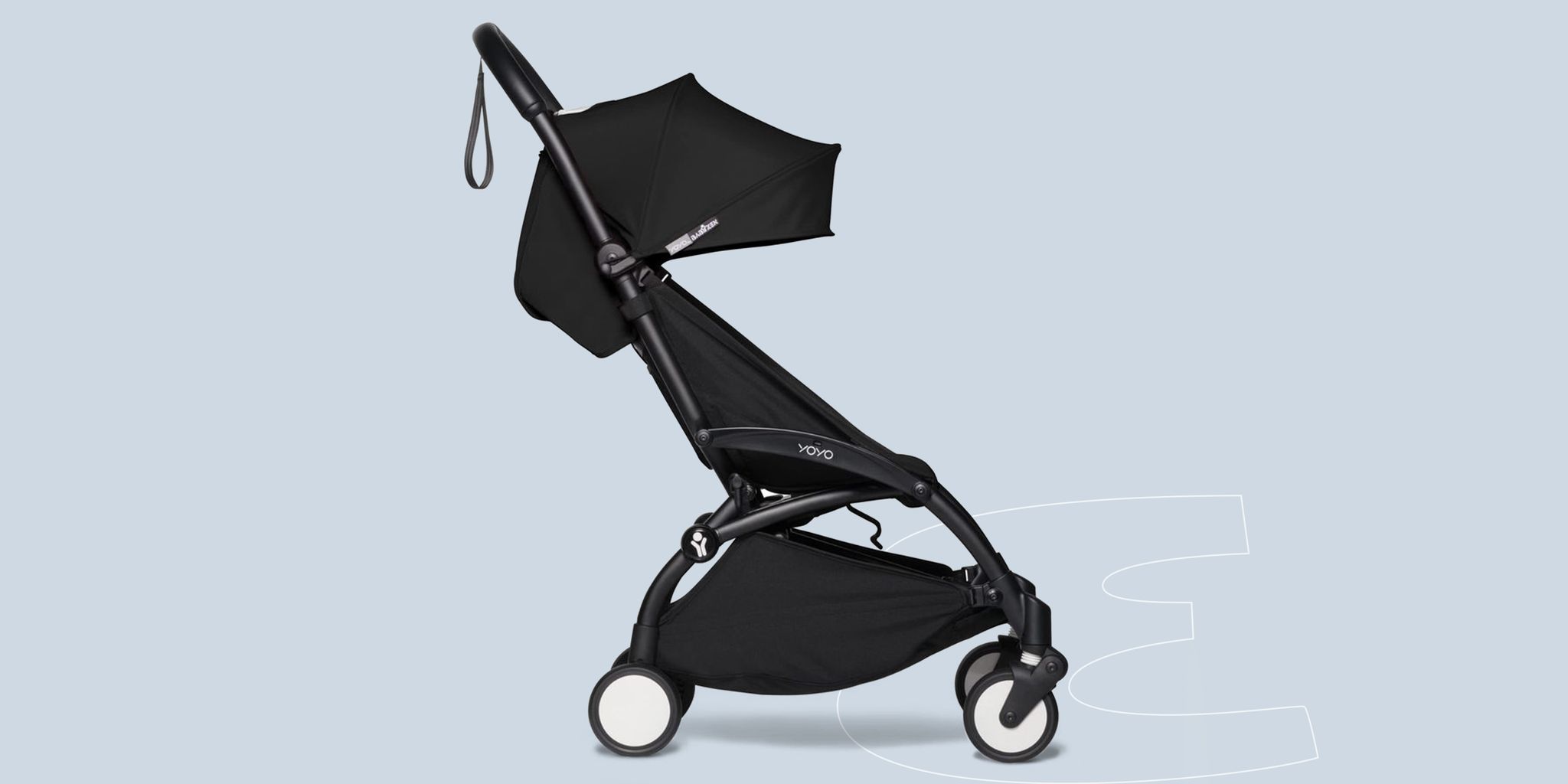
The 8 Best Travel Strollers for Dads Navigating Airports and City Streets
These are the ones that’ll make your life easy and your kids happy.
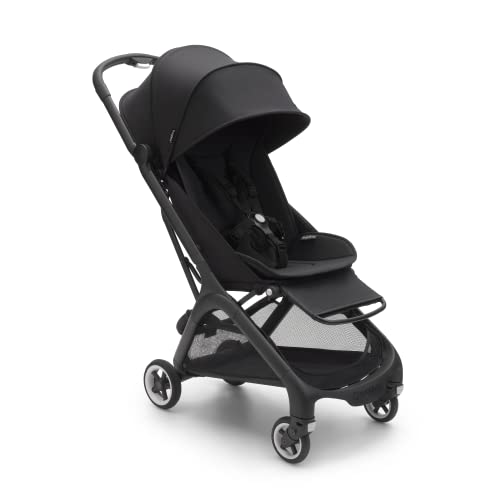
Best Overall Travel Stroller
Bugaboo butterfly stroller.

Comfiest Stroller
Gb qbit+ all-city stroller.
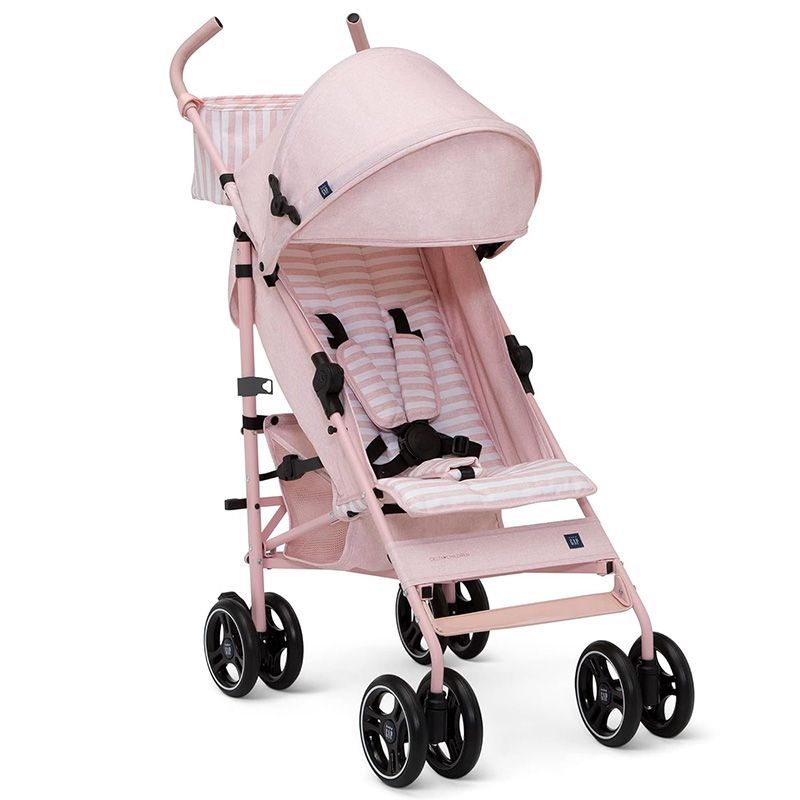
Best Budget Stroller
Babygap classic stroller.
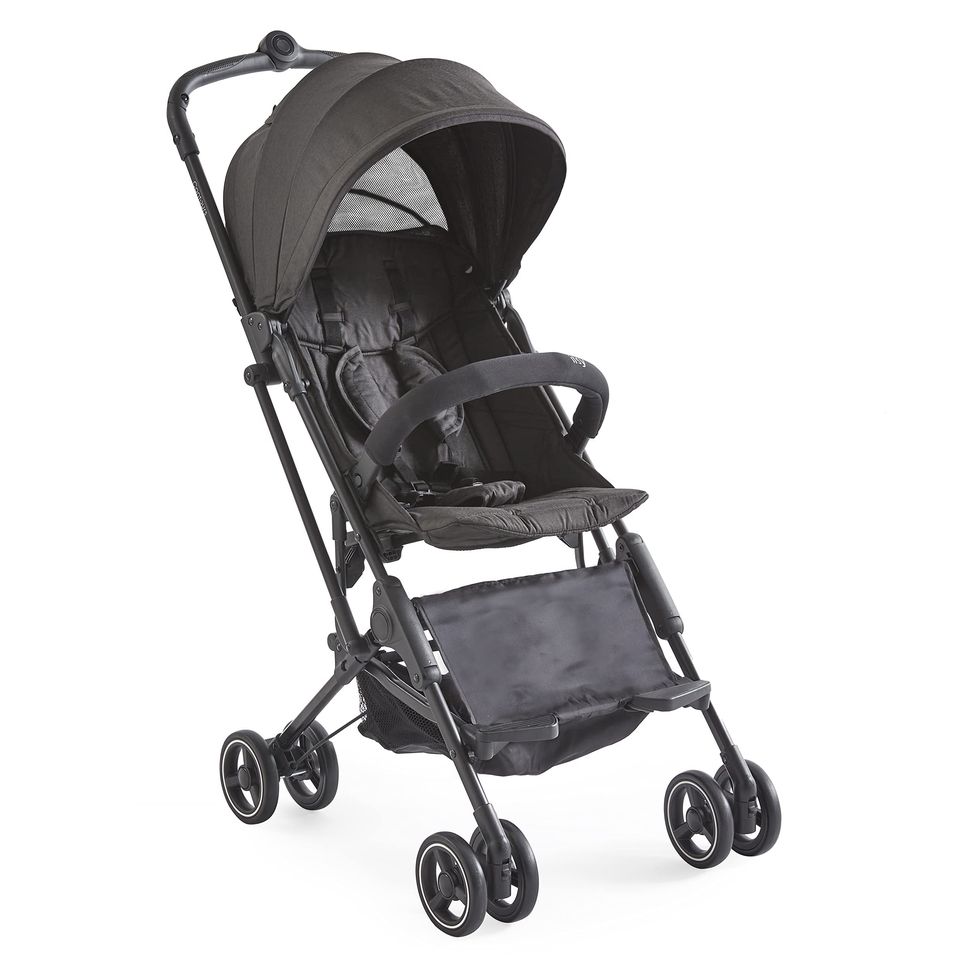
Easiest Stroller to Carry
Contours itsy lightweight travel stroller.
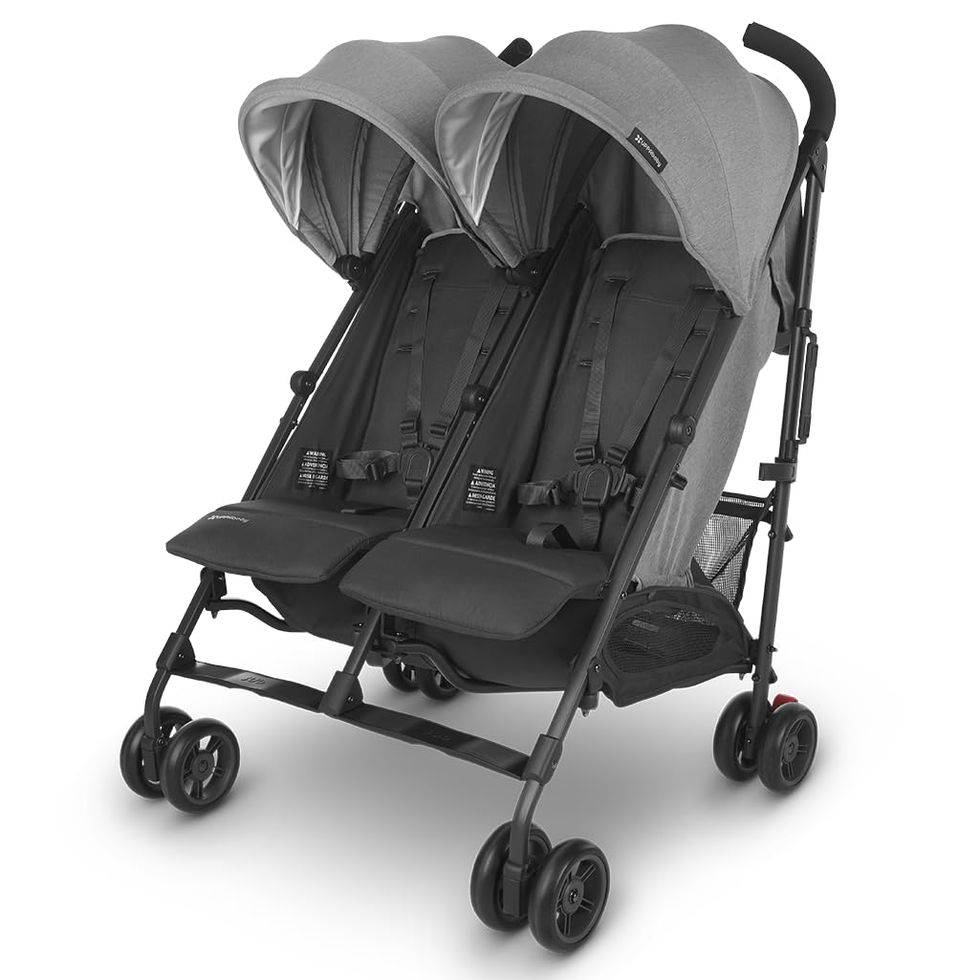
Best Stroller for Twinning
Uppababy g-link v2 stroller.
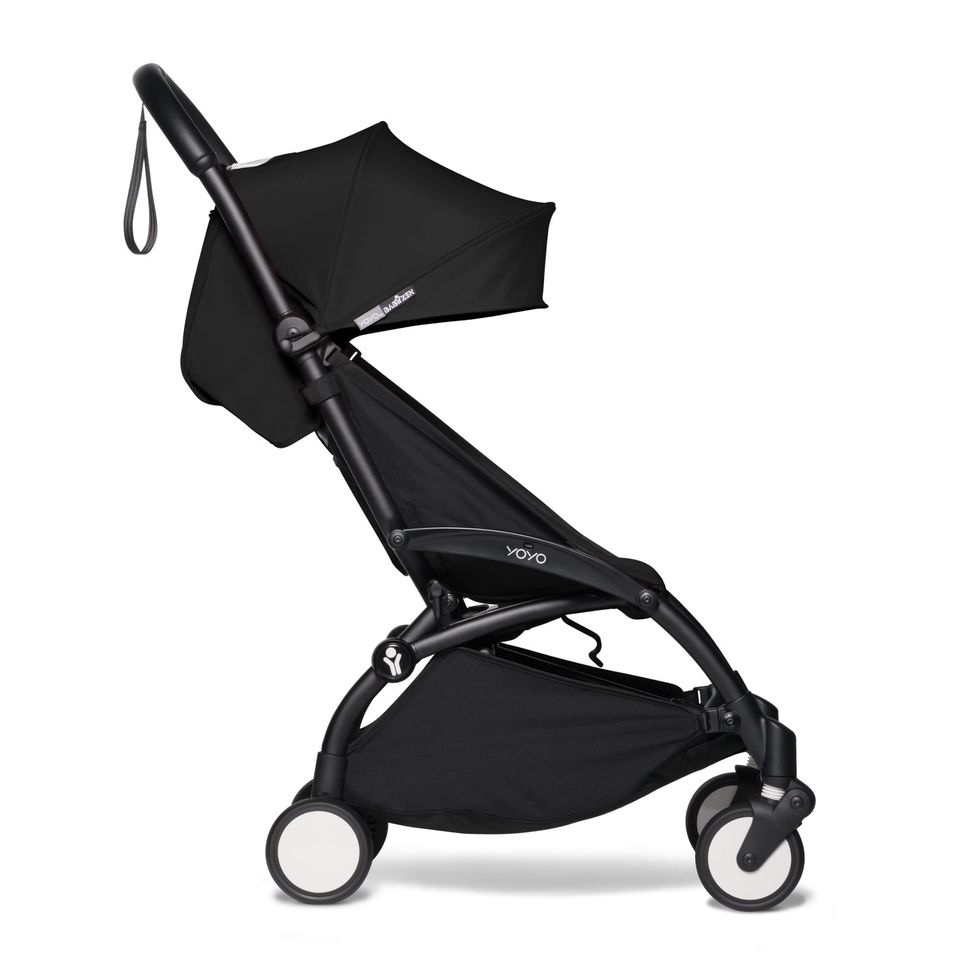
Best Stroller for City Dwellers
Babyzen yoyo2 stroller.
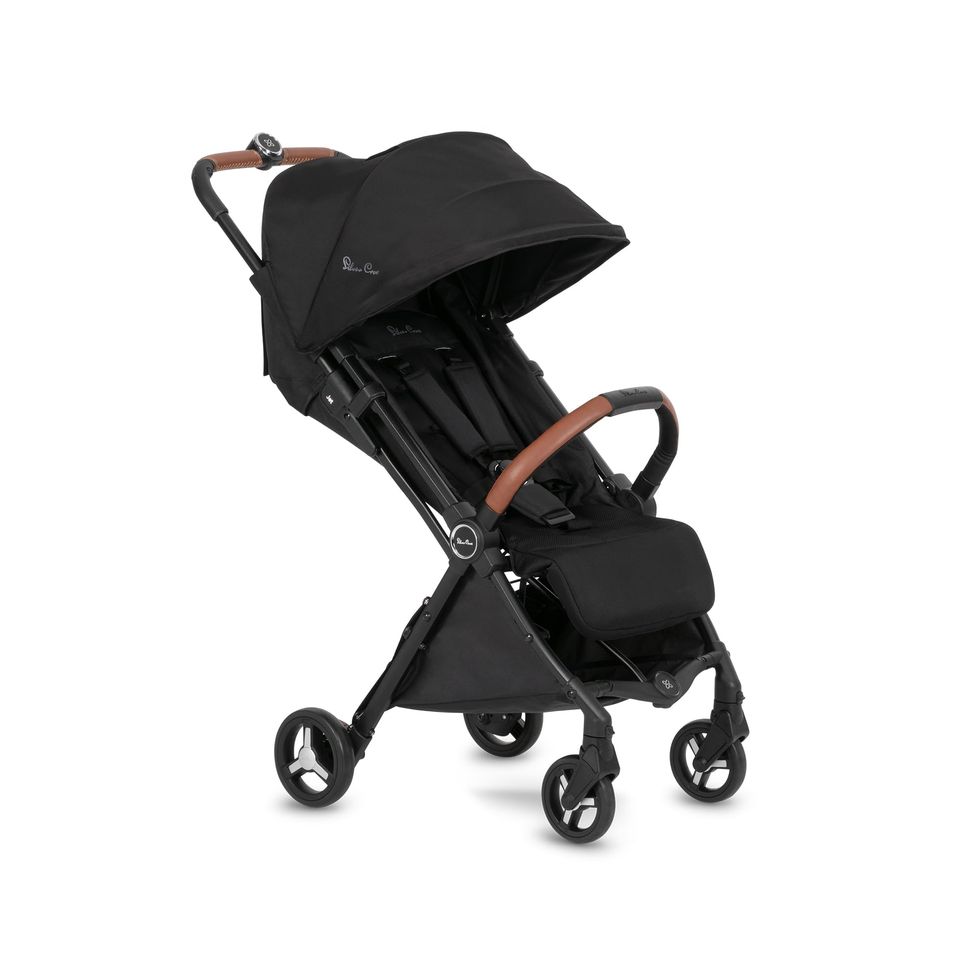
Smoothest Handling Stroller
Silver cross jet 3 super compact stroller.

Best Stroller for Flying with Infants
Doona infant car seat and stroller.
Thankfully, my wife and I come prepared. The Bugaboo Butterfly travel stroller is a godsend when running around with small humans . It opens quickly and easily, it’s light and portable, and it holds kids up to fifty pounds. That means even though my two-year-old daughter is usually the one hitching the ride, when my five-year-old son’s legs get tired (or a sibling rivalry inevitably rears its head), he can hop in there, too.
All of which is to say that when the Koenig clan finally does arrive at the gate, all four of us are in relatively good spirits—even the two year old. The Bugaboo is a great get, but there are a number of other travel strollers out there that could be a good match for you and yours. Read our full breakdown of the varieties we’ve tested and reviewed.
The Butterfly is aptly named, as it feels like it is actually floating over the ground, even when on grass and gravel. The seat must be especially comfortable, because my two year old surely would have let me know in no uncertain terms were it not. The cargo space on the Bugaboo is good enough for emergency drinks, snacks, Mom’s bag, and Dad’s travel hoodie.
Opening and closing the Butterfly is a cinch, and with Irish blood on both sides, my kids appreciate the sun canopy as well. The stroller is small enough to keep as a carry-on, but if you do decide to check it, be sure to fold up the footrest so it doesn’t get damaged in transit.
There’s not much to dislike about the All-City stroller, and that includes its price point, which is a good chunk less than the Bugaboo’s (right in the $300 range, depending on when and where you shop).
This is a stroller with comfortable padding in the seating area and folding mechanisms that won’t induce public meltdowns (from dads, not toddlers). It’s also rather maneuverable and has a silky ride that is really impressive. The only bona fide knock against it is that at 17.6 pounds, it’s pretty bulky, and without a shoulder strap, heaving it around is a real workout.
For an item that costs around $100, the Classic Stroller from babyGap can take a beating. That’s a pleasant surprise for those of us dads who tend to hulk out on things from time to time. (Hi, it’s me. I’m the problem, it’s me.)
This stroller also has a comfortable seat with a five-point harness and a sun canopy overhead with a peekaboo window so you can keep an eye on Junior. The only thing not to like about it is that the folding lock on the bottom-right side takes a little getting used to, which might annoy impatient dads... Not that I know anyone like that.
The most minimalistic of the strollers on this list, the Contours Itsy Lightweight Travel Stroller reminds me of something my wife says every time I float the idea of buying a new car. She points out the window at the old beater in our driveway and says, “Does it still roll?”
This stroller has no cupholders and limited storage space. It also doesn’t recline, which might be an issue for bigger kids. But it does, in fact, still roll—rather smoothly at that. And at just 12.3 pounds and $170, this will be a sensible option for many.
Before I had kids, I used to think I wanted twins. What a sweet and innocent child I was. One kid at a time has been plenty for me, and for those dads in the trenches with twins, you have my respect.
For you guys, the Uppababy G-Link V2 Stroller is a very solid choice. I think of it as the Cadillac of travel strollers—comfortable, smooth, and (obviously) rather large. It’s actually too big to keep as a carry-on, so be prepared to check it. But realistically, there is very little not to like here.
Since I’m a full-fledged suburban dad now, car seats are my current worry. But I lived in cities for twenty years of my life, so I am very sympathetic to space concerns. The best travel stroller out there for the urban denizens among us needs to be small and easy to maneuver—enter the Babyzen YOYO2.
This zippy little thing is great for weaving through armies of commuters on busy city sidewalks. It also folds up teeny, and at 13.7 pounds, it’s an easy carry with a padded shoulder strap. The only downside is that it’s not fond of rough surfaces, which is not really a big deal as long as you avoid New York City potholes.
You know that feeling when you’re cutting wrapping paper and the scissors begin to glide? That’s how it feels to push the Silver Cross. It’s also got a five-point harness and an adjustable footrest, plus it fully reclines. The sun canopy is workable if not the largest I’ve seen.
A fun trick is that this stroller folds into a little rolling-suitcase-looking thing—the leather-wrapped bumper bar turns into the handle. The main drawback here is that cargo space is at a bare minimum. The Silver Cross Jet 3 is best thought of as the roadster of travel strollers.
Traveling with infants—and really doing anything with infants, now that I say it out loud—has an added degree of difficulty. Gently put: You’re going to want all the help you can get. That’s why I like this entry from Doona. It doubles as a car seat and stroller, so it gets high marks for versatility. It is also ready right out of the box for newborns (many other strollers need to be adapted for kids under six months). And, best of all, for you cosmopolites out there, it’s approved by both U.S. and European authorities for air travel.
The one issue with this stroller is that its max weight capacity is thirty-five pounds, so your child will likely outgrow it quickly. But it’s great to save for a second kid or to share with friends.
What to Consider When Buying a Travel Stroller

Don’t just trust our picks; see how we graded them.
Movement When you’re pushing around one, two, or (godspeed) three-plus kids, you want the stroller to make it easy on you. If you’re in the city, you only need it to be good on sidewalk asphalt and epoxied airport floors. If you’re in the burbs, gravel and dirt might come into the equation.
Weight When it’s folded up, you want it to be easy to handle. This is especially true for carry-on strollers.
Storage Everyone in the family has essentials: Baby’s snacks, Dad’s drink, Mom’s in-flight melatonin. A good stroller gives you space for all of it.
Ease of use Is it difficult to fold? Does it fit in an overhead bin? Is the carry-strap sufficient for its size? Stuff like this is important.
Versatility This is critical when you’ve got multiple kids and the older ones like to campaign for stroller privileges. What is the weight limit? Also, if a stroller can recline, it’ll be more comfortable for bigger kids.

@media(max-width: 73.75rem){.css-1ktbcds:before{margin-right:0.4375rem;color:#FF3A30;content:'_';display:inline-block;}}@media(min-width: 64rem){.css-1ktbcds:before{margin-right:0.5625rem;color:#FF3A30;content:'_';display:inline-block;}} What We're Buying
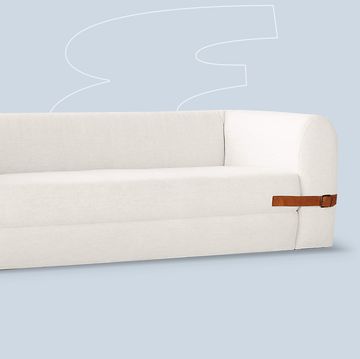
The 11 Best Bongs for Smoother Smoking

The Only 5 PC Gaming Controllers Worth Your Money

The 18 Best Places to Shop for Outdoor Furniture

23 Great Mother's Day Gifts She Really Wants
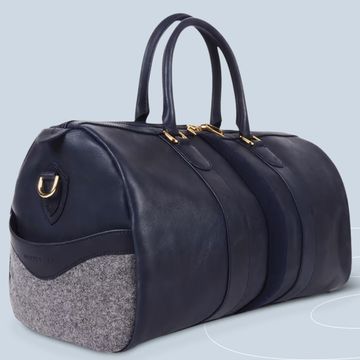
Who Knew Bespoke Post’s Sale Section Was This Good
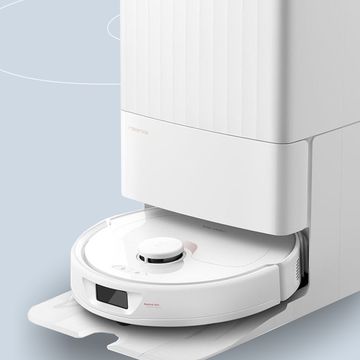
The 4 Best Robot Mops for a Hassle-Free Life

75 Foolproof Gifts Your Wife Won’t Return
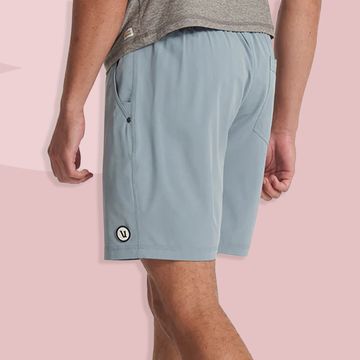
The 22 Best Gym Shorts for Men

The Best Swimsuits for All Your Aquatic Adventures
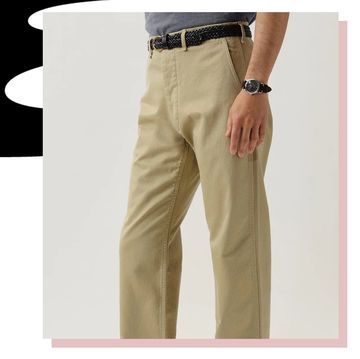
The 20 Best Khaki Pants Are More Than Just Chinos
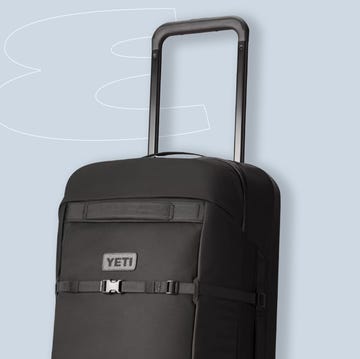
The 12 Best Checked Luggage Pieces for Traveling
- India Today
- Business Today
- Reader’s Digest
- Harper's Bazaar
- Brides Today
- Cosmopolitan
- Aaj Tak Campus
- India Today Hindi
Three Indians killed in US as car crashes after flying 20 feet over bridge
The vehicle jumped over four lanes and flew 20 feet into the air before crashing into trees in greenville county..
Listen to Story

- The three women were from Borsad tehsil of Gujarat's Anand district
- Wreckage of the vehicle found shattered in multiple pieces
- Police says SUV was travelling above posted speed limit
Three Indian women from Gujarat died in an accident in the United States after their overspeeding vehicle lost control, rammed into a divider, and flew 20 feet into the air before crashing into trees on the opposite side of a bridge. The incident happened on Interstate 85 in Greenville County, South Carolina.
The women have been identified as Rekhaben Dilipbhai Patel, Sangeetaben Bhaveshbhai Patel, and Manishaben Rajendrabhai Patel. They were from Borsad tehsil of Anand district.
The wreckage of the vehicle was found wedged against a tree, shattered into multiple pieces.
"When the vehicle jumped all four lanes of traffic, it actually struck trees probably at least 20 feet above the ground," Chief Deputy Coroner Mike Ellis from the Greenville County Coroner's Office told foxcarolina.com.
"When you have got family, probably related, three deceased is nothing that you want to ever see," Ellis further said.
As per the report, the driver of the vehicle was taken to the hospital with injuries.
Ellis said the SUV was travelling above the posted speed limit. "Very seldom do you see a vehicle that leaves the roadway at such a high rate of speed that it jumps 4–6 lanes of traffic and lands in the trees approximately 20 feet," he further said.

IMAGES
VIDEO
COMMENTS
Step 2: Get your cat feeling comfortable in the car. Now that your kitty feels better in their carrier, it's time to help them feel comfortable in the car. Here are some steps to help you do that. Pro Tip: Car acclimation is best done with two people … one to drive the car, the other to pet, praise, and treat kitty.
8 Tips for Cat Car Travel . For safety's sake, it is recommended that kittens and cats ride inside a carrier while in the car. A loose pet becomes a furry projectile in case of an accident. The driver needs to concentrate on the road and traffic, not the baby on your lap or under the pedals. Even well-behaved cats loose in the car could be ...
The 11 Tips & Tricks for Car Travel with a Cat. 1. Always Use a Cat Carrier. Photo Credit: alenka2194, Shutterstock. Never take your cat anywhere in the car without using a cat carrier. Not only ...
Once your cat is used to her carrier, place her inside, close it, and walk around the house with her. Be sure to reward her with a treat when she exits. Remember, the carrier must be a happy space. Once she is comfortable with an in-house walkabout, move her to the travel vehicle. Start the vehicle, run the engine for a bit, then take her back ...
2. Get Them Used To Their Carrier Ahead Of Time. A cat's carrier should be their safe space. You want them to be used to the carrier before ever bringing them into the car in it. To do this, leave the carrier out in the house for your cat to constantly use. At the start, I left treats inside for my cat to find.
3. Car Seat Cover. A car seat cover is the best way to keep your car clean and free of pet hair, kitty puke, muddy paws, and anything else your cat drags in. 4. Calming Medication. "If your cat is prone to motion sickness or anxiety, talk to your vet because they may recommend medications that can help," McNee says.
Start young: Kittens usually adjust to new experiences and surroundings more easily than an adult or senior cats, so start the travel-training process as early as possible. If your cat is past kittenhood, don't worry: Adult and senior cats can still learn to tolerate car rides. Rule out motion sickness: If your cat already has difficulty ...
Below is a checklist of items we suggest taking with you when traveling with one cat (increase quantities as needed for multiple cats). Food and snacks/treats. Fresh water, preferably bottled or brought from home. Bowls (2) Clean cat litter. Clean litter pan. Brush or grooming tools. Any medications. Pet first-aid kit.
1. Have the necessities handy and easy to reach. Most of your luggage will be fine in the trunk or back of your car, but you'll want to have a bag of your cat's necessities within easy reach. Things like water, treats, medication, pee pads, etc. - anything you might need immediate access to while on the road. 2.
The 14 Tips to Travel with a Cat 1. Invest in a Good Carrier. Cats should always be restrained when riding in cars, and airports require them to stay in their carriers at all times (except during ...
Amtrak launched a program to allow service dogs on its trains in 2016 and has since expanded to allow pet cats and dogs. Service animals are allowed on any train and can accompany the owner throughout the train, and they travel for free. Reservations should be made by calling 1-800-USA-RAIL (1-800-872-7245) in advance.
9. Pack your cat's litter box, filled with clean litter. Cat's have an amazing ability to hold in their urge to go to the bathroom. That being said, sometimes the urge can be overwhelming and your cat will need to use the litter box on the road, particularly if you are road tripping long distance.
1. Gather supplies in your car. When traveling with your cat, you will need to bring along a variety of supplies. These supplies include items that you will use in the car and items you will use when you take breaks and when you get to your destination. Supplies you will need include: Pet carrier/kennel.
Cat car travel litter box vs cat carrier for the car . There are pros and cons for both a travel litter box and a carrier for the car. If you don't want to stop as often when traveling with a cat, you'll need a travel litterbox, but you may not like the idea of having your cat do their business in the car.
Whether you're planning on traveling by train, plane, or car, your kittens will likely spend several hours in a carrier, so plan to give them time to get used to their travel accommodations.
Acclimate your cat to traveling. If your cat hasn't travelled by car recently, several weeks prior to your trip, take it on several short car rides (30 minutes or less). Be sure to put the cat in the travel cage you will use on your trip to get the cat used to the noise and motion of the car and the smell of the cage. Give your cat treats ...
The things to do when traveling with your cat include: Make sure to purchase a comfortable carrier for your cat to help sequester them in a cozy yet confined space. Letting a cat roam freely in the car can be dangerous for you and them. If your cat is in the confinement of a cat carrier and has a bio-accident, the odor will likely permeate both ...
Traveling with a Cat in the Car. Bringing your cat with you in the car is similar to how they would travel with you on an airplane, but there are a couple things specific to road trips to keep in mind. Secure Cats in the Car. Never under any circumstance should someone drive with a cat on their lap or roaming freely around the car. A carrier or ...
Once you have an excellent carrier, initiate a low-stress introduction, leaving it out as a bed before making any connections with the car, the vet, or vacation. Use treats to encourage your cat to explore the carrier. 2. Start Preparing Early. Successful travel with your cat starts long before you leave the driveway.
Fees for flying with a pet in the cabin of a plane vary between carriers. At United Airlines, a one-way flight for your cat adds $125 to your ticket price. At Delta, there is a $95 fee for ...
Everything You Need to Know About Cat Transport & Travel. Whether you're preparing for a permanent move, temporary move, or short-term trip across the US or the globe, figuring out how to arrange safe cat transport can be confusing and overwhelming. Cat relocation can be complicated, particularly if it involves an international destination ...
Research the costs of travel crates beforehand, and don't forget to purchase two water bowls to attach to the door! Example Estimate: A medium PetMate Sky Kennel, what most airlines consider to be the best size for cats traveling in cargo, can cost anywhere between $50 USD and $200 USD. Finley moved to Australia with our assistance. Vet Visits
Walking tour around Moscow-City.Thanks for watching!MY GEAR THAT I USEMinimalist Handheld SetupiPhone 11 128GB https://amzn.to/3zfqbboMic for Street https://...
A 16-year-old boy will face animal cruelty charges after he allegedly killed a cat by throwing out of the window of a moving car Monday night near Brimfield.. The Peoria County State's Attorney's ...
11. Petprsco Large Soft Cat Carrier with Washable Pad. This Petprsco Large Cat Carrier is versatile and convenient for transporting your pet. It is a perfect product for car travel as it contains ...
Nearly 50 cats were rescued from a hot car. Now one is a Target model. Jill LeBrun was stunned and delighted to see her rescue pet's image plastered on buckets of cat litter at Target
The city of Dubai was hit with a year's worth of rain in just 24 hours, and one little cat got caught in the flooding that had people abandoning their cars in the middle of the street. Watch ...
The best travel stroller out there for the urban denizens among us needs to be small and easy to maneuver—enter the Babyzen YOYO2. This zippy little thing is great for weaving through armies of ...
The vehicle jumped over four lanes and flew 20 feet into the air before crashing into trees in Greenville County. Listen to Story The three women were from Borsad tehsil of Gujarat's Anand district Wreckage of the vehicle found shattered in multiple pieces Police says SUV was travelling above posted ...
Talk about a long drive home. Londoner Pelumi Nubi drove alone for two months in a little Peugeot 107 from the UK capital to Lagos, Nigeria, which is her birthplace. After traveling through 17 ...